Paul van Yperen's Blog, page 238
April 11, 2019
A rare find: an album with Pathé cards from 1911
Tonight starts Europe’s biggest vintage event, the VerzamelaarsJaarbeurs, the International Collectors Fair in Utrecht, the Netherlands. Tomorrow we will visit the fair in the massive Jaarbeurs halls, searching for rare and interesting film star postcards to share with you at EFSP. Last fair, co-editor Ivo Blom was in Berlin, and I found an album for him with over 100 vintage cards by Pathé Cinema with stills of films from 1911. For today's post, Ivo selected 14 cards from this album, and he wrote the text below.
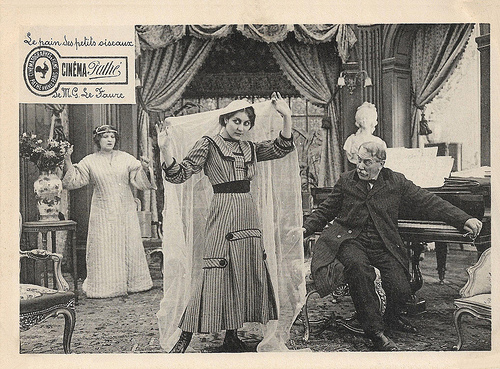
Big French photo card by Cinéma Pathé. Photo: Société Cinématographique des Auteurs et Gens Lettres (SCAGL). Stacia Napierkowska and Lucien Callamand in Le Pain des petits oiseaux (Albert Capellani, 1911).
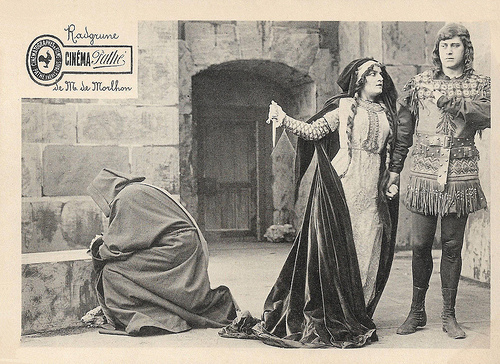
Big French photo card by Cinéma Pathé. Photo: SAPF. Madeleine Roch in the historical drama Radgrune (Camille de Morlhon, 1911).
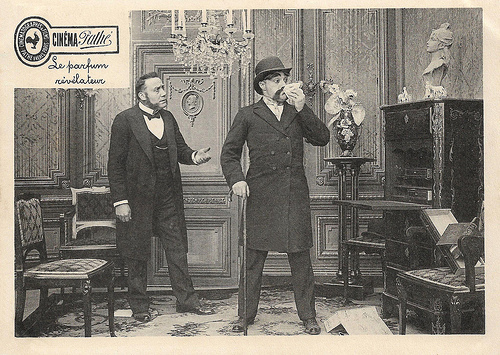
Big French photo card by Cinéma Pathé. Georges Vinter in Le Parfum révélateur (1911). Adaptation: Paul Garbagni.
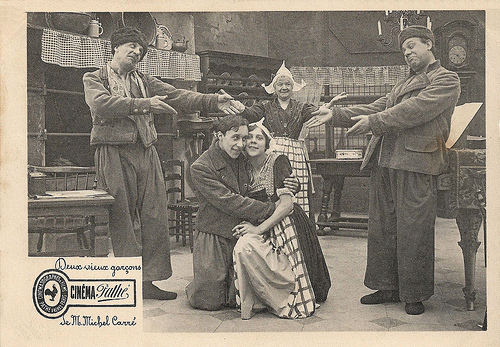
Big French photo card by Cinéma Pathé. Photo: SCAGL. Andrée Marly in Deux vieux garçons (Michel Carré, 1911).
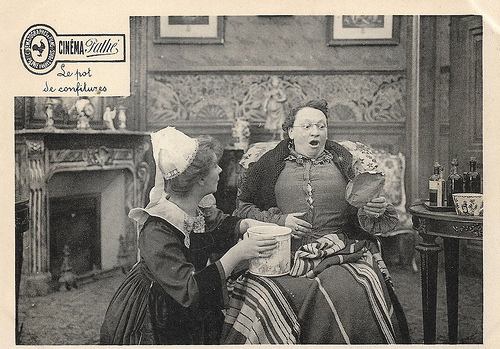
Big French photo card by Cinéma Pathé. Photo: SCAGL. Madeleine Guitty in Le Pot de confitures (Georges Denola, 1911).
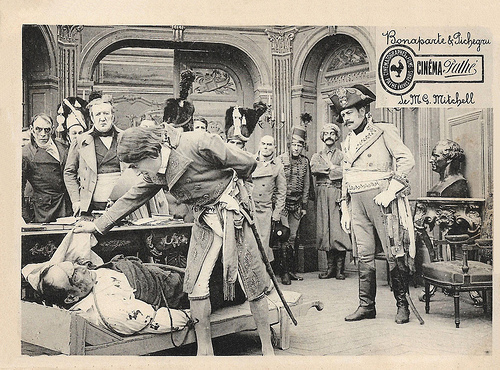
Big French photo card by Cinéma Pathé. Photo: SCAGL / SAPF. Publicity still for Bonaparte et Pichegru (Georges Denola, 1911).
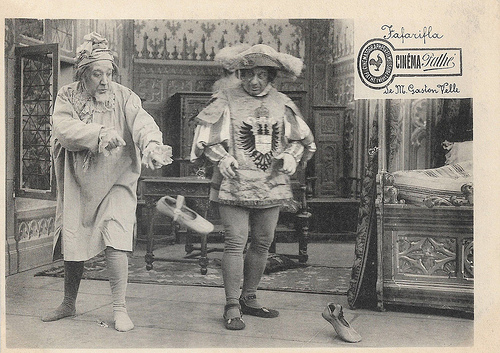
Big French photo card by Cinéma Pathé. Photo: publicity still for Fafrifla ou le fifre magique (Gaston Velle, 1911).
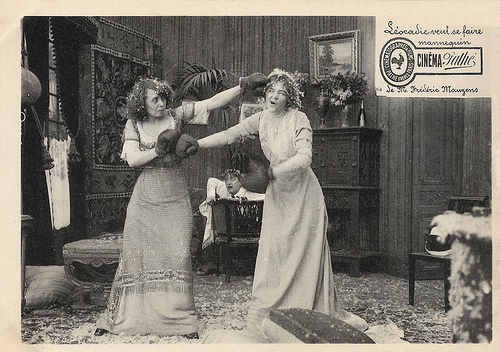
Big French photo card by Cinéma Pathé. Photo: SCAGL. Mistinguett in Léocadie veut se faire mannequin (1911). Script by Frédéric Mauzens.
Rare Treasure Trove
The album contains 60 double pages with 120 collector's cards, a bit bigger and thinner than the ordinary postcards issued by Pathé. All films date of the year 1911 and almost all are retraceable on the website of the Fondation Jerome Seydoux Pathé.
Most cards are made for French films by Pathé, sometimes for its subsidiaries Société Cinématographique des Auteurs et Gens Lettres (SCAGL) or Séries d'Art Pathé Frères (SAPF). Occasionally, cards were also published for films by its foreign studios such as American Kinema, Le Film Russe, and Film d'Arte Italiana (FAI).
The series ranges from modern and historical dramas - quite a few deal with Napoleon and his circle in particular - to comedy, fairy tales, and crime films, sometimes with famous dramatic actors such as Stacia Napierkowska , Léontine Massart and Jean Kemm, or comedians such as Max Linder , Prince , Sarah Duhamel, Mistinguett and Madeleine Guitty.
For certain titles - in particular for dramas, two or more cards have been issued and are now in the album. Often with the non-comical films a name is given which is mostly not the director but rather the scriptwriter. Thus for instance for a comedy such as Léocadie veut se faire mannequin we know it was scripted by Frédéric Mauzens, even when we don't know who directed the film.
We found this rare treasure trove at the 2018 Autumn Collector's Fair in Utrecht. The back of the album was heavily damaged, so we had it repaired by a professional book repairer. Still, the album should never be fully opened again, in order to avoid new damage onto its back.
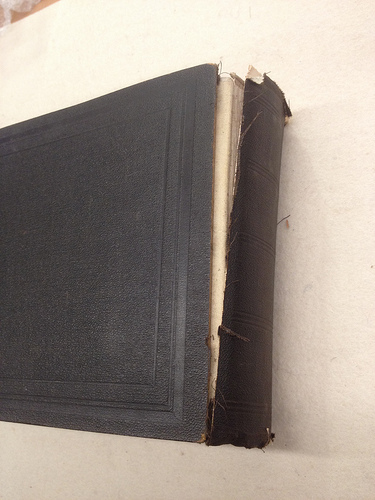
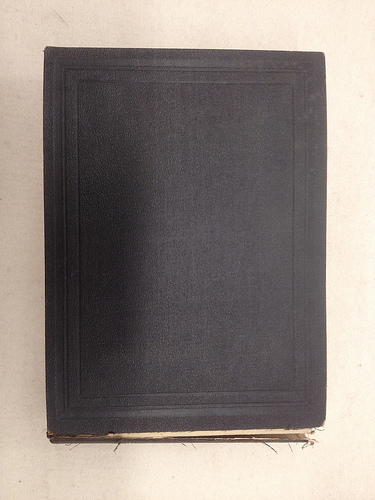
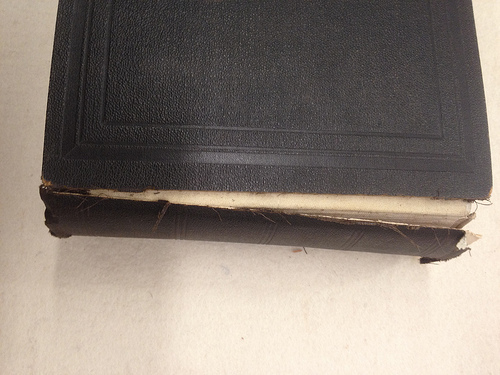
Details from the album by Pathé, published in 1911. Before the restoration. Collection: Ivo Blom.
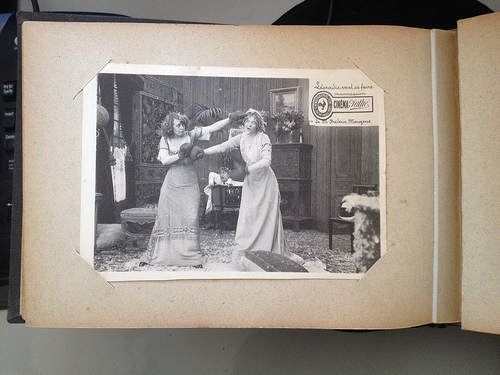
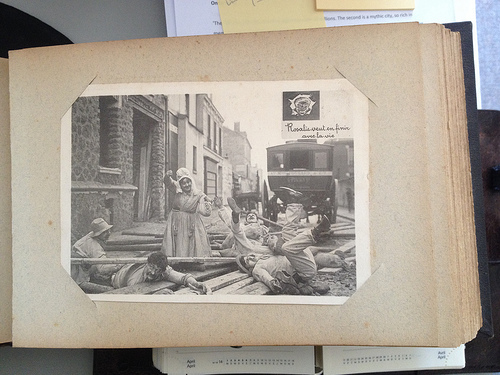
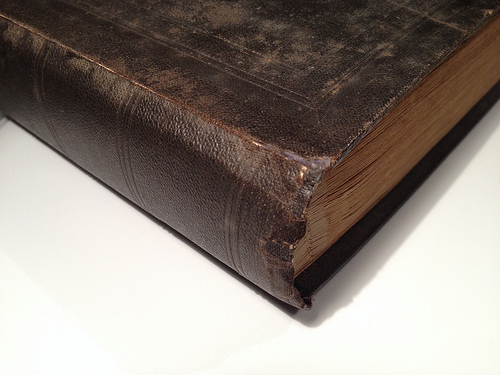
Details from the album by Pathé, published in 1911. After the restoration. Collection: Ivo Blom.

Big French photo card by Cinéma Pathé. Photo: Jacques Normand in Les victimes de l'alcool (Gérard Bourgeois, 1911).
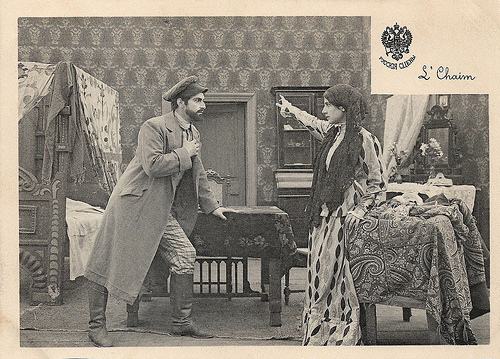
Big French photo card by Cinéma Pathé. Photo: Le Film Russe. Nicolaï Vassiliev in L'Chaïm (Maurice André Maître, Kaï Hansen, 1911).
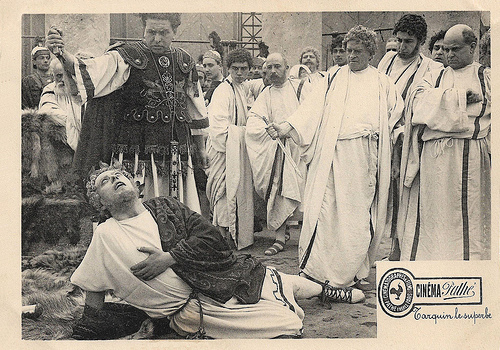
Big French photo card by Cinéma Pathé. Photo: FAI. Alfredo Robert in Tarquinio il superbo/Tarquin le superbe (1911).
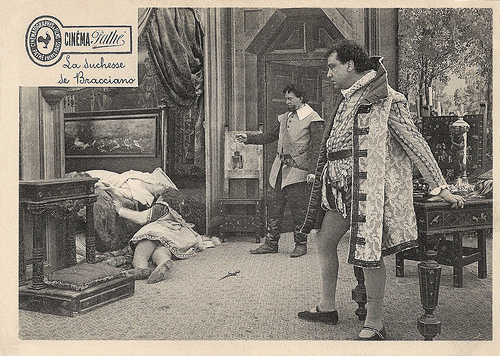
Big French photo card by Cinéma Pathé. Photo: FAI. Dillo Lombardi in La duchessa di Bracciano/La Duchesse de Bracciano (1911).
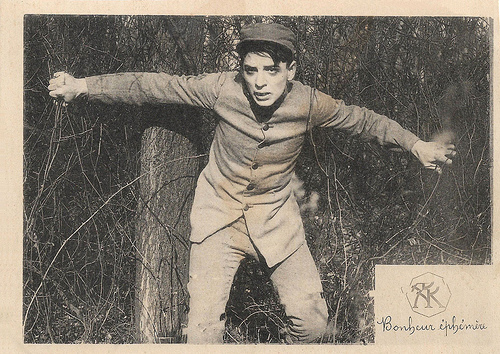
Big French photo card by Cinéma Pathé. Photo: American Kinema. Photo: Charles Arling in Short-Lived Happyness (1911). The French title is Le Bonheur éphémère.
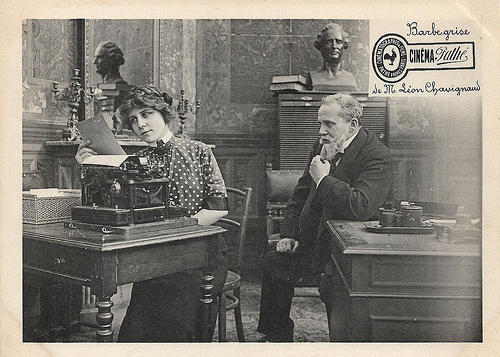
Big French photo card by Cinéma Pathé. Photo: publicity still for Barbegrise (Georges Monca, 1911) with Andrée Pascal. Script by Léon Chavignaud.
Source: Fondation Jerome Seydoux Pathé and IMDb.

Big French photo card by Cinéma Pathé. Photo: Société Cinématographique des Auteurs et Gens Lettres (SCAGL). Stacia Napierkowska and Lucien Callamand in Le Pain des petits oiseaux (Albert Capellani, 1911).

Big French photo card by Cinéma Pathé. Photo: SAPF. Madeleine Roch in the historical drama Radgrune (Camille de Morlhon, 1911).

Big French photo card by Cinéma Pathé. Georges Vinter in Le Parfum révélateur (1911). Adaptation: Paul Garbagni.

Big French photo card by Cinéma Pathé. Photo: SCAGL. Andrée Marly in Deux vieux garçons (Michel Carré, 1911).

Big French photo card by Cinéma Pathé. Photo: SCAGL. Madeleine Guitty in Le Pot de confitures (Georges Denola, 1911).

Big French photo card by Cinéma Pathé. Photo: SCAGL / SAPF. Publicity still for Bonaparte et Pichegru (Georges Denola, 1911).

Big French photo card by Cinéma Pathé. Photo: publicity still for Fafrifla ou le fifre magique (Gaston Velle, 1911).

Big French photo card by Cinéma Pathé. Photo: SCAGL. Mistinguett in Léocadie veut se faire mannequin (1911). Script by Frédéric Mauzens.
Rare Treasure Trove
The album contains 60 double pages with 120 collector's cards, a bit bigger and thinner than the ordinary postcards issued by Pathé. All films date of the year 1911 and almost all are retraceable on the website of the Fondation Jerome Seydoux Pathé.
Most cards are made for French films by Pathé, sometimes for its subsidiaries Société Cinématographique des Auteurs et Gens Lettres (SCAGL) or Séries d'Art Pathé Frères (SAPF). Occasionally, cards were also published for films by its foreign studios such as American Kinema, Le Film Russe, and Film d'Arte Italiana (FAI).
The series ranges from modern and historical dramas - quite a few deal with Napoleon and his circle in particular - to comedy, fairy tales, and crime films, sometimes with famous dramatic actors such as Stacia Napierkowska , Léontine Massart and Jean Kemm, or comedians such as Max Linder , Prince , Sarah Duhamel, Mistinguett and Madeleine Guitty.
For certain titles - in particular for dramas, two or more cards have been issued and are now in the album. Often with the non-comical films a name is given which is mostly not the director but rather the scriptwriter. Thus for instance for a comedy such as Léocadie veut se faire mannequin we know it was scripted by Frédéric Mauzens, even when we don't know who directed the film.
We found this rare treasure trove at the 2018 Autumn Collector's Fair in Utrecht. The back of the album was heavily damaged, so we had it repaired by a professional book repairer. Still, the album should never be fully opened again, in order to avoid new damage onto its back.



Details from the album by Pathé, published in 1911. Before the restoration. Collection: Ivo Blom.



Details from the album by Pathé, published in 1911. After the restoration. Collection: Ivo Blom.

Big French photo card by Cinéma Pathé. Photo: Jacques Normand in Les victimes de l'alcool (Gérard Bourgeois, 1911).

Big French photo card by Cinéma Pathé. Photo: Le Film Russe. Nicolaï Vassiliev in L'Chaïm (Maurice André Maître, Kaï Hansen, 1911).

Big French photo card by Cinéma Pathé. Photo: FAI. Alfredo Robert in Tarquinio il superbo/Tarquin le superbe (1911).

Big French photo card by Cinéma Pathé. Photo: FAI. Dillo Lombardi in La duchessa di Bracciano/La Duchesse de Bracciano (1911).

Big French photo card by Cinéma Pathé. Photo: American Kinema. Photo: Charles Arling in Short-Lived Happyness (1911). The French title is Le Bonheur éphémère.

Big French photo card by Cinéma Pathé. Photo: publicity still for Barbegrise (Georges Monca, 1911) with Andrée Pascal. Script by Léon Chavignaud.
Source: Fondation Jerome Seydoux Pathé and IMDb.
Published on April 11, 2019 22:00
April 10, 2019
Les Mystères de New York (1915)
The French serial Les Mystères de New York/The Mysteries of New York (1915) is an oddity. In fact it is a European re-edition of three American serials, starring Pearl White: The Exploits of Elaine (1914), The New Exploits of Elaine (1915) and The Romance of Elaine (1915). These three serials were based on books by Pierre Decourcelle, and produced in 1914-1915 for Pathé Exchange for its film version and for William Hearst for its press version.
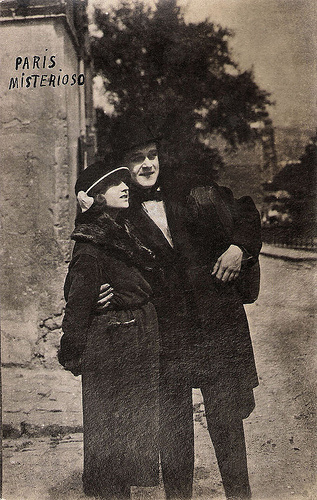
Spanish postcard by PA Cines. Photo: publicity still for Paris misterioso, the Spanish title for Les Mystères de New York (1915) with Pearl White and Riley Hatch.
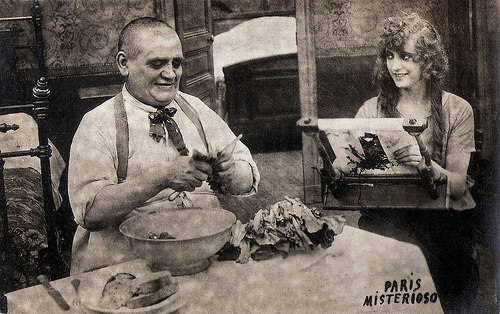
Spanish postcard for Paris misterioso, the Spanish title for Les Mystères de New York (1915) with Pearl White and Riley Hatch.
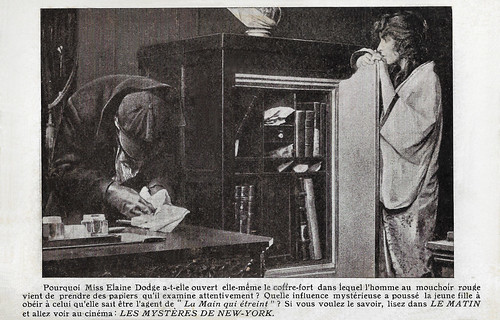
French postcard for Les Mystères de New York. Caption: Why did Miss Elaine Dodge herself open the safe in which the man with the red handkerchief has just taken papers that he examines carefully? What mysterious influence led the girl to obey the one she knows to be an agent of 'The Clutching Hand'? If you want to know, read in Le Matin, or see in the cinema: 'The Mysteries of New York'.
The serial queen to beat
American silent film star Pearl White (1889-1938) was dubbed 'Queen of the Serials". She was noted for doing her own stunts, in silent film serials such as The Perils of Pauline (1914) and The Exploits of Elaine (Louis J. Gasnier, George B. Seitz, Leopold Wharton, Theodore Wharton, 1914). George B. Seitz was an early serial expert who is today perhaps better known for directing the Andy Hardy-series (1937-1944) with Mickey Rooney .
Many episodes ended with a literal cliffhanger with Elaine in some physical peril or confronted with a shocking revelation. For example, at the close of Chapter 10 Elaine actually dies. She is then brought back to life in the next chapter by private detective Craig Kennedy (Arnold Daly).
In Europe, The Exploits of Elaine (Louis J. Gasnier, George B. Seitz, Leopold Wharton, Theodore Wharton, 1914) were re-edited with two subsequent serials into Les Mystères de New York. These two other serials were The New Exploits of Elaine (Louis J. Gasnier, Leopold Wharton, Theodore Wharton, 1915) and The Romance of Elaine (George B. Seitz, Leopold Wharton, Theodore Wharton, 1915), all starring Pearl White.
The Exploits of Elaine (1914) tells the story of a young woman named Elaine (Pearl White) who, with the help of a detective, Justin Clarel (Arnold Daly), tries to find the masked criminal mastermind, known only as 'The Clutching Hand' (Sheldon Lewis), who murdered her father (William Riley Hatch). The Clutching Hand was the first mystery villain to appear in a film serial. The concept was widely used for the remainder of the format's existence.
Other actors in the cast were Creighton Hale and Lionel Barrymore, who had a small role. The serials were produced by the Whartons Studios in and around Ithaca, New York. The serial was distributed by Pathé Exchange, the American distribution branch of the French company Pathé at that time. Pathé was the largest film equipment and production company in the world during the first part of the 20th century.
Hans J. Wollstein at AllMovie : "Although not as remembered as The Perils of Pauline (also 1914), The Exploits of Elaine was by all accounts the superior serial, grossing over $1 million dollars and further establishing its athletic leading lady Pearl White as the serial queen to beat."
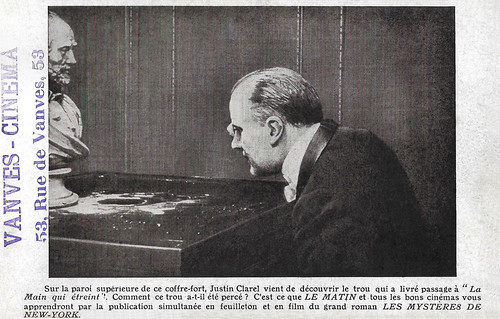
French postcard for Les Mystères de New York. Caption: On the top side of this safe, Justin Clarel has just discovered the hole that has given passage to 'The Clutching Hand'. This is what Le Matin and all the good cinemas will teach you by simultaneous serialisation in the newspaper and in film of the great novel 'The Mysteries of New York'.
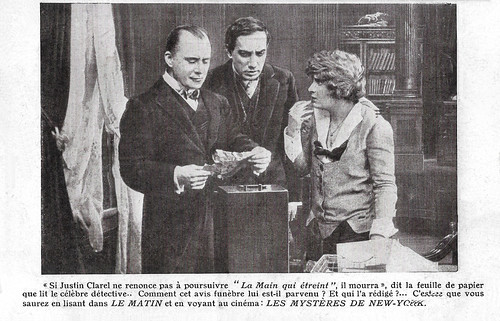
French postcard for Les Mystères de New York. Caption: "If Justin Clarel does not give up pursuing 'The Clutching Hand', he will die", says the sheet of paper which the famous detective reads. How did this funeral notice come to him? And who wrote it? You'll know it when you read in Le Matin and see in the cinema: 'The Mysteries of New York'.
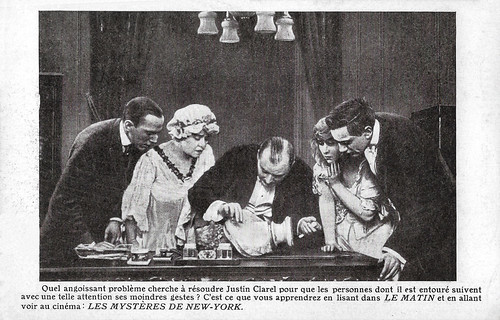
French postcard for Les Mystères de New York. Caption: What distressing problem Justin Clarel is trying to solve so that the people with whom he is surrounded follow with such attention his least gestures? That's what you learn when you read in Le Matin or see in the cinema: 'The Mysteries of New York'.
Sources: Hans J. Wollstein (AllMovie), Wikipedia and IMDb.

Spanish postcard by PA Cines. Photo: publicity still for Paris misterioso, the Spanish title for Les Mystères de New York (1915) with Pearl White and Riley Hatch.

Spanish postcard for Paris misterioso, the Spanish title for Les Mystères de New York (1915) with Pearl White and Riley Hatch.

French postcard for Les Mystères de New York. Caption: Why did Miss Elaine Dodge herself open the safe in which the man with the red handkerchief has just taken papers that he examines carefully? What mysterious influence led the girl to obey the one she knows to be an agent of 'The Clutching Hand'? If you want to know, read in Le Matin, or see in the cinema: 'The Mysteries of New York'.
The serial queen to beat
American silent film star Pearl White (1889-1938) was dubbed 'Queen of the Serials". She was noted for doing her own stunts, in silent film serials such as The Perils of Pauline (1914) and The Exploits of Elaine (Louis J. Gasnier, George B. Seitz, Leopold Wharton, Theodore Wharton, 1914). George B. Seitz was an early serial expert who is today perhaps better known for directing the Andy Hardy-series (1937-1944) with Mickey Rooney .
Many episodes ended with a literal cliffhanger with Elaine in some physical peril or confronted with a shocking revelation. For example, at the close of Chapter 10 Elaine actually dies. She is then brought back to life in the next chapter by private detective Craig Kennedy (Arnold Daly).
In Europe, The Exploits of Elaine (Louis J. Gasnier, George B. Seitz, Leopold Wharton, Theodore Wharton, 1914) were re-edited with two subsequent serials into Les Mystères de New York. These two other serials were The New Exploits of Elaine (Louis J. Gasnier, Leopold Wharton, Theodore Wharton, 1915) and The Romance of Elaine (George B. Seitz, Leopold Wharton, Theodore Wharton, 1915), all starring Pearl White.
The Exploits of Elaine (1914) tells the story of a young woman named Elaine (Pearl White) who, with the help of a detective, Justin Clarel (Arnold Daly), tries to find the masked criminal mastermind, known only as 'The Clutching Hand' (Sheldon Lewis), who murdered her father (William Riley Hatch). The Clutching Hand was the first mystery villain to appear in a film serial. The concept was widely used for the remainder of the format's existence.
Other actors in the cast were Creighton Hale and Lionel Barrymore, who had a small role. The serials were produced by the Whartons Studios in and around Ithaca, New York. The serial was distributed by Pathé Exchange, the American distribution branch of the French company Pathé at that time. Pathé was the largest film equipment and production company in the world during the first part of the 20th century.
Hans J. Wollstein at AllMovie : "Although not as remembered as The Perils of Pauline (also 1914), The Exploits of Elaine was by all accounts the superior serial, grossing over $1 million dollars and further establishing its athletic leading lady Pearl White as the serial queen to beat."

French postcard for Les Mystères de New York. Caption: On the top side of this safe, Justin Clarel has just discovered the hole that has given passage to 'The Clutching Hand'. This is what Le Matin and all the good cinemas will teach you by simultaneous serialisation in the newspaper and in film of the great novel 'The Mysteries of New York'.

French postcard for Les Mystères de New York. Caption: "If Justin Clarel does not give up pursuing 'The Clutching Hand', he will die", says the sheet of paper which the famous detective reads. How did this funeral notice come to him? And who wrote it? You'll know it when you read in Le Matin and see in the cinema: 'The Mysteries of New York'.

French postcard for Les Mystères de New York. Caption: What distressing problem Justin Clarel is trying to solve so that the people with whom he is surrounded follow with such attention his least gestures? That's what you learn when you read in Le Matin or see in the cinema: 'The Mysteries of New York'.
Sources: Hans J. Wollstein (AllMovie), Wikipedia and IMDb.
Published on April 10, 2019 22:00
April 9, 2019
Hintertreppe (1921)
Hintertreppe/Backstairs (Leopold Jessner, Paul Leni, 1921) is an early example of the German Kammerspiel film. Henny Porten, Wilhelm Dieterle and Fritz Kortner played the lead roles. Henny Porten's film company produced the film.
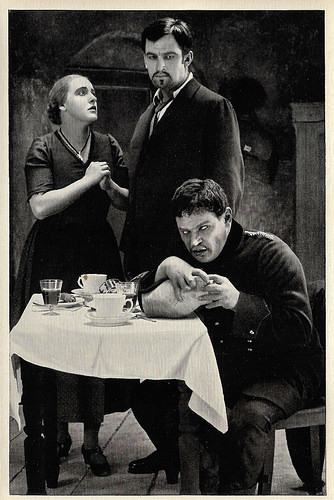
German collectors card by Ross Verlag in the series Vom Werden Deutscher Filmkunst - Der Stumme Film, picture no. 102. Photo: Ufa. Publicity still for Hintertreppe/Backstairs (Leopold Jessner, Paul Leni, 1921) with Henny Porten , Wilhelm Dieterle and Fritz Kortner .
Intercepting the letters of two lovers
In Hintertreppe/Backstairs (Leopold Jessner, Paul Leni, 1921), Henny Porten plays a maid to a rich family who lives in one of the city's poor neighbourhoods. Every evening she meets her handsome, young lover ( Wilhelm Dieterle ) at the door of the backstairs of her house.
The two are regularly observed by the crippled postman ( Fritz Kortner ) living in the basement, who secretly loves the girl. Desperate to win her love, he begins to intercept the letters the two lovers send to each other and replaces them with his own messages, which each thinks is from the other.
His plan seems to be succeeding, but then something happens that bring tragic results to them all. One day she waits in vain for her lover, his letters are also missing.
The postman brings her a letter in which her lover assures her of his love. Full of exuberance to thank him, she brings the postman a pitcher with punch in his basement apartment. She then realises that he had written the letter to comfort her.
Believing her lover has forgotten her, she finally turns to the postman. They have their romance. When she awaits him for dinner, the former lover returns unexpectedly. He was in the hospital and his mail did not arrive - the postman, namely, had embezzled her out of jealousy. A dispute between the postman and the lover starts, but the maid cannot enter the room, so she cries for help.
When the neighbours break down the door, they see the postman with an axe in his hand and the dead lover at his feet. Because of the scandal, the maid loses her position. She climbs up to the roof of the house and jumps to her death.
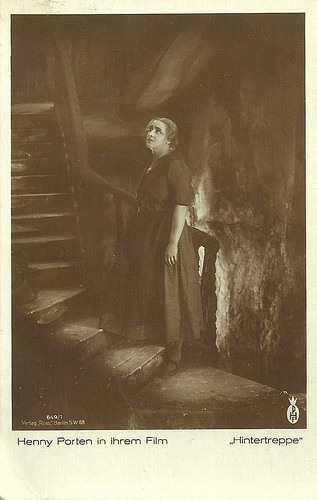
German postcard by Ross Verlag, no. 649/1. Photo: Henny Porten-Film. Henny Porten in Hintertreppe/Backstairs (Leopold Jessner, Paul Leni, 1921).
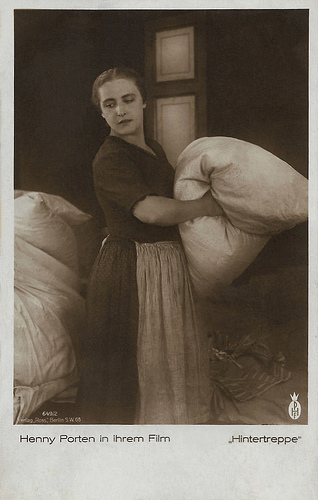
German postcard by Ross Verlag, no. 649/2. Photo: Henny Porten-Film. Henny Porten in Hintertreppe/Backstairs (Leopold Jessner, Paul Leni, 1921).
A very remarkable year for European cinema
Hintertreppe/Backstairs (Leopold Jessner, 1921) is one of the first examples of the Kammerspielfilm (Chamber Drama), a German silent film genre which had the heightened sense of reality at its centre. According to IMDb , the film was co-directed by Leopold Jessner and Paul Leni.
Aside from Max Reinhardt, Leopold Jessner was considered the most-advanced director in the German theatre. He was the director of the Berlin Staatstheater. The hallmark of his stage productions was the use of stairs, and his critics coined the word, 'Jessnertreppin', as a short-club to beat him with in their newspaper reviews.
In Hintertreppe, his only film, Jessner uses stairs to dramatise both the social status of the characters and their emotional relationships. For the greater part of the film, only three people are seen, and the lighting seems to come from within the characters and is used to convey the sense of isolation. A highlight is the stage-expressionist performance by Fritz Kortner under the direction of Jessner.
Paul Leni and Karl Görge were the art directors of the film and their image-filling buildings by Paul Leni and Karl Görge, especially the narrow, angled backstairs and the towering, barely light-emitting house fronts are also responsible for the expressionistic look of the film.
The Austrian Carl Mayer scriptwriter was also the author of Das Cabinet des Dr. Caligari/The Cabinet of Dr. Caligari (Robert Wiene, 1920), the prime example of German Expressionist horror. But for Hintertreppe, he turned away from the fantastic and towards realism. He did it for the second time, after his script for another Kammerspielfilm Scherben/Shattered (Lupu Pick, 1921).
On 11 December 1921, Hintertreppe had its world premiere in the Berlin U.T. Kurfürstendamm. Teviewer Kekseka at IMDb : "The film has a small set, virtually no titles, only three actors for most of its length but there is a great freedom allowed to the spectator to construct for him of herself the context of the action, a context that lives in the various inanimate objects that represent a presence of others never seen (the shoes, the plates, the glassware, the table-setting, the flowers, the punch) as well as in the Chinese shadows occasionally seen in the room(s) beyond.
The famous stairs are not the only powerful symbol. Another is the small half-moon shaped barred window for which, as far as I know there is no word in English but which s called in French a 'soupirail' and is a feature to basement flats throughout Continental Europe and will turn up as commonly as the backstairs in the films of the period.
It is one of the great films of the year which also saw Lang's Der müde Tod, Lubitsch's Die Bergkatze, Pick's Scherben, Murnau's Der Gang in der nacht, Buchetowski's Sappho, Carl Theodor Dreyer's Blade af Satans Bog, Feyder's L'Atlantide, the Asta Nielsen Hamlet, Sjöström's Phantom Carriage, Stiller's Johan. Altogether a very remarkable year for European cinema."
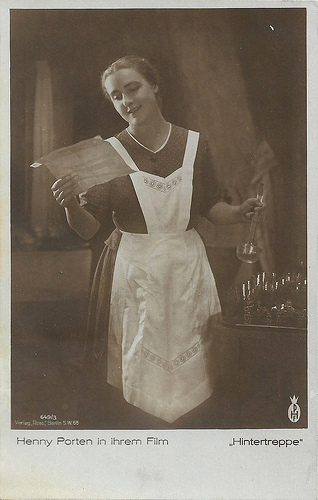
German postcard by Ross Verlag, no. 649/3. Photo: Henny Porten-Film. Henny Porten in Hintertreppe/Backstairs (Leopold Jessner, Paul Leni, 1921).
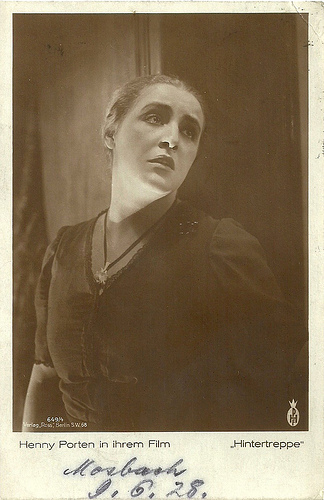
German postcard by Ross Verlag, no. 649/4. Photo: Henny Porten-Film. Henny Porten in Hintertreppe/Backstairs (Leopold Jessner, Paul Leni, 1921).
Sources: Kekseka (IMDb), Wikipedia and IMDb.

German collectors card by Ross Verlag in the series Vom Werden Deutscher Filmkunst - Der Stumme Film, picture no. 102. Photo: Ufa. Publicity still for Hintertreppe/Backstairs (Leopold Jessner, Paul Leni, 1921) with Henny Porten , Wilhelm Dieterle and Fritz Kortner .
Intercepting the letters of two lovers
In Hintertreppe/Backstairs (Leopold Jessner, Paul Leni, 1921), Henny Porten plays a maid to a rich family who lives in one of the city's poor neighbourhoods. Every evening she meets her handsome, young lover ( Wilhelm Dieterle ) at the door of the backstairs of her house.
The two are regularly observed by the crippled postman ( Fritz Kortner ) living in the basement, who secretly loves the girl. Desperate to win her love, he begins to intercept the letters the two lovers send to each other and replaces them with his own messages, which each thinks is from the other.
His plan seems to be succeeding, but then something happens that bring tragic results to them all. One day she waits in vain for her lover, his letters are also missing.
The postman brings her a letter in which her lover assures her of his love. Full of exuberance to thank him, she brings the postman a pitcher with punch in his basement apartment. She then realises that he had written the letter to comfort her.
Believing her lover has forgotten her, she finally turns to the postman. They have their romance. When she awaits him for dinner, the former lover returns unexpectedly. He was in the hospital and his mail did not arrive - the postman, namely, had embezzled her out of jealousy. A dispute between the postman and the lover starts, but the maid cannot enter the room, so she cries for help.
When the neighbours break down the door, they see the postman with an axe in his hand and the dead lover at his feet. Because of the scandal, the maid loses her position. She climbs up to the roof of the house and jumps to her death.

German postcard by Ross Verlag, no. 649/1. Photo: Henny Porten-Film. Henny Porten in Hintertreppe/Backstairs (Leopold Jessner, Paul Leni, 1921).

German postcard by Ross Verlag, no. 649/2. Photo: Henny Porten-Film. Henny Porten in Hintertreppe/Backstairs (Leopold Jessner, Paul Leni, 1921).
A very remarkable year for European cinema
Hintertreppe/Backstairs (Leopold Jessner, 1921) is one of the first examples of the Kammerspielfilm (Chamber Drama), a German silent film genre which had the heightened sense of reality at its centre. According to IMDb , the film was co-directed by Leopold Jessner and Paul Leni.
Aside from Max Reinhardt, Leopold Jessner was considered the most-advanced director in the German theatre. He was the director of the Berlin Staatstheater. The hallmark of his stage productions was the use of stairs, and his critics coined the word, 'Jessnertreppin', as a short-club to beat him with in their newspaper reviews.
In Hintertreppe, his only film, Jessner uses stairs to dramatise both the social status of the characters and their emotional relationships. For the greater part of the film, only three people are seen, and the lighting seems to come from within the characters and is used to convey the sense of isolation. A highlight is the stage-expressionist performance by Fritz Kortner under the direction of Jessner.
Paul Leni and Karl Görge were the art directors of the film and their image-filling buildings by Paul Leni and Karl Görge, especially the narrow, angled backstairs and the towering, barely light-emitting house fronts are also responsible for the expressionistic look of the film.
The Austrian Carl Mayer scriptwriter was also the author of Das Cabinet des Dr. Caligari/The Cabinet of Dr. Caligari (Robert Wiene, 1920), the prime example of German Expressionist horror. But for Hintertreppe, he turned away from the fantastic and towards realism. He did it for the second time, after his script for another Kammerspielfilm Scherben/Shattered (Lupu Pick, 1921).
On 11 December 1921, Hintertreppe had its world premiere in the Berlin U.T. Kurfürstendamm. Teviewer Kekseka at IMDb : "The film has a small set, virtually no titles, only three actors for most of its length but there is a great freedom allowed to the spectator to construct for him of herself the context of the action, a context that lives in the various inanimate objects that represent a presence of others never seen (the shoes, the plates, the glassware, the table-setting, the flowers, the punch) as well as in the Chinese shadows occasionally seen in the room(s) beyond.
The famous stairs are not the only powerful symbol. Another is the small half-moon shaped barred window for which, as far as I know there is no word in English but which s called in French a 'soupirail' and is a feature to basement flats throughout Continental Europe and will turn up as commonly as the backstairs in the films of the period.
It is one of the great films of the year which also saw Lang's Der müde Tod, Lubitsch's Die Bergkatze, Pick's Scherben, Murnau's Der Gang in der nacht, Buchetowski's Sappho, Carl Theodor Dreyer's Blade af Satans Bog, Feyder's L'Atlantide, the Asta Nielsen Hamlet, Sjöström's Phantom Carriage, Stiller's Johan. Altogether a very remarkable year for European cinema."

German postcard by Ross Verlag, no. 649/3. Photo: Henny Porten-Film. Henny Porten in Hintertreppe/Backstairs (Leopold Jessner, Paul Leni, 1921).

German postcard by Ross Verlag, no. 649/4. Photo: Henny Porten-Film. Henny Porten in Hintertreppe/Backstairs (Leopold Jessner, Paul Leni, 1921).
Sources: Kekseka (IMDb), Wikipedia and IMDb.
Published on April 09, 2019 22:00
April 8, 2019
Nadja Regin (1931-2019)
On 7 April, Serbian actress Nadja Regin (1931-2019) passed away. She started her career in Yugoslav-German co-productions and later she worked in Germany, Austria and New Zealand. In England, she guest-starred in many classic TV series of the 1960s and she appeared opposite Sean Connery in two James Bond films. She was 87.
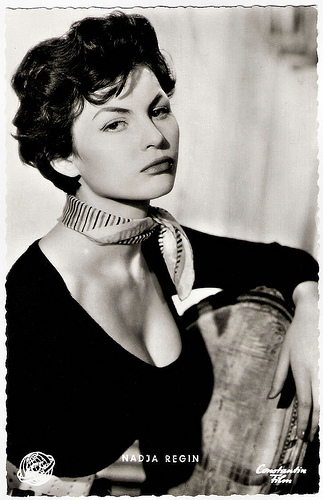
German postcard by Kunst und Bild, Berlin-Charlottenburg, no. I 240. Photo: A. Grimm / CCC / Constantin. Publicity stll for Die Unschuld vom Lande/The Country Wife (Rudolf Schündler, 1957).
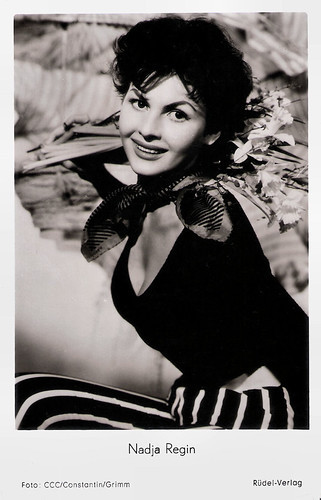
German postcard by Rüdel-Verlag, Hamburg-Bergedorf, no. 2040. Photo: CCC / Constantin / Arthur Grimm. Nadja Regin in Die Unschuld vom Lande/The Country Wife (Rudolf Schündler, 1957).
The Man without a Body
Nadja Regin was born as Nadezda Poderegin in Niš, Serbia in 1931. She graduated from the Academy of Dramatic Arts in Belgrade and also the University of Belgrade's Faculty of Philosophy.
Her acting career began during her student years with small parts in Yugoslavian films like Prica o fabrici/The Factory Story (Vladimir Pogacic, 1949). She also appeared in the first film ever made in Macedonia, Frosina (Vojislav Nanovic, 1952) with Meri Boskova.
Her career expanded through such Yugoslav-German co-productions as Das Haus an der Küste/The House on the Coast (Bosko Kosanovic, 1954) with René Deltgen , to Germany.
There she played supporting parts in films like the drama Roman eines Frauenarztes/Novel of a woman doctor (Falk Harnack, 1954) with Rudolf Prack , and the romance Auf Wiedersehen, Franziska!/Goodbye, Franziska (Wolfgang Liebeneiner, 1957) starring Ruth Leuwerik and Carlos Thompson .
Later, she moved to England, where she appeared in the horror film The Man without a Body (Charles Saunders, W. Lee Wilder, 1957). A scientist resuscitates the head of 16th-century seer Nostradamus by transplanting it onto the body of a man suffering from a brain tumour. He does it for the benefit of an avaricious financier who wants the prophet to give him the power of prediction in business...
In Don't Panic Chaps! (George Pollock, 1959), a British comedy set in WW II, she played an attractive young woman who set some forgotten soldiers on an Adriatic island back into a competitive, hostile attitude.
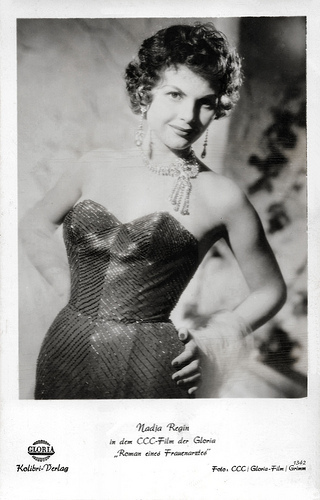
German postcard by Kolibri-Verlag, no. 1342. Photo: CCC / Constantin / Arthur Grimm. Nadja Regin in Roman eines Frauenarztes/Novel of a gynecologist (Falk Harnack, 1954).
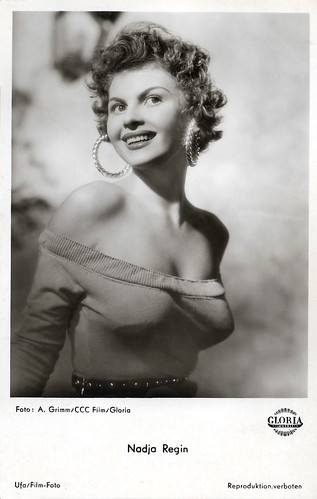
German postcard by Ufa/Film-Foto, no. I 240. Photo: A. Grimm / CCC Film / Gloria. Publicity stll for Roman eines Frauenarztes/Novel of a gynecologist (Falk Harnack, 1954).
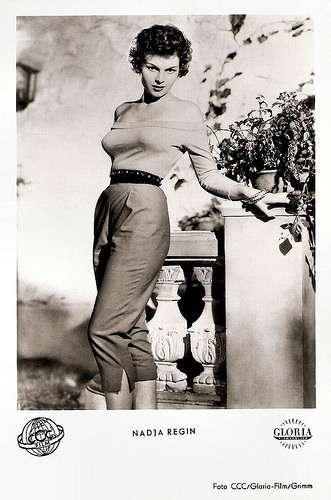
German postcard by Kunst und Bild, Berlin, no. A 1262. Photo: A. Grimm / CCC / Gloria.
Two James Bond films
Nadja Regin played the female lead in the thriller The Fur Collar (Lawrence Huntington, 1962) about an espionage ring.
She then acted in two James Bond films featuring Sean Connery . In the second James Bond film, From Russia with Love (Terence Young, 1963), she was the lonely mistress of Kerim Bey (Pedro Armendáriz).
She also appeared in a smaller but still notable appearance in the pre-credit sequence of the next James Bond film, Goldfinger (Guy Hamilton, 1964).
Her TV roles included The Invisible man (Peter Maxwell, 1959), Danger Man (1961-1964) featuring Patrick McGoohan , Maigret (1961) starring Rupert Davies, The Avengers (1961), The Edgar Wallace Mystery Theatre (1962-1964), The Third Man (1965), and The Saint (1967) with Roger Moore .
Notable was also her role in the New Zealand thriller Runaway/Runaway Killer (John O’Shea, 1964) with Colin Broadley and Kiri Te Kanawa. It was the first locally produced New Zealand film in 12 years.
In Austria she appeared in the TV series Donaug'schichten/Stories of the Danube (1966) with Willy Millowitsch and Christiane Hörbiger.
At the end of the 1960s her film acting career halted. In the 1970s she moved to Australia. Her work included reading and selecting film scripts for production by film companies including Rank Films and Hammer Films.
In 1980, she and her sister Jelena formed Honeyglen Publishing Ltd, a small publishing company, specialising in philosophy of history, belles lettres, biography and some fiction.
Nadja Regin later devoted her time to writing and wrote a novel, The Victims and the Fools, a children's story, The Puppet Planet, and worked on her memoirs.
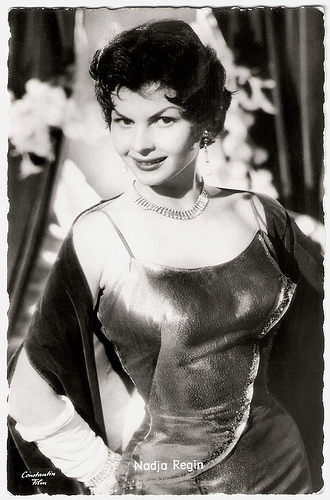
German postcard by Kolibri-Verlag, Minden/Westf., no. 2588. Photo: A. Grimm / CCC / Constantin. Publicity still for Die Unschuld vom Lande/The babe in the woods (Rudolf Schündler, 1957).
Trailer From Russia with Love (1963). Source: 86BillieJean (YouTube).
Official trailer Goldfinger (1964). Source: MOVIECLIPS Classic Trailers (YouTube).
Sources: AllMovie, Wikipedia and .

German postcard by Kunst und Bild, Berlin-Charlottenburg, no. I 240. Photo: A. Grimm / CCC / Constantin. Publicity stll for Die Unschuld vom Lande/The Country Wife (Rudolf Schündler, 1957).

German postcard by Rüdel-Verlag, Hamburg-Bergedorf, no. 2040. Photo: CCC / Constantin / Arthur Grimm. Nadja Regin in Die Unschuld vom Lande/The Country Wife (Rudolf Schündler, 1957).
The Man without a Body
Nadja Regin was born as Nadezda Poderegin in Niš, Serbia in 1931. She graduated from the Academy of Dramatic Arts in Belgrade and also the University of Belgrade's Faculty of Philosophy.
Her acting career began during her student years with small parts in Yugoslavian films like Prica o fabrici/The Factory Story (Vladimir Pogacic, 1949). She also appeared in the first film ever made in Macedonia, Frosina (Vojislav Nanovic, 1952) with Meri Boskova.
Her career expanded through such Yugoslav-German co-productions as Das Haus an der Küste/The House on the Coast (Bosko Kosanovic, 1954) with René Deltgen , to Germany.
There she played supporting parts in films like the drama Roman eines Frauenarztes/Novel of a woman doctor (Falk Harnack, 1954) with Rudolf Prack , and the romance Auf Wiedersehen, Franziska!/Goodbye, Franziska (Wolfgang Liebeneiner, 1957) starring Ruth Leuwerik and Carlos Thompson .
Later, she moved to England, where she appeared in the horror film The Man without a Body (Charles Saunders, W. Lee Wilder, 1957). A scientist resuscitates the head of 16th-century seer Nostradamus by transplanting it onto the body of a man suffering from a brain tumour. He does it for the benefit of an avaricious financier who wants the prophet to give him the power of prediction in business...
In Don't Panic Chaps! (George Pollock, 1959), a British comedy set in WW II, she played an attractive young woman who set some forgotten soldiers on an Adriatic island back into a competitive, hostile attitude.

German postcard by Kolibri-Verlag, no. 1342. Photo: CCC / Constantin / Arthur Grimm. Nadja Regin in Roman eines Frauenarztes/Novel of a gynecologist (Falk Harnack, 1954).

German postcard by Ufa/Film-Foto, no. I 240. Photo: A. Grimm / CCC Film / Gloria. Publicity stll for Roman eines Frauenarztes/Novel of a gynecologist (Falk Harnack, 1954).

German postcard by Kunst und Bild, Berlin, no. A 1262. Photo: A. Grimm / CCC / Gloria.
Two James Bond films
Nadja Regin played the female lead in the thriller The Fur Collar (Lawrence Huntington, 1962) about an espionage ring.
She then acted in two James Bond films featuring Sean Connery . In the second James Bond film, From Russia with Love (Terence Young, 1963), she was the lonely mistress of Kerim Bey (Pedro Armendáriz).
She also appeared in a smaller but still notable appearance in the pre-credit sequence of the next James Bond film, Goldfinger (Guy Hamilton, 1964).
Her TV roles included The Invisible man (Peter Maxwell, 1959), Danger Man (1961-1964) featuring Patrick McGoohan , Maigret (1961) starring Rupert Davies, The Avengers (1961), The Edgar Wallace Mystery Theatre (1962-1964), The Third Man (1965), and The Saint (1967) with Roger Moore .
Notable was also her role in the New Zealand thriller Runaway/Runaway Killer (John O’Shea, 1964) with Colin Broadley and Kiri Te Kanawa. It was the first locally produced New Zealand film in 12 years.
In Austria she appeared in the TV series Donaug'schichten/Stories of the Danube (1966) with Willy Millowitsch and Christiane Hörbiger.
At the end of the 1960s her film acting career halted. In the 1970s she moved to Australia. Her work included reading and selecting film scripts for production by film companies including Rank Films and Hammer Films.
In 1980, she and her sister Jelena formed Honeyglen Publishing Ltd, a small publishing company, specialising in philosophy of history, belles lettres, biography and some fiction.
Nadja Regin later devoted her time to writing and wrote a novel, The Victims and the Fools, a children's story, The Puppet Planet, and worked on her memoirs.

German postcard by Kolibri-Verlag, Minden/Westf., no. 2588. Photo: A. Grimm / CCC / Constantin. Publicity still for Die Unschuld vom Lande/The babe in the woods (Rudolf Schündler, 1957).
Trailer From Russia with Love (1963). Source: 86BillieJean (YouTube).
Official trailer Goldfinger (1964). Source: MOVIECLIPS Classic Trailers (YouTube).
Sources: AllMovie, Wikipedia and .
Published on April 08, 2019 22:00
April 7, 2019
Richard Gere
American actor Richard Gere (1949) has been hailed as The Sexiest Man alive and a humanitarian, but he is foremost a good actor. He shone in such box office hits as American Gigolo (1980), An Officer and a Gentleman (1982) and Pretty Woman (1990). For portraying Billy Flynn in the Academy Award-winning musical Chicago (2002), he won a Golden Globe Award and a Screen Actors Guild Award as part of the cast.
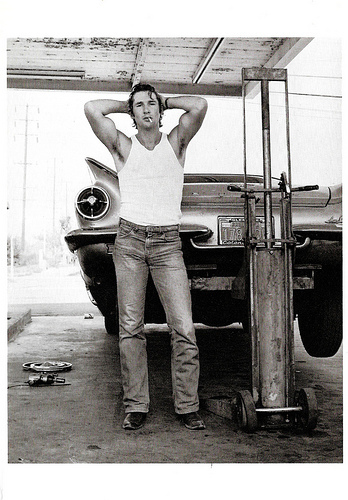
American postcard by Fotofolio, N.Y., N.Y. Photo: Herb Ritts. Caption: Richard Gere, San Bernardino, 1979. Courtesy Fahey / Klein Gallery Los Angeles. Proceeds of the sale of this card benefit The American Foundation For Aids Research.
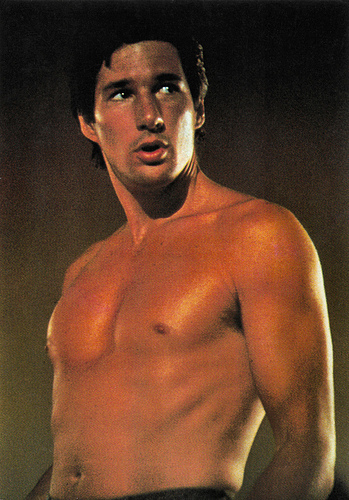
French postcard by Editions Librairie Images'in, no J 19. Photo: publicity still for American Gigolo (Paul Schrader, 1980).
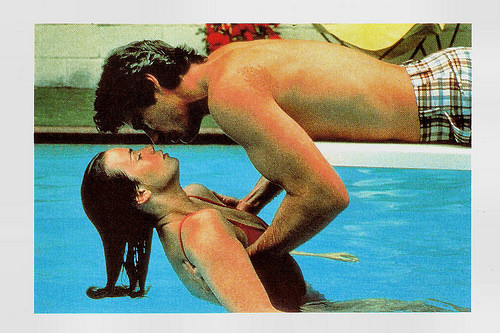
Italian postcard by Ediber-Angelus. Photo: publicity still for Breathless (1983) with Valerie Kaprisky .
A poetic biblical parable in the Texas Panhandle
Richard Tiffany Gere was born in 1949, in Philadelphia, Pennsylvania, USA. He was the second of five children of Doris Ann (Tiffany), a homemaker, and Homer George Gere, an insurance salesman, both Mayflower descendants.
Gere had a strict Methodist upbringing. He started early as a musician, playing a number of instruments in high school and writing music for high school productions. He graduated from North Syracuse Central High School in 1967, and won a gymnastics scholarship to the University of Massachusetts in Amherst, where he majored in philosophy.
He left college after two years to pursue acting. Gere first worked professionally at the Seattle Repertory Theatre and Provincetown Playhouse on Cape Cod in 1969, where he starred in 'Rosencrantz and Guildenstern Are Dead'. He landed the lead role as Danny Zuko in the London production of the musical 'Grease' in 1973. While in London, Gere became one of the few Americans ever to work with Britain's Young Vic Theater, with which he appeared in 'The Taming of the Shrew'.
He later reprised his role as Danny Zuko in Grease on Broadway. In 1974, Gere made his feature film debut with a tiny part in Report to the Commissioner (Milton Katselas, 1974). He returned to the stage the following year as part of the cast of an off-Broadway production of Sam Shepard's Killer's Head.
Some of Gere's earliest photos, known as 'head shots' were taken by boyhood friend and struggling photographer Herb Ritts. The people handling Gere were so impressed with the photos that they began hiring Ritts for other assignments. Ritts became a top photographer.
Onscreen, Gere had a few roles, and gained recognition in Looking for Mr. Goodbar (Richard Brooks, 1977) opposite Diane Keaton. He played his first leading role in the dream-like drama Days of Heaven (Terrence Malick, 1978). Joshua Dysart at IMDb : "A poetic biblical parable played out in the Texas Panhandle at the turn of the century, it gives total preference to the emotion of imagery over the emotion of the actors. It's an exorcise in feeling and seeing that's so successful it elevated Terrence Malick into the ranks of visual storytellers like Tarkovski and Kurosawa."
In Italy, Gere won the David di Donatello Award (the Italian Oscar) for Best Foreign Actor. Gere spent 1978 meeting Tibetans when he travelled to Nepal, where he spoke to many monks and lamas.
Returning to the US, Gere won considerable theatrical acclaim for his performance as a gay concentration-camp prisoner in the Broadway production of Martin Sherman's 'Bent'. For his role he received the 1980 Theatre World Award.
Back in Hollywood, he played the title role in American Gigolo (Paul Schrader, 1980), which established him as a leading man and a sex symbol. His star status was reaffirmed by An Officer and a Gentleman (Taylor Hackford, 1982) with Debra Winger. The film grossed almost $130 million and won two Academy Awards out of six nominations. Gere himself received his first Golden Globe Award nomination. In The Cotton Club (Francis Coppola, 1984) he appeared with Diane Lane.
In the early 1980s, Richard went to Honduras, Nicaragua and El Salvador amidst ongoing wars and political violence. With a doctor, he visited refugee camps. In the late 1980s, his career seemed to have a dip. His celebrity status was jeopardised with roles in the several poorly received biblical drama King David (Bruce Beresford, 1985) and the underrated political drama Power (Sidney Lumet, 1986).
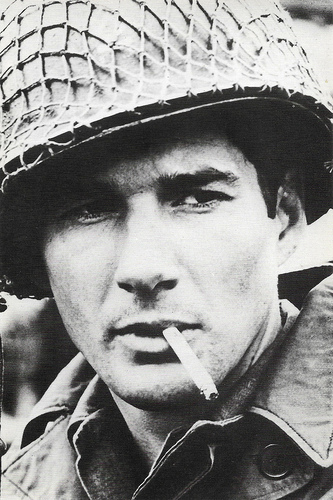
British postcard in the Photographs series, no. 104. Photo: publicity still for Yanks (John Schlesinger, 1979).
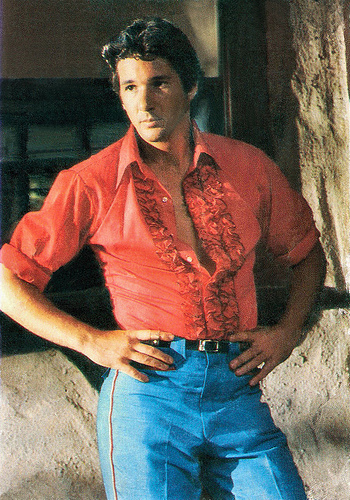
Italian postcard by Compagnia Distribuziona Europea. Photo: publicity still for Breathless (Jim McBride, 1983).
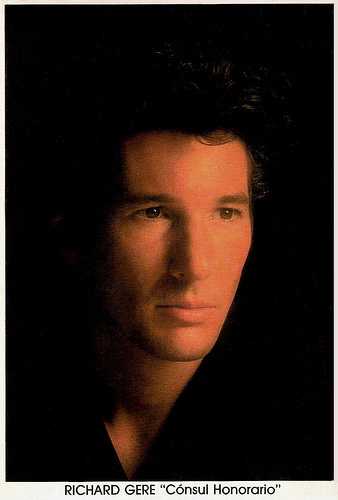
Spanish postcard in the 'Yo amo al Cine' series by Rovensa / Lauren Films. Photo: Lauren Films. Publicity still for The Honorary Consul (John Mackenzie, 1983).
Capturing the nation's heart
In 1990 Richard Gere returned to the front row with two excellent films. In Internal Affairs (Mike Figgis, 1990), he was a sensation as the bad guy. Andy Garcia played an Internal Affairs agent who becomes obsessed with bringing down a cop (Gere) who manages to maintain a spotless reputation despite being involved in a web of corruption.
Gere then teamed up with Julia Roberts to star in the the smash romantic comedy Pretty Woman (Garry Marshall, 1990). His cool reserve as a ruthless businessman was the perfect complement to Julia's bubbling enthusiasm. The film captured the nation's heart, and it earned Gere his second Golden Globe Award nomination.
Fans clamoured for years for a sequel, or at least another pairing of Julia and Richard. They got that with Runaway Bride (Garry Marshall, 1999), which was a runaway success. Gere received $12 million, and the box office was $152 million. Off screen, Richard and Cindy Crawford got married in 1991. They were divorced in 1995.
Gere had a leading role in the Japanese film Hachi-gatsu no rapusodî (Akira Kurosawa, 1991), a film warning viewers of the dangers of nuclear power. Gere is also active in AIDS fund raising and agreed to play a small role in the HBO film And the Band Played On (Roger Spottiswoode, 1993) despite the prevalent belief in the film industry a film about AIDS would be detrimental to his career. It was not.
He co-starred with Jodie Foster in the box office hit Sommersby (Jon Amiel, 1993). A Buddhist for over a decade, he was banned from the Oscars once after making anti-China comments on the air at the 1993 ceremony. Gere played one of his best roles in Primal Fear (Gregory Hoblit, 1996), as a fame-hungry lawyer who defends an altar boy (Edward Norton) accused of murdering a priest.
People magazine had picked him as one of the 50 Most Beautiful People in the world in 1991, and in 1999 picked him as their Sexiest Man Alive. The following year, the actor enjoyed some of his best reviews to date as a gynaecologist at once devoted to and bewildered by all of the women in his life in the aptly titled Dr. T & the Women (Robert Altman, 2000). Critics noted that Gere seemed to have finally come into his own as an actor, having matured amiably with years and experience.
After his divorce from Cindy Crawford, Gere had started dating actress Carey Lowell. In 2000, they had a son, Homer James Jigme Gere. Jigme means 'fearless' in Tibetan. Gere and Lowell married in 2002.
His later films include the thriller Unfaithful (Adrian Lyne, 2002) in which he reunited with Diane Lane, the Oscar winning musical Chicago (Rob Marshall, 2002) with Renée Zellweger and Catherine Zeta-Jones , and the ballroom dancing drama Shall We Dance? (Peter Chelsom, 2004), which grossed $170 million worldwide.
In the comedy-drama The Hoax (Lasse Hallström, 2006), he played Clifford Irving who sold his bogus biography of Howard Hughes to a premiere publishing house in the early 1970s. Gere was one of the characters who embody a different aspect of Bob Dylan's life and work in I'm Not There (Todd Haynes, 2007).
Other interesting films are the crime drama Brooklyn's Finest (Antoine Fuqua, 2009) with Don Cheadle, the British comedy-drama The Second Best Exotic Marigold Hotel (John Madden, 2015) with Judi Dench and Maggie Smith, and Three Christs (Jon Avnet, 2017) with Peter Dinklage. He was notably singled out for portraying businessman Robert Miller opposite Susan Sarandon in Arbitrage (Nicholas Jarecki, 2012), earning his fourth Golden Globe Award nomination.
Gere is also an accomplished pianist, music writer, and above all a humanitarian. He's a founding member of Tibet House, a nonprofit organisation dedicated to the preservation of Tibetan culture. He has been an active supporter of Survival International, which supports tribal people, including the natives of the Amazon, the Maasai of East Africa, the Wichi of Argentina.
After 11 years of marriage, Richard Gere and Carey Lowell separated. Since April 2018, Richard Gere is married to Spanish activist Alejandra Silva.
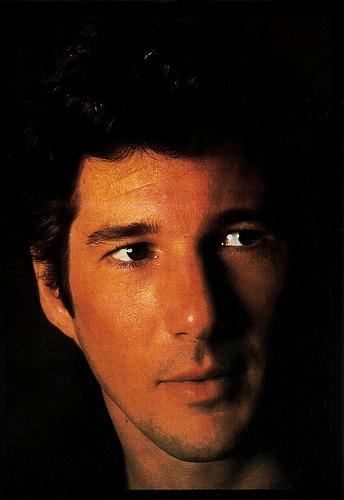
British postcard by Santoro Graphics Ltd., London, no. C237.
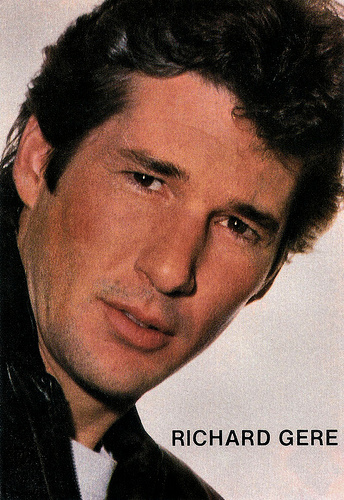
Spanish postcard.
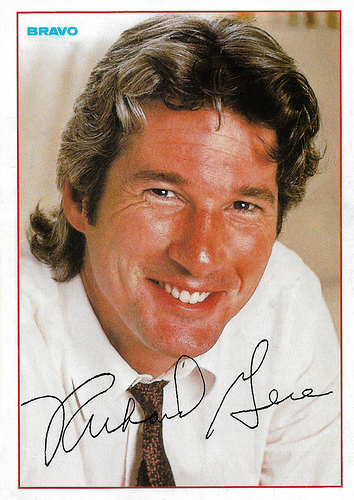
German autograph card by BRAVO, 1990.
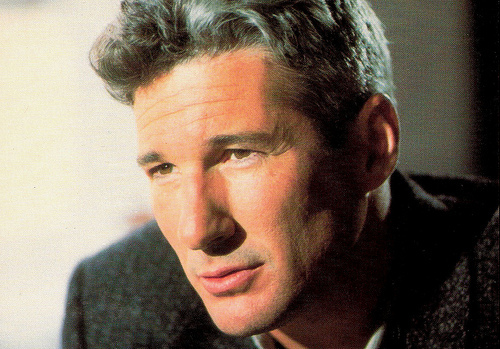
Italian postcard in the 'World Collection' series, no. P.c. 310. Photo: G. Neri.
Source: Sandra Brennan (AllMovie), (IMDb), Wikipedia and .

American postcard by Fotofolio, N.Y., N.Y. Photo: Herb Ritts. Caption: Richard Gere, San Bernardino, 1979. Courtesy Fahey / Klein Gallery Los Angeles. Proceeds of the sale of this card benefit The American Foundation For Aids Research.

French postcard by Editions Librairie Images'in, no J 19. Photo: publicity still for American Gigolo (Paul Schrader, 1980).

Italian postcard by Ediber-Angelus. Photo: publicity still for Breathless (1983) with Valerie Kaprisky .
A poetic biblical parable in the Texas Panhandle
Richard Tiffany Gere was born in 1949, in Philadelphia, Pennsylvania, USA. He was the second of five children of Doris Ann (Tiffany), a homemaker, and Homer George Gere, an insurance salesman, both Mayflower descendants.
Gere had a strict Methodist upbringing. He started early as a musician, playing a number of instruments in high school and writing music for high school productions. He graduated from North Syracuse Central High School in 1967, and won a gymnastics scholarship to the University of Massachusetts in Amherst, where he majored in philosophy.
He left college after two years to pursue acting. Gere first worked professionally at the Seattle Repertory Theatre and Provincetown Playhouse on Cape Cod in 1969, where he starred in 'Rosencrantz and Guildenstern Are Dead'. He landed the lead role as Danny Zuko in the London production of the musical 'Grease' in 1973. While in London, Gere became one of the few Americans ever to work with Britain's Young Vic Theater, with which he appeared in 'The Taming of the Shrew'.
He later reprised his role as Danny Zuko in Grease on Broadway. In 1974, Gere made his feature film debut with a tiny part in Report to the Commissioner (Milton Katselas, 1974). He returned to the stage the following year as part of the cast of an off-Broadway production of Sam Shepard's Killer's Head.
Some of Gere's earliest photos, known as 'head shots' were taken by boyhood friend and struggling photographer Herb Ritts. The people handling Gere were so impressed with the photos that they began hiring Ritts for other assignments. Ritts became a top photographer.
Onscreen, Gere had a few roles, and gained recognition in Looking for Mr. Goodbar (Richard Brooks, 1977) opposite Diane Keaton. He played his first leading role in the dream-like drama Days of Heaven (Terrence Malick, 1978). Joshua Dysart at IMDb : "A poetic biblical parable played out in the Texas Panhandle at the turn of the century, it gives total preference to the emotion of imagery over the emotion of the actors. It's an exorcise in feeling and seeing that's so successful it elevated Terrence Malick into the ranks of visual storytellers like Tarkovski and Kurosawa."
In Italy, Gere won the David di Donatello Award (the Italian Oscar) for Best Foreign Actor. Gere spent 1978 meeting Tibetans when he travelled to Nepal, where he spoke to many monks and lamas.
Returning to the US, Gere won considerable theatrical acclaim for his performance as a gay concentration-camp prisoner in the Broadway production of Martin Sherman's 'Bent'. For his role he received the 1980 Theatre World Award.
Back in Hollywood, he played the title role in American Gigolo (Paul Schrader, 1980), which established him as a leading man and a sex symbol. His star status was reaffirmed by An Officer and a Gentleman (Taylor Hackford, 1982) with Debra Winger. The film grossed almost $130 million and won two Academy Awards out of six nominations. Gere himself received his first Golden Globe Award nomination. In The Cotton Club (Francis Coppola, 1984) he appeared with Diane Lane.
In the early 1980s, Richard went to Honduras, Nicaragua and El Salvador amidst ongoing wars and political violence. With a doctor, he visited refugee camps. In the late 1980s, his career seemed to have a dip. His celebrity status was jeopardised with roles in the several poorly received biblical drama King David (Bruce Beresford, 1985) and the underrated political drama Power (Sidney Lumet, 1986).

British postcard in the Photographs series, no. 104. Photo: publicity still for Yanks (John Schlesinger, 1979).

Italian postcard by Compagnia Distribuziona Europea. Photo: publicity still for Breathless (Jim McBride, 1983).

Spanish postcard in the 'Yo amo al Cine' series by Rovensa / Lauren Films. Photo: Lauren Films. Publicity still for The Honorary Consul (John Mackenzie, 1983).
Capturing the nation's heart
In 1990 Richard Gere returned to the front row with two excellent films. In Internal Affairs (Mike Figgis, 1990), he was a sensation as the bad guy. Andy Garcia played an Internal Affairs agent who becomes obsessed with bringing down a cop (Gere) who manages to maintain a spotless reputation despite being involved in a web of corruption.
Gere then teamed up with Julia Roberts to star in the the smash romantic comedy Pretty Woman (Garry Marshall, 1990). His cool reserve as a ruthless businessman was the perfect complement to Julia's bubbling enthusiasm. The film captured the nation's heart, and it earned Gere his second Golden Globe Award nomination.
Fans clamoured for years for a sequel, or at least another pairing of Julia and Richard. They got that with Runaway Bride (Garry Marshall, 1999), which was a runaway success. Gere received $12 million, and the box office was $152 million. Off screen, Richard and Cindy Crawford got married in 1991. They were divorced in 1995.
Gere had a leading role in the Japanese film Hachi-gatsu no rapusodî (Akira Kurosawa, 1991), a film warning viewers of the dangers of nuclear power. Gere is also active in AIDS fund raising and agreed to play a small role in the HBO film And the Band Played On (Roger Spottiswoode, 1993) despite the prevalent belief in the film industry a film about AIDS would be detrimental to his career. It was not.
He co-starred with Jodie Foster in the box office hit Sommersby (Jon Amiel, 1993). A Buddhist for over a decade, he was banned from the Oscars once after making anti-China comments on the air at the 1993 ceremony. Gere played one of his best roles in Primal Fear (Gregory Hoblit, 1996), as a fame-hungry lawyer who defends an altar boy (Edward Norton) accused of murdering a priest.
People magazine had picked him as one of the 50 Most Beautiful People in the world in 1991, and in 1999 picked him as their Sexiest Man Alive. The following year, the actor enjoyed some of his best reviews to date as a gynaecologist at once devoted to and bewildered by all of the women in his life in the aptly titled Dr. T & the Women (Robert Altman, 2000). Critics noted that Gere seemed to have finally come into his own as an actor, having matured amiably with years and experience.
After his divorce from Cindy Crawford, Gere had started dating actress Carey Lowell. In 2000, they had a son, Homer James Jigme Gere. Jigme means 'fearless' in Tibetan. Gere and Lowell married in 2002.
His later films include the thriller Unfaithful (Adrian Lyne, 2002) in which he reunited with Diane Lane, the Oscar winning musical Chicago (Rob Marshall, 2002) with Renée Zellweger and Catherine Zeta-Jones , and the ballroom dancing drama Shall We Dance? (Peter Chelsom, 2004), which grossed $170 million worldwide.
In the comedy-drama The Hoax (Lasse Hallström, 2006), he played Clifford Irving who sold his bogus biography of Howard Hughes to a premiere publishing house in the early 1970s. Gere was one of the characters who embody a different aspect of Bob Dylan's life and work in I'm Not There (Todd Haynes, 2007).
Other interesting films are the crime drama Brooklyn's Finest (Antoine Fuqua, 2009) with Don Cheadle, the British comedy-drama The Second Best Exotic Marigold Hotel (John Madden, 2015) with Judi Dench and Maggie Smith, and Three Christs (Jon Avnet, 2017) with Peter Dinklage. He was notably singled out for portraying businessman Robert Miller opposite Susan Sarandon in Arbitrage (Nicholas Jarecki, 2012), earning his fourth Golden Globe Award nomination.
Gere is also an accomplished pianist, music writer, and above all a humanitarian. He's a founding member of Tibet House, a nonprofit organisation dedicated to the preservation of Tibetan culture. He has been an active supporter of Survival International, which supports tribal people, including the natives of the Amazon, the Maasai of East Africa, the Wichi of Argentina.
After 11 years of marriage, Richard Gere and Carey Lowell separated. Since April 2018, Richard Gere is married to Spanish activist Alejandra Silva.

British postcard by Santoro Graphics Ltd., London, no. C237.

Spanish postcard.

German autograph card by BRAVO, 1990.

Italian postcard in the 'World Collection' series, no. P.c. 310. Photo: G. Neri.
Source: Sandra Brennan (AllMovie), (IMDb), Wikipedia and .
Published on April 07, 2019 22:00
April 6, 2019
Jean Harlow
American film actress Jean Harlow (1911–1937) was with her come-hither body, platinum blonde hair, and keen sense of humour, one of Hollywood's sex symbols of the 1930s. She had her breakthrough in Howard Hughes' World War I epic Hell's Angels (1930). Frank Capra's Platinum Blonde (1931) cemented her role as America's new sex symbol. In 1932, she signed with Metro-Goldwyn-Mayer and became the leading lady in a string of hit films. These included Red Dust (1932), Dinner at Eight (1933), Reckless (1935) and Suzy (1936). Among her frequent co-stars were William Powell, Spencer Tracy and, in six films, Clark Gable.
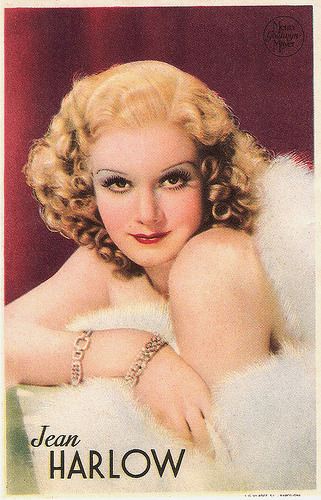
Spanish collector's card by J.G. Viladot, Barcelona. Photo: Metro-Goldwyn Mayer.
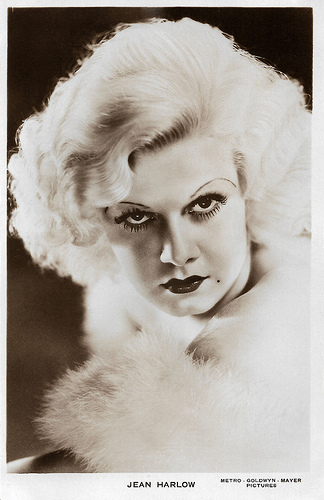
British Real Photograph postcard. Photo: Metro-Goldwyn-Mayer.
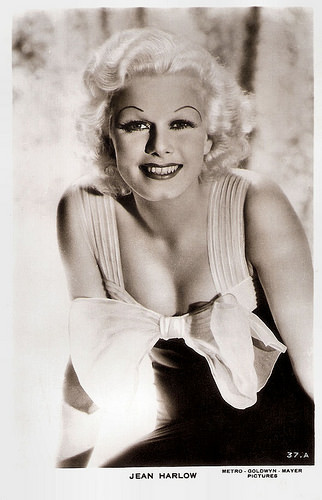
British Real Photograph postcard, no. 37 A. Photo: Metro-Goldwyn-Mayer.
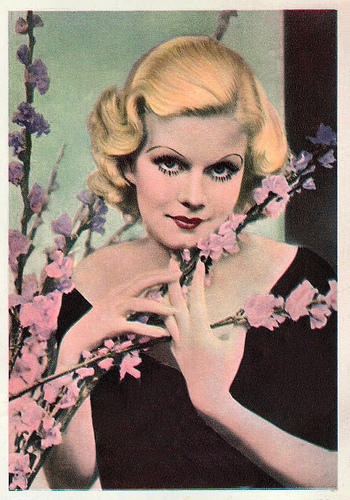
British postcard by De Reszke Cigarettes, no. 6. Photo: M.G.M.
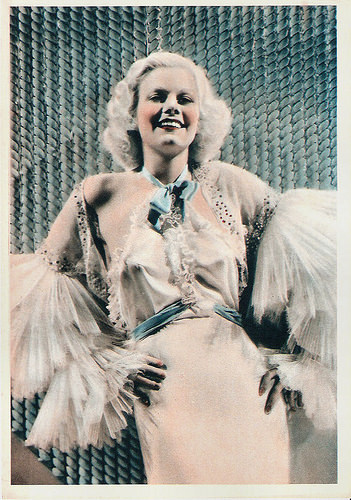
British postcard by De Reszke Cigarettes, no. 16. Photo: M.G.M.
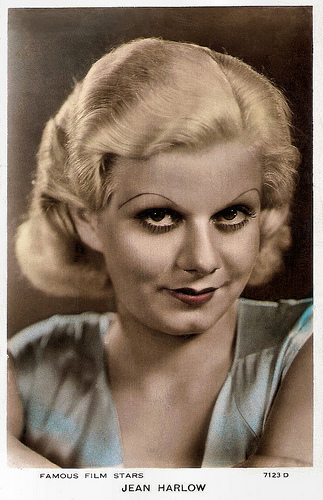
British Real Photograph postcard by Valentine's in the Famous Film Stars series, no. 7123 D. Photo: Metro-Goldwyn-Mayer.
The Baby
Jean Harlow was born Harlean Harlow Carpenter in Kansas City, Missouri, in 1911. The name is sometimes incorrectly spelled Carpentier, following later studio press releases. Her father, Mont Clair Carpenter was a dentist from a working-class background who attended dental school in Kansas City. Her mother, Jean Poe Carpenter née Harlow was the daughter of a wealthy real estate broker, Skip Harlow. The marriage was arranged by Jean's father for their under-age daughter in 1908. Jean was resentful, and became very unhappy in the marriage. The couple lived in Kansas City in a house owned by Jean's father.
Harlean was nicknamed 'The Baby', a name that would stick with her for the rest of her life. Harlean and 'Mother Jean', as she became known when Harlean became a film star, remained very close. Harlean's mother was extremely protective and coddling, reportedly instilling a sense that her daughter owed everything she had to her. "She was always all mine", she said of her daughter. When Harlean was at school, her mother filed for a divorce that was finalised in 1922. She was granted sole custody of Harlean, who loved the father who would survive her by thirty-seven years. However, Harlean would rarely see him again.
Mother Jean moved with Harlean to Hollywood in 1923 with hopes of becoming an actress, but was too old at 34 to begin a film career. Young Harlean attended the Hollywood School for Girls, but dropped out of school at age 14 in the spring of 1925. Finances dwindling, she and her mother moved back to Kansas City after Skip Harlow issued an ultimatum that he would disinherit Jean if she did not return. Several weeks later, Skip sent his granddaughter to a summer camp, Camp Cha-Ton-Ka, in Michigamme, Michigan, where she became ill with scarlet fever. Her mother travelled to Michigan to care for her, rowing herself across the lake to the camp, but was told she could not see her daughter.
Harlow attended the Ferry Hall School (now Lake Forest Academy) in Lake Forest, Illinois. Her mother had an ulterior motive for Harlean's attendance there, as it was close to the Chicago home of her boyfriend, Marino Bello. Each freshman was paired with a 'big sister' from the senior class, and Harlean's big sister introduced her to 19-year-old Charles 'Chuck' Fremont McGrew, heir to a large fortune, in the fall of 1926. Soon the two began to date, and then married. Early 1927, Jean Carpenter also married Bello; Harlean was not present.
Shortly after the wedding, the McGrews left Chicago and moved to Beverly Hills. McGrew turned 21 two months after the marriage and received part of his large inheritance. The couple moved to Los Angeles in 1928, settling into a home in Beverly Hills, where Harlean thrived as a wealthy socialite. McGrew hoped to distance Harlean from her mother with the move. Neither McGrew nor Harlean worked, and both, especially McGrew, were thought to drink heavily.
In Los Angeles, Harlean befriended Rosalie Roy, a young aspiring actress. Lacking a car, Roy asked Harlean to drive her to Fox Studios for an appointment. Reputedly, Harlean was noticed and approached by Fox executives while waiting for her friend, but stated that she was not interested. Nevertheless, she was given dictated letters of introduction to Central Casting. A few days later, Rosalie Roy bet Harlean that she did not have the nerve to go and audition. Unwilling to lose a wager and pressed by her enthusiastic mother, now back in Los Angeles, Harlean drove to Central Casting and signed in under her mother's maiden name, Jean Harlow.
After several calls from Central Casting and a number of rejected job offers, Harlean was pressed into accepting work by her mother. She appeared in her first film, Honor Bound (Alfred E. Green, 1928), as an unbilled extra. This led to small parts in feature films such as Moran of the Marines (Frank R. Strayer, 1928) with Richard Dix, This Thing Called Love (Paul L. Stein, 1929), Close Harmony (John Cromwell, 1929), and The Love Parade (Ernst Lubitsch, 1929), starring Maurice Chevalier .
In December 1928, she signed a five-year contract with Hal Roach Studios for $100 per week. She had a co-starring role in Laurel and Hardy 's short Double Whoopee (Lewis R. Foster, 1929), and went on to appear in two more of their films: Liberty (Leo McCarey, 1929) and Bacon Grabbers (Lewis R. Foster, 1929).
In March 1929, however, she parted with Hal Roach, who tore up her contract after Harlow told him, "It's breaking up my marriage, what can I do?" In June 1929, Harlow separated from her husband and moved in with her mother and Bello. After her separation from McGrew, Harlow worked as an extra in several films. She landed her first speaking role in The Saturday Night Kid (A. Edward Sutherland, 1929), starring Clara Bow. The couple divorced in 1929.
In late 1929, Jean was spotted by actor James Hall, who was filming Howard Hughes' Hell's Angels (1930). Hughes revamped most of his originally silent film of 1927 with sound, and he needed an actress to replace Greta Nissen , who had a Norwegian accent that was considered to be undesirable for her character. Harlow made a test and got the part. In this film she uttered the immortal words "Would you be shocked if I changed into something more comfortable?" Hughes signed Harlow to a five-year, $100-per-week contract in 1929. Hell's Angels premiered in Hollywood on 27 May 1930, at Grauman's Chinese Theater, becoming the highest-grossing film of 1930, besting even Greta Garbo 's talkie debut in Anna Christie (Clarence Brown, 1930).
Hell's Angels (Howard Hughes, Edmund Goulding, James Whale, 1930) made Harlow an international star. Although she was popular with audiences, critics were less than enthusiastic. The New Yorker called her performance "plain awful", though Variety magazine conceded, "It doesn't matter what degree of talent she possesses ... nobody ever starved possessing what she's got." During the shooting, Harlow met MGM executive Paul Bern. She was again an uncredited extra in the Charlie Chaplin film City Lights (1931), though her appearance did not make the final cut.
With no projects planned for Harlow, Hughes sent her to New York, Seattle, and Kansas City for Hell's Angels premieres. In 1931, loaned out by Hughes to other studios, she gained more attention when she appeared in The Secret Six (George W. Hill, 1931), with Wallace Beery and Clark Gable; Iron Man (Tod Browning, 1931), with Lew Ayres and Robert Armstrong; and The Public Enemy (William A. Wellman, 1931), with James Cagney. Though the successes of the films ranged from moderate to hit, Harlow's acting was mocked by critics. Concerned, Hughes sent her on a brief publicity tour, which was not a success, as Harlow dreaded such personal appearances.
Jean Harlow dated notorious New Jersey mobster Abner Zwillman (aka 'Longy"), who secured a two-picture deal for her with Harry Cohn of Columbia Pictures by loaning Cohn $500,000 in cash. He also purchased her a jewelled charm bracelet and a red Cadillac.
Columbia Pictures cast her in Platinum Blonde (Frank Capra, 1931), with Loretta Young. The film, originally titled Gallagher, was renamed to promote Harlow, capitalising on her hair colour, called 'platinum' by Hughes' publicists. Though Harlow denied her hair was dyed, the platinum blonde colour was reportedly achieved by bleaching with a weekly application of ammonia, Clorox bleach, and Lux soap flakes. This process weakened and damaged Harlow's naturally ash-blonde hair. Many female fans began dyeing their hair to match hers. Howard Hughes' team organised a series of 'Platinum Blonde' clubs across the nation, with a prize of $10,000 to any beautician who could match Harlow's shade. No one could, the prize went unclaimed but Hughes' publicity worked and the nickname stuck with Harlow.
Harlow next filmed Three Wise Girls (William Beaudine, 1932), for Columbia Pictures, with Mae Clark and Walter Byron . Paul Bern then arranged to borrow her for The Beast of the City (1932), co-starring Walter Huston. After filming, Bern booked a 10-week personal-appearance tour on the East Coast. To the surprise of many, especially Harlow herself, she packed every theatre in which she appeared, often appearing in a single venue for several nights. Despite critical disparagement and poor roles, Harlow's popularity and following was large and growing and, in February 1932, the tour was extended by six weeks.
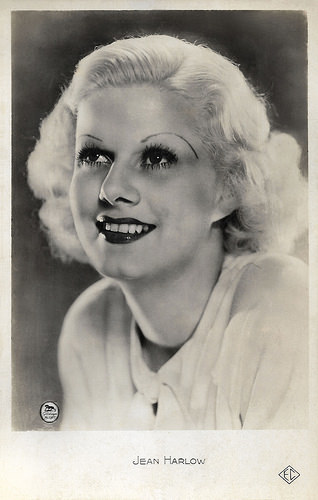
French postcard by Editions Chantal (EC). Photo: Metro-Goldwyn-Mayer.
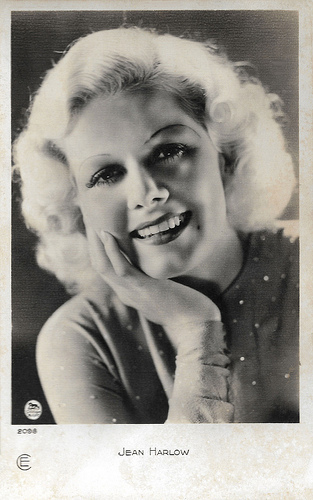
French postcard by CE (Cinémagazine-Édition, Paris), no. 2098. Photo: Metro-Goldwyn-Mayer.
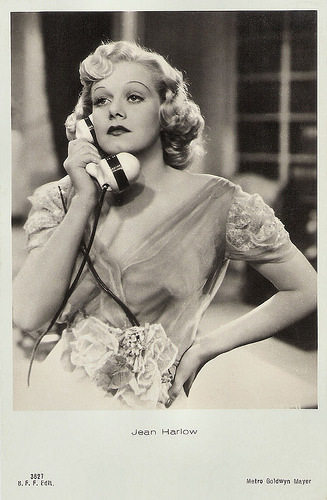
Italian postcard by B.F.F. Edit., no. 3827. Photo: Metro-Goldwyn-Mayer. Publicity still for Saratoga (Jack Conway, 1937).
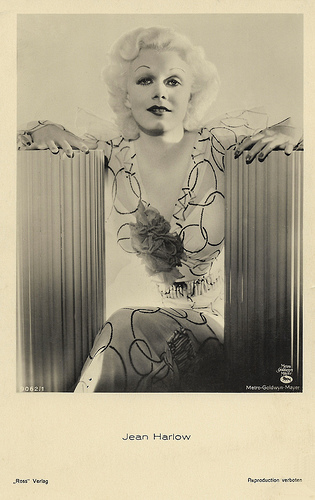
German postcard by Ross Verlag, no. 9062/3, 1935-1936. Photo: Metro-Goldwyn-Mayer.
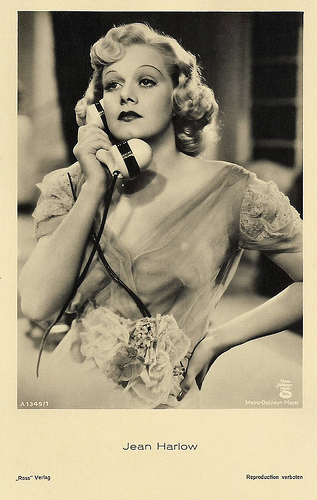
German postcard by Ross Verlag. Photo: Metro-Goldwyn-Mayer, no. A 1349/1, 1937-1938. Publicity still for Saratoga (Jack Conway, 1937).
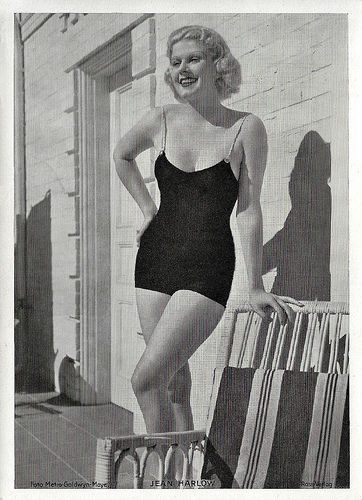
Big German card by Ross Verlag. Photo: Metro-Goldwyn-Mayer.
Platinum Blonde Bombshell
Jean Harlow was now romantically involved with MGM producer Paul Bern and he spoke to Louis B. Mayer about buying out her contract with Hughes and signing her to MGM, but Mayer declined. MGM's leading ladies were presented as elegant, while Harlow's 'floozy' screen persona was abhorrent to Mayer. Bern then began urging close friend Irving Thalberg, production head of MGM, to sign Harlow, noting her popularity and established image. After initial reluctance, Thalberg agreed and, on 3 March 1932, Harlow's 21st birthday, Bern called her with the news that MGM had purchased her contract from Hughes for $30,000.
At MGM, Harlow was given superior movie roles to show off her looks and nascent comedic talent. Though Harlow's screen persona changed dramatically during her career, one constant was her apparent sense of humor. In 1932, she starred in the comedy Red-Headed Woman (Jack Conway, 1932), for which she received $1,250 a week. The film is often noted as being one of the few films in which Harlow did not appear with platinum blonde hair; she wore a red wig for the role. She next starred in Red Dust (Victor Fleming, 1932), her second film with Clark Gable. Harlow and Gable worked well together and co-starred in a total of six films.
She was also paired multiple times with Spencer Tracy and William Powell. At this point, MGM began trying to distinguish Harlow's public persona from that of her screen characters, changing her childhood surname from common 'Carpenter' to chic 'Carpentier', claiming that writer Edgar Allan Poe was one of her ancestors and publishing photographs of Harlow doing charity work to change her image from that of a tramp to an all-American girl. This transformation proved difficult; once, Harlow was heard muttering, "My God, must I always wear a low-cut dress to be important?"
During the making of Red Dust, Bern—her husband of two months—was found dead at their home. His death created a lasting scandal. Initially, Harlow was speculated to have killed Bern, but Bern's death was officially ruled a suicide by self-inflicted gunshot wound. Reportedly, the day after Bern's former common-law wife met Harlow, Bern shot himself. A few days later former Mrs. Bern was found floating in the Sacramento River, after allegedly committing suicide.
Louis B. Mayer feared negative publicity from the incident and intended to replace Harlow in the film, offering the role to Tallulah Bankhead. Bankhead was appalled by the offer and wrote in her autobiography, "To damn the radiant Jean for the misfortune of another would be one of the shabbiest acts of all time. I told Mr. Mayer as much." Harlow kept silent, survived the ordeal, and became more popular than ever. A 2009 biography of Bern asserted that Bern was, in fact, murdered by a former lover and the crime scene re-arranged by MGM executives to make it appear Bern had killed himself.
After Bern's death, Harlow began an indiscreet affair with boxer Max Baer who, though separated from his wife Dorothy Dunbar, was threatened with divorce proceedings naming Harlow as a co-respondent for "alienation of affection", a legal term for adultery. After Bern's mysterious death, the studio did not want another scandal and defused the situation by arranging a marriage between Harlow and cinematographer Harold Rosson. Rosson and Harlow were friends and Rosson went along with the plan. They quietly divorced eight months later. By 1933, MGM realised the value of the Harlow-Gable team and paired them again in Hold Your Man (Sam Wood, 1933), which was also a box-office success.
The same year, she played the adulterous wife of a ruthless tycoon (Wallace Beery) in the glittering all-star comedy-drama Dinner at Eight (George Cukor, 1933), and played a pressured Hollywood film star in the screwball comedy Bombshell (Victor Fleming, 1933) with Lee Tracy. The film has often been cited as being based on Harlow's own life or that of 1920s 'It girl', Clara Bow. The film included Harlow's greedy stepfather, her nine-room Georgian-style home with mostly-white interiors, and her numerous pet dogs. The following year, she was teamed with Lionel Barrymore and Franchot Tone in The Girl from Missouri (Jack Conway, 1934). The film was the studio's attempt at softening Harlow's image, but suffered with censorship problems, so much so that its original title, Born to Be Kissed, had to be changed.
In 1934, Jean Harlow went on a salary strike from MGM, during which she wrote a novel, 'Today is Tonight'. The book was not published until 1965.
After the financial success of Red Dust and Hold Your Man, MGM cast Harlow with Clark Gable in two more successful films: China Seas (Tay Garnett, 1935), with Wallace Beery and Rosalind Russell; and Wife vs. Secretary (Clarence Brown, 1936), with Myrna Loy and James Stewart. Jean Harlow's popularity rivalled and soon surpassed that of her MGM colleagues Joan Crawford and Norma Shearer. Reckless (Victor Fleming, 1935) was her first film musical. It co-starred her then-boyfriend William Powell and Franchot Tone.
Suzy (George Fitzmaurice, 1936), in which she played the title role, gave her top billing over Franchot Tone and Cary Grant. While critics noted that Harlow dominated the film, they added that her performance was imperfect, and the film was a reasonable box-office success. She then starred in Riffraff (J. Walter Ruben, 1936) with Spencer Tracy and Una Merkel, a financial disappointment, and the worldwide hit Libeled Lady (Jack Conway, 1936), in which she was top billed over Powell, Myrna Loy, and Tracy.
By the late 1930s, Jean Harlow had become one of the biggest stars of Hollywood, often nicknamed the 'Blonde Bombshell' and the 'Platinum Blonde'. She filmed W.S. Van Dyke's comedy Personal Property (1937), co-starring Robert Taylor. It was Harlow's final fully completed film appearance. During the filming of Saratoga (Jack Conway, 1937), she died in 11 hospital of renal failure at the age of 26. The official cause of death was 'uremic poisoning brought on by acute nephritis'. For many years it was a widely-held belief that she died because her mother, a Christian Scientist, refused to let doctors operate on her after she became sick. This story has been repeatedly shown to be completely untrue.
MGM closed on the day of her funeral, 9 June 1937. Saratoga was completed using doubles and released a little over a month after Jean Harlow's death. It became MGM's second-highest grossing picture of 1937. In 1965, two films about Jean Harlow were released, both called Harlow. The first, Harlow (Alex Segal, 1965), was released by Magna in May 1965 and stars Carol Lynley with Ginger Rogers as Mama Jean. The second, Harlow (Gordon Douglas, 1965), was released in June by Paramount Pictures and stars Carroll Baker with Angela Lansbury as her mother. Both were poorly received, and did not perform well at the box office.
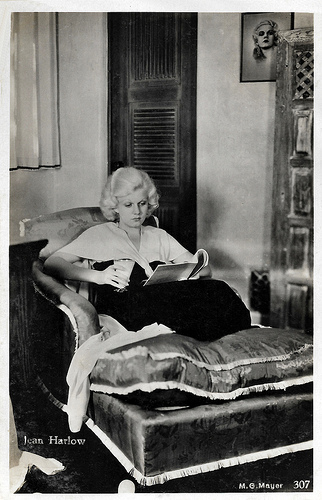
Dutch postcard by JosPe, Arnhem, no. 307. Photo: M.G.M.
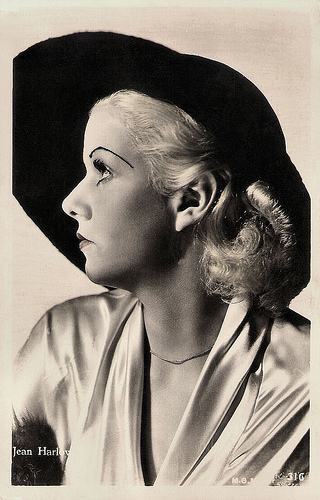
Dutch postcard, no. 316. Photo: M.G.M.
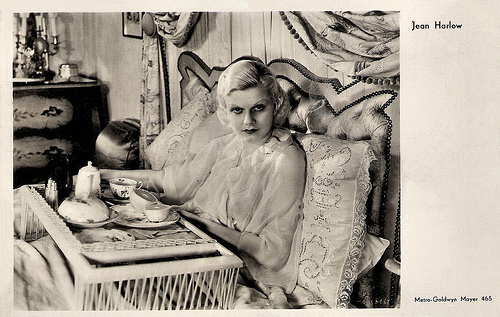
Dutch postcard, no. 465. Photo: Metro-Goldwyn-Mayer.
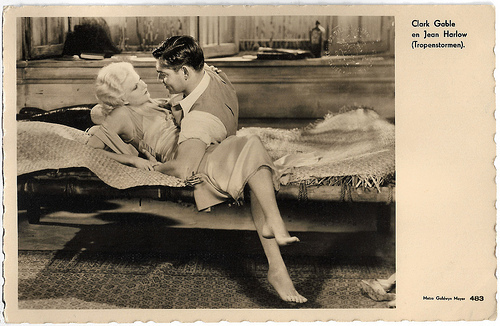
Dutch postcard, no. 483. Photo: M.G.M. Publicity still for Red Dust (Victor Fleming, 1932) with Clark Gable. Sent by mail in 1935.
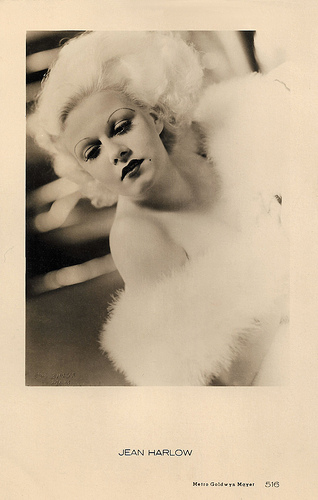
Dutch postcard, no. 516. Photo: M.G.M.
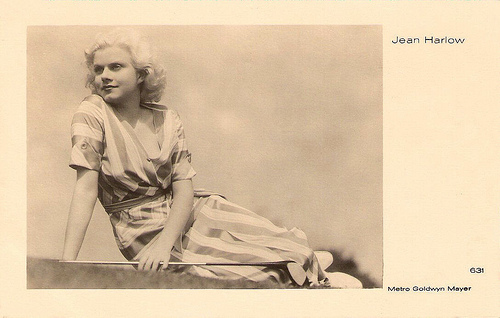
Dutch postcard, no. 631. Photo: Metro-Goldwyn-Mayer.
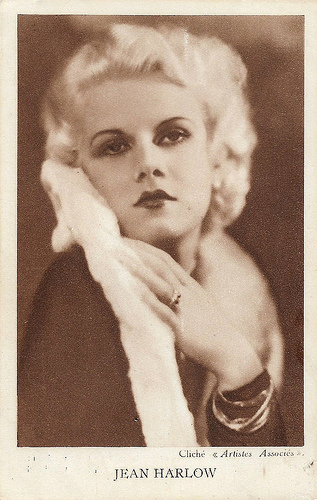
Belgian postcard by S. A. Cacao et Chocolat Kivou, Vilvorde / N. V. Cacao en Chocolade Kivou, Vilvoorde. Photo: United Artists. Publicity still for Hell's Angels (Howard Hughes, Edmund Goulding, James Whale, 1930).
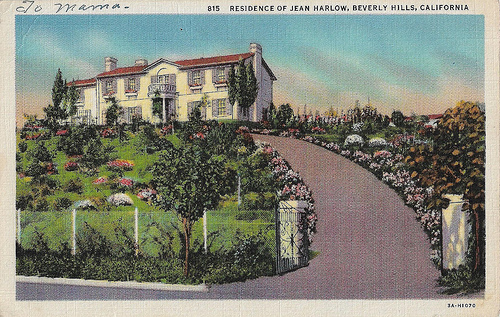
Jean Harlow residence, Beverly Hills. American postcard by Western Publishing & Novelty Co., Los Angeles, no. 815.
Sources: Sandra Brennan (AllMovie), (IMDb), (IMDb), Wikipedia and .

Spanish collector's card by J.G. Viladot, Barcelona. Photo: Metro-Goldwyn Mayer.

British Real Photograph postcard. Photo: Metro-Goldwyn-Mayer.

British Real Photograph postcard, no. 37 A. Photo: Metro-Goldwyn-Mayer.

British postcard by De Reszke Cigarettes, no. 6. Photo: M.G.M.

British postcard by De Reszke Cigarettes, no. 16. Photo: M.G.M.

British Real Photograph postcard by Valentine's in the Famous Film Stars series, no. 7123 D. Photo: Metro-Goldwyn-Mayer.
The Baby
Jean Harlow was born Harlean Harlow Carpenter in Kansas City, Missouri, in 1911. The name is sometimes incorrectly spelled Carpentier, following later studio press releases. Her father, Mont Clair Carpenter was a dentist from a working-class background who attended dental school in Kansas City. Her mother, Jean Poe Carpenter née Harlow was the daughter of a wealthy real estate broker, Skip Harlow. The marriage was arranged by Jean's father for their under-age daughter in 1908. Jean was resentful, and became very unhappy in the marriage. The couple lived in Kansas City in a house owned by Jean's father.
Harlean was nicknamed 'The Baby', a name that would stick with her for the rest of her life. Harlean and 'Mother Jean', as she became known when Harlean became a film star, remained very close. Harlean's mother was extremely protective and coddling, reportedly instilling a sense that her daughter owed everything she had to her. "She was always all mine", she said of her daughter. When Harlean was at school, her mother filed for a divorce that was finalised in 1922. She was granted sole custody of Harlean, who loved the father who would survive her by thirty-seven years. However, Harlean would rarely see him again.
Mother Jean moved with Harlean to Hollywood in 1923 with hopes of becoming an actress, but was too old at 34 to begin a film career. Young Harlean attended the Hollywood School for Girls, but dropped out of school at age 14 in the spring of 1925. Finances dwindling, she and her mother moved back to Kansas City after Skip Harlow issued an ultimatum that he would disinherit Jean if she did not return. Several weeks later, Skip sent his granddaughter to a summer camp, Camp Cha-Ton-Ka, in Michigamme, Michigan, where she became ill with scarlet fever. Her mother travelled to Michigan to care for her, rowing herself across the lake to the camp, but was told she could not see her daughter.
Harlow attended the Ferry Hall School (now Lake Forest Academy) in Lake Forest, Illinois. Her mother had an ulterior motive for Harlean's attendance there, as it was close to the Chicago home of her boyfriend, Marino Bello. Each freshman was paired with a 'big sister' from the senior class, and Harlean's big sister introduced her to 19-year-old Charles 'Chuck' Fremont McGrew, heir to a large fortune, in the fall of 1926. Soon the two began to date, and then married. Early 1927, Jean Carpenter also married Bello; Harlean was not present.
Shortly after the wedding, the McGrews left Chicago and moved to Beverly Hills. McGrew turned 21 two months after the marriage and received part of his large inheritance. The couple moved to Los Angeles in 1928, settling into a home in Beverly Hills, where Harlean thrived as a wealthy socialite. McGrew hoped to distance Harlean from her mother with the move. Neither McGrew nor Harlean worked, and both, especially McGrew, were thought to drink heavily.
In Los Angeles, Harlean befriended Rosalie Roy, a young aspiring actress. Lacking a car, Roy asked Harlean to drive her to Fox Studios for an appointment. Reputedly, Harlean was noticed and approached by Fox executives while waiting for her friend, but stated that she was not interested. Nevertheless, she was given dictated letters of introduction to Central Casting. A few days later, Rosalie Roy bet Harlean that she did not have the nerve to go and audition. Unwilling to lose a wager and pressed by her enthusiastic mother, now back in Los Angeles, Harlean drove to Central Casting and signed in under her mother's maiden name, Jean Harlow.
After several calls from Central Casting and a number of rejected job offers, Harlean was pressed into accepting work by her mother. She appeared in her first film, Honor Bound (Alfred E. Green, 1928), as an unbilled extra. This led to small parts in feature films such as Moran of the Marines (Frank R. Strayer, 1928) with Richard Dix, This Thing Called Love (Paul L. Stein, 1929), Close Harmony (John Cromwell, 1929), and The Love Parade (Ernst Lubitsch, 1929), starring Maurice Chevalier .
In December 1928, she signed a five-year contract with Hal Roach Studios for $100 per week. She had a co-starring role in Laurel and Hardy 's short Double Whoopee (Lewis R. Foster, 1929), and went on to appear in two more of their films: Liberty (Leo McCarey, 1929) and Bacon Grabbers (Lewis R. Foster, 1929).
In March 1929, however, she parted with Hal Roach, who tore up her contract after Harlow told him, "It's breaking up my marriage, what can I do?" In June 1929, Harlow separated from her husband and moved in with her mother and Bello. After her separation from McGrew, Harlow worked as an extra in several films. She landed her first speaking role in The Saturday Night Kid (A. Edward Sutherland, 1929), starring Clara Bow. The couple divorced in 1929.
In late 1929, Jean was spotted by actor James Hall, who was filming Howard Hughes' Hell's Angels (1930). Hughes revamped most of his originally silent film of 1927 with sound, and he needed an actress to replace Greta Nissen , who had a Norwegian accent that was considered to be undesirable for her character. Harlow made a test and got the part. In this film she uttered the immortal words "Would you be shocked if I changed into something more comfortable?" Hughes signed Harlow to a five-year, $100-per-week contract in 1929. Hell's Angels premiered in Hollywood on 27 May 1930, at Grauman's Chinese Theater, becoming the highest-grossing film of 1930, besting even Greta Garbo 's talkie debut in Anna Christie (Clarence Brown, 1930).
Hell's Angels (Howard Hughes, Edmund Goulding, James Whale, 1930) made Harlow an international star. Although she was popular with audiences, critics were less than enthusiastic. The New Yorker called her performance "plain awful", though Variety magazine conceded, "It doesn't matter what degree of talent she possesses ... nobody ever starved possessing what she's got." During the shooting, Harlow met MGM executive Paul Bern. She was again an uncredited extra in the Charlie Chaplin film City Lights (1931), though her appearance did not make the final cut.
With no projects planned for Harlow, Hughes sent her to New York, Seattle, and Kansas City for Hell's Angels premieres. In 1931, loaned out by Hughes to other studios, she gained more attention when she appeared in The Secret Six (George W. Hill, 1931), with Wallace Beery and Clark Gable; Iron Man (Tod Browning, 1931), with Lew Ayres and Robert Armstrong; and The Public Enemy (William A. Wellman, 1931), with James Cagney. Though the successes of the films ranged from moderate to hit, Harlow's acting was mocked by critics. Concerned, Hughes sent her on a brief publicity tour, which was not a success, as Harlow dreaded such personal appearances.
Jean Harlow dated notorious New Jersey mobster Abner Zwillman (aka 'Longy"), who secured a two-picture deal for her with Harry Cohn of Columbia Pictures by loaning Cohn $500,000 in cash. He also purchased her a jewelled charm bracelet and a red Cadillac.
Columbia Pictures cast her in Platinum Blonde (Frank Capra, 1931), with Loretta Young. The film, originally titled Gallagher, was renamed to promote Harlow, capitalising on her hair colour, called 'platinum' by Hughes' publicists. Though Harlow denied her hair was dyed, the platinum blonde colour was reportedly achieved by bleaching with a weekly application of ammonia, Clorox bleach, and Lux soap flakes. This process weakened and damaged Harlow's naturally ash-blonde hair. Many female fans began dyeing their hair to match hers. Howard Hughes' team organised a series of 'Platinum Blonde' clubs across the nation, with a prize of $10,000 to any beautician who could match Harlow's shade. No one could, the prize went unclaimed but Hughes' publicity worked and the nickname stuck with Harlow.
Harlow next filmed Three Wise Girls (William Beaudine, 1932), for Columbia Pictures, with Mae Clark and Walter Byron . Paul Bern then arranged to borrow her for The Beast of the City (1932), co-starring Walter Huston. After filming, Bern booked a 10-week personal-appearance tour on the East Coast. To the surprise of many, especially Harlow herself, she packed every theatre in which she appeared, often appearing in a single venue for several nights. Despite critical disparagement and poor roles, Harlow's popularity and following was large and growing and, in February 1932, the tour was extended by six weeks.

French postcard by Editions Chantal (EC). Photo: Metro-Goldwyn-Mayer.

French postcard by CE (Cinémagazine-Édition, Paris), no. 2098. Photo: Metro-Goldwyn-Mayer.

Italian postcard by B.F.F. Edit., no. 3827. Photo: Metro-Goldwyn-Mayer. Publicity still for Saratoga (Jack Conway, 1937).

German postcard by Ross Verlag, no. 9062/3, 1935-1936. Photo: Metro-Goldwyn-Mayer.

German postcard by Ross Verlag. Photo: Metro-Goldwyn-Mayer, no. A 1349/1, 1937-1938. Publicity still for Saratoga (Jack Conway, 1937).

Big German card by Ross Verlag. Photo: Metro-Goldwyn-Mayer.
Platinum Blonde Bombshell
Jean Harlow was now romantically involved with MGM producer Paul Bern and he spoke to Louis B. Mayer about buying out her contract with Hughes and signing her to MGM, but Mayer declined. MGM's leading ladies were presented as elegant, while Harlow's 'floozy' screen persona was abhorrent to Mayer. Bern then began urging close friend Irving Thalberg, production head of MGM, to sign Harlow, noting her popularity and established image. After initial reluctance, Thalberg agreed and, on 3 March 1932, Harlow's 21st birthday, Bern called her with the news that MGM had purchased her contract from Hughes for $30,000.
At MGM, Harlow was given superior movie roles to show off her looks and nascent comedic talent. Though Harlow's screen persona changed dramatically during her career, one constant was her apparent sense of humor. In 1932, she starred in the comedy Red-Headed Woman (Jack Conway, 1932), for which she received $1,250 a week. The film is often noted as being one of the few films in which Harlow did not appear with platinum blonde hair; she wore a red wig for the role. She next starred in Red Dust (Victor Fleming, 1932), her second film with Clark Gable. Harlow and Gable worked well together and co-starred in a total of six films.
She was also paired multiple times with Spencer Tracy and William Powell. At this point, MGM began trying to distinguish Harlow's public persona from that of her screen characters, changing her childhood surname from common 'Carpenter' to chic 'Carpentier', claiming that writer Edgar Allan Poe was one of her ancestors and publishing photographs of Harlow doing charity work to change her image from that of a tramp to an all-American girl. This transformation proved difficult; once, Harlow was heard muttering, "My God, must I always wear a low-cut dress to be important?"
During the making of Red Dust, Bern—her husband of two months—was found dead at their home. His death created a lasting scandal. Initially, Harlow was speculated to have killed Bern, but Bern's death was officially ruled a suicide by self-inflicted gunshot wound. Reportedly, the day after Bern's former common-law wife met Harlow, Bern shot himself. A few days later former Mrs. Bern was found floating in the Sacramento River, after allegedly committing suicide.
Louis B. Mayer feared negative publicity from the incident and intended to replace Harlow in the film, offering the role to Tallulah Bankhead. Bankhead was appalled by the offer and wrote in her autobiography, "To damn the radiant Jean for the misfortune of another would be one of the shabbiest acts of all time. I told Mr. Mayer as much." Harlow kept silent, survived the ordeal, and became more popular than ever. A 2009 biography of Bern asserted that Bern was, in fact, murdered by a former lover and the crime scene re-arranged by MGM executives to make it appear Bern had killed himself.
After Bern's death, Harlow began an indiscreet affair with boxer Max Baer who, though separated from his wife Dorothy Dunbar, was threatened with divorce proceedings naming Harlow as a co-respondent for "alienation of affection", a legal term for adultery. After Bern's mysterious death, the studio did not want another scandal and defused the situation by arranging a marriage between Harlow and cinematographer Harold Rosson. Rosson and Harlow were friends and Rosson went along with the plan. They quietly divorced eight months later. By 1933, MGM realised the value of the Harlow-Gable team and paired them again in Hold Your Man (Sam Wood, 1933), which was also a box-office success.
The same year, she played the adulterous wife of a ruthless tycoon (Wallace Beery) in the glittering all-star comedy-drama Dinner at Eight (George Cukor, 1933), and played a pressured Hollywood film star in the screwball comedy Bombshell (Victor Fleming, 1933) with Lee Tracy. The film has often been cited as being based on Harlow's own life or that of 1920s 'It girl', Clara Bow. The film included Harlow's greedy stepfather, her nine-room Georgian-style home with mostly-white interiors, and her numerous pet dogs. The following year, she was teamed with Lionel Barrymore and Franchot Tone in The Girl from Missouri (Jack Conway, 1934). The film was the studio's attempt at softening Harlow's image, but suffered with censorship problems, so much so that its original title, Born to Be Kissed, had to be changed.
In 1934, Jean Harlow went on a salary strike from MGM, during which she wrote a novel, 'Today is Tonight'. The book was not published until 1965.
After the financial success of Red Dust and Hold Your Man, MGM cast Harlow with Clark Gable in two more successful films: China Seas (Tay Garnett, 1935), with Wallace Beery and Rosalind Russell; and Wife vs. Secretary (Clarence Brown, 1936), with Myrna Loy and James Stewart. Jean Harlow's popularity rivalled and soon surpassed that of her MGM colleagues Joan Crawford and Norma Shearer. Reckless (Victor Fleming, 1935) was her first film musical. It co-starred her then-boyfriend William Powell and Franchot Tone.
Suzy (George Fitzmaurice, 1936), in which she played the title role, gave her top billing over Franchot Tone and Cary Grant. While critics noted that Harlow dominated the film, they added that her performance was imperfect, and the film was a reasonable box-office success. She then starred in Riffraff (J. Walter Ruben, 1936) with Spencer Tracy and Una Merkel, a financial disappointment, and the worldwide hit Libeled Lady (Jack Conway, 1936), in which she was top billed over Powell, Myrna Loy, and Tracy.
By the late 1930s, Jean Harlow had become one of the biggest stars of Hollywood, often nicknamed the 'Blonde Bombshell' and the 'Platinum Blonde'. She filmed W.S. Van Dyke's comedy Personal Property (1937), co-starring Robert Taylor. It was Harlow's final fully completed film appearance. During the filming of Saratoga (Jack Conway, 1937), she died in 11 hospital of renal failure at the age of 26. The official cause of death was 'uremic poisoning brought on by acute nephritis'. For many years it was a widely-held belief that she died because her mother, a Christian Scientist, refused to let doctors operate on her after she became sick. This story has been repeatedly shown to be completely untrue.
MGM closed on the day of her funeral, 9 June 1937. Saratoga was completed using doubles and released a little over a month after Jean Harlow's death. It became MGM's second-highest grossing picture of 1937. In 1965, two films about Jean Harlow were released, both called Harlow. The first, Harlow (Alex Segal, 1965), was released by Magna in May 1965 and stars Carol Lynley with Ginger Rogers as Mama Jean. The second, Harlow (Gordon Douglas, 1965), was released in June by Paramount Pictures and stars Carroll Baker with Angela Lansbury as her mother. Both were poorly received, and did not perform well at the box office.

Dutch postcard by JosPe, Arnhem, no. 307. Photo: M.G.M.

Dutch postcard, no. 316. Photo: M.G.M.

Dutch postcard, no. 465. Photo: Metro-Goldwyn-Mayer.

Dutch postcard, no. 483. Photo: M.G.M. Publicity still for Red Dust (Victor Fleming, 1932) with Clark Gable. Sent by mail in 1935.

Dutch postcard, no. 516. Photo: M.G.M.

Dutch postcard, no. 631. Photo: Metro-Goldwyn-Mayer.

Belgian postcard by S. A. Cacao et Chocolat Kivou, Vilvorde / N. V. Cacao en Chocolade Kivou, Vilvoorde. Photo: United Artists. Publicity still for Hell's Angels (Howard Hughes, Edmund Goulding, James Whale, 1930).

Jean Harlow residence, Beverly Hills. American postcard by Western Publishing & Novelty Co., Los Angeles, no. 815.
Sources: Sandra Brennan (AllMovie), (IMDb), (IMDb), Wikipedia and .
Published on April 06, 2019 22:00
April 5, 2019
Photo by Aafa
Aafa or Aafa-Film was a German film production and distribution company which operated during the 1920s and 1930s. Established in 1920 as Radio-Film, the company was controlled by the producer Gabriel Levy and the director Rudolf Dworsky. The company was one of the leading producers of the Weimar Republic, and survived the transition from silent to sound film in 1929.
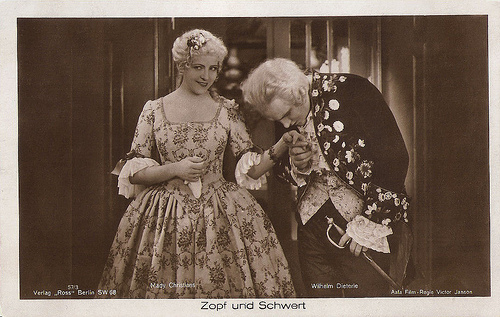
German postcard by Ross Verlag, no. 57/3. Photo: Aafa Film. Mady Christians and Wilhelm (William) Dieterle in Zopf und Schwert - Die tolle Prinzessin (Victor Janson, 1926).

German postcard by Ross Verlag, no. 91/4. Photo: Aafa Film. Publicity still for Der Bettelstudent/The Beggar Student (Jacob Fleck, Luise Fleck, 1927) with Maria Paudler and Ernst Verebes .
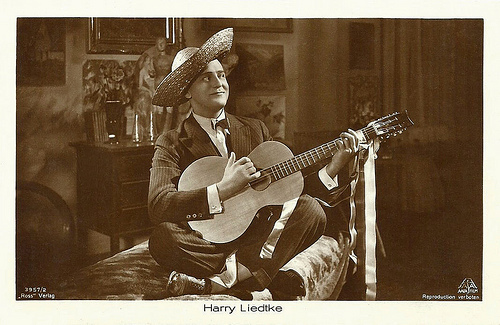
Harry Liedtke . German postcard by Ross Verlag, no. 3957/2, 1928-1929. Photo: Aafa Film.
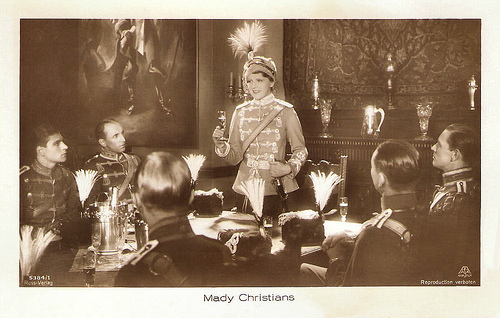
German postcard by Ross Verlag, no. 5384/1, 1930-1931. Photo: Aafa Film. Publicity still for Leutnant warst Du einst bei deinen Husaren/Lieutenant were you once with your Hussar (Manfred Noa, 1930) with Mady Christians .
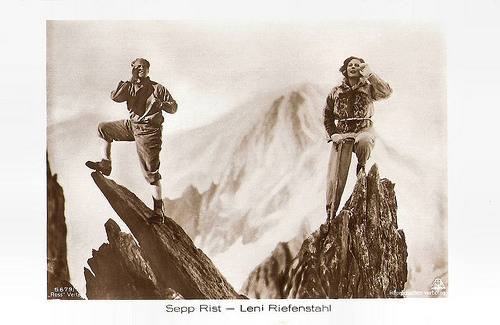
German postcard by Ross Verlag, no. 5679/1, 1930-1931. Photo: Aafa-Film. Publicity still for Stürme über dem Mont Blanc/Storm Over Mont Blanc (Arnold Fanck, 1930) with Leni Riefenstahl and Sepp Rist .
Italian Strongman
The predecessor of Aafa was the Radio Film AG company founded on 2 June 1920. Already on 10 July 1920, the first stock exchange listing took place, and during the year 1921 there was a strong expansion.
The Radio Film AG first took over the companies of Gustav Althoff in Berlin, Hamburg, Dortmund, Cologne, Frankfurt a. M., Munich, Wroclaw and Gdansk. Later, the Ambos Film Export Dworsky & Levy KG led by film director and producer Rudolf Dworsky and producer and merchant Gabriel Levy and the company Ambos Film GmbH were added.
As a result of these acquisitions, Radio-Film AG was renamed just one year after its founding and went public again on March 20, 1921 under the new name Aafa stood for Althoff-Ambos-Film AG. According to a stock market listing, the stock was listed on the open market in Hanover. Rudolf Walther-Fein mostly directed and produced the films, Rudolf Dworsky was responsible for the artistic direction and Gabriel Levy was the studio head.
One of the first films produced by Aafa-Film was Nur eine Nacht/Only One Night (Rudolf Walther-Fein, 1922) starring Bruno Eichgrün, Joseph Römer and Olga Engl. It was one of several German silent films featuring the detective Nick Carter.
The company produced a large number of films in the silent film era. Among them were productions with film stars like Maria Paudler , Harry Liedtke and Mady Christians .
Very popular were the films with the Italian strongman Luciano Albertini, like the silent adventure film Rinaldo Rinaldini (Max Obal, Rudolf Dworsky, 1927) in which Albertini co-starred with Olga Engl and Grit Haid . It is an Italian-set Swashbuckler, based on Christian August Vulpius's 1797 novel 'Rinaldo Rinaldini, the Robber Captain'.
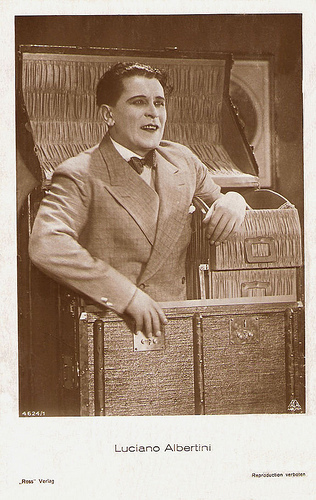
Luciano Albertini. German postcard by Ross Verlag, no. 4624/1, 1929-1930. Photo: Aafa-Film.
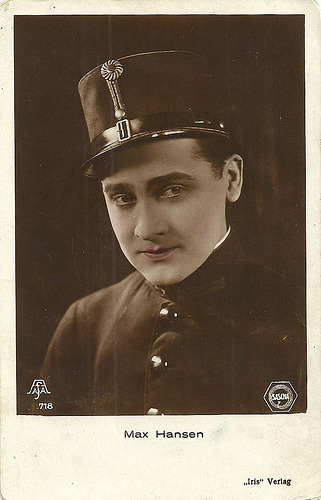
Max Hansen . Austrian postcard by Iris Verlag, no. 718. Photo: Aafa / Sascha Film.
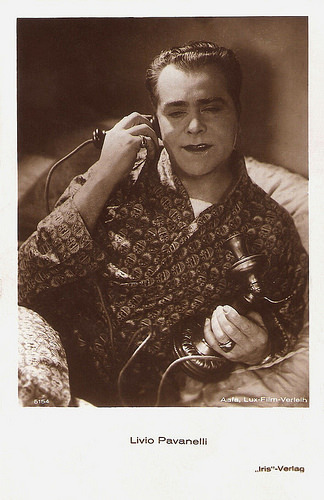
Livio Pavanelli . Austrian postcard by Iris Verlag, no. 5154. Photo: Aafa / Lux Film Verleih.
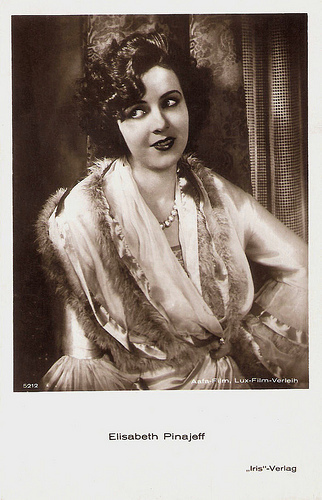
Elisabeth Pinajeff. Austrian postcard by Iris-Verlag, no. 5212. Photo: Aafa / Lux Film Verleih.
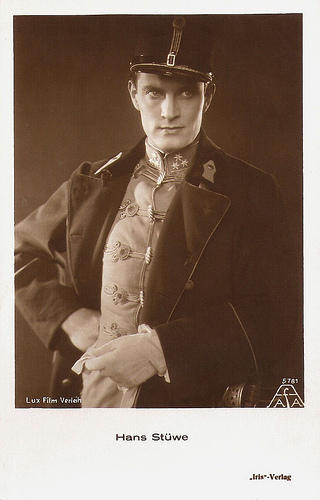
Hans Stüwe . Austrian postcard by Iris Verlag, no. 5781. Photo: Aafa / Lux Film Verleih.
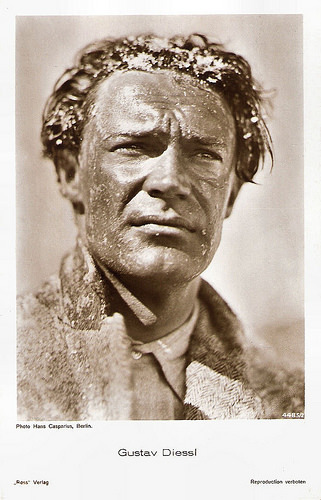
Gustav Diessl . German postcard by Ross Verlag, no. 4485/2, 1929-1930. Photo: Hans Casparius, Berlin. Publicity still for Die weiße Hölle vom Piz Palü/The White Hell of Pitz Palu (Arnold Fanck, G.W. Pabst, 1929).
The first German full sound film
Aafa-Film made the first German full sound film - as opposed to part-sound films or silent films with sound added later - Dich hab’ ich geliebt/It's You I Have Loved (Rudolf Walther-Fein, 1929) with Mady Christians and Hans Stüwe . It was a box office hit and was also released in the US.
Aafa then made a multi-language version musical Leutnant, warst du einst bei den Husaren/Lieutenant, Were You Once a Hussar? (1930). Another popular film operetta was Der Bettelstudent/The Beggar Student (Victo also released in the US.
Aafa then made a multi-language version musical Leut r Janson, 1931) starring Hans-Heinz Bollmann, Jarmila Novotná and Fritz Schulz. The film was based on the 1882 operetta Der Bettelstudent. A British version of the film, The Beggar Student, was also released the same year.
During the late 1920s and early 1930s, Aafa produced a number of mountain films directed by Arnold Fanck. These were Die weiße Hölle vom Piz Palü/White Hell of Pitz Palu (Arnold Fanck, Georg Wilhelm Pabst, 1929) with Gustav Diessl and Leni Riefenstahl , Stürme über dem Mont Blanc/Storm over Mont Blanc (Arnold Fanck, 1930), with Sepp Rist and Leni Riefenstahl , and Der weiße Rausch – neue Wunder des Schneeschuhs/The White Ecstasy (Arnold Fanck, 1931), again with Leni Riefenstahl .
Rudolf Dworsky had died after a car accident in 1927 and the Jewish Gabriel Levy led the company until October 1934. His last German production was the Gerhart Hauptmann adaptation Hanneles Himmelfahrt (Thea von Harbou, 1934) with Inge Landgut as Hannele, and Rudolf Klein-Rogge as her stepfather.
Aafa also produced the classic Belgian film De Witte/The White (Jan Vanderheyden, 1934) about a smart but naughty farmhand's son (Jefke Bruyninckx) whose eternal mischief, pranks and disobedience drive his elders and classmates to despair.
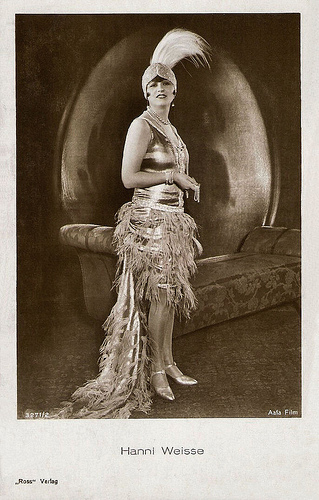
Hanni Weisse . German postcard by Ross Verlag, no. 3271/2, 1928-1929. Photo: Aafa Film.
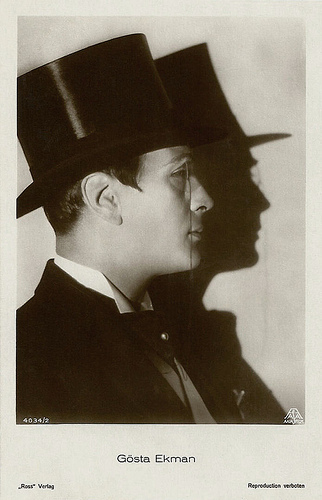
Gösta Ekman . German postcard. by Ross Verlag, no. 4034/2, 1929-1930. Photo: Aafa Film.
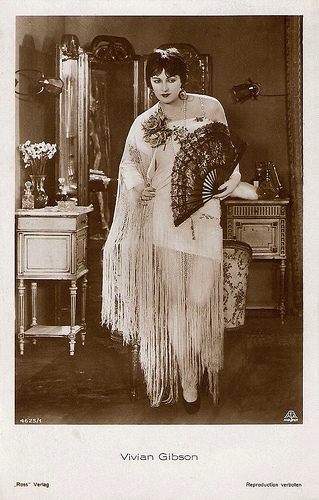
Vivian Gibson . German postcard by Ross Verlag, no. 4625/1, 1929-1930. Photo: Aafa Film.
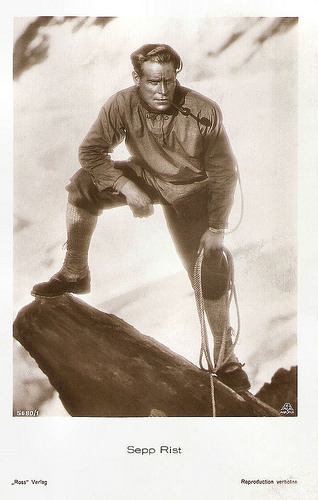
Sepp Rist . German postcard by Ross Verlag, no. 5680/1, 1930-1931. Photo: Aafa-Film. Publicity still for Stürme über dem Mont Blanc/Storm Over Mont Blanc (Arnold Fanck, 1930).
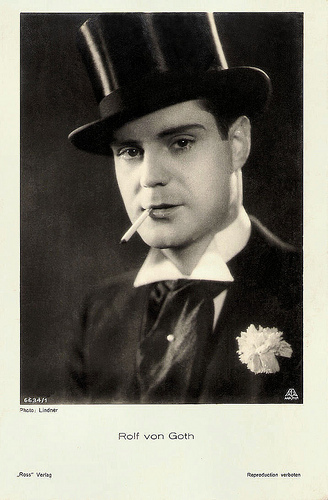
Rolf von Goth. German postcard by Ross Verlag, no. 6634/1, 1931-1932. Photo: Aafa-Film / Lindner.
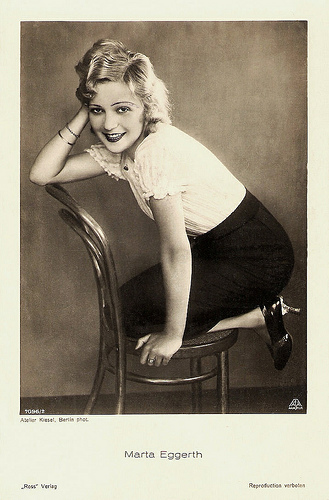
Marta Eggerth . German postcard by Ross Verlag, no. 7096/2, 1932-1933. Photo: Atelier Kiesel, Berlin / Aafa Film.
Aryanisation measures
Then the National Socialists forcibly disbanded Aafa. There was a forced bankruptcy and Aafa was no longer listed in the manual of German stock companies. The Nazi Party confiscated businesses from Jewish ownership in the course of their Aryanisation measures. This was also part of a wider move which led to production being concentrated in the hands of four major studios: Bavaria, Tobis, Terra and UFA.
Gabriel Levy left Germany in 1935 and settled in the Netherlands. In 1935, he produced the Dutch comedy De kribbebijter/The Cross-Patch (Hermann Kosterlitz a.k.a. Henry Koster, Ernst Winar, 1935) with Cor Ruys.
At the beginning of 1937, he committed the also exiled producer Hermann Millakowsky as Rental Manager of Milo-Films. In 1938, a tax record was issued to Levy and his wife in Berlin for payment of 'Reichsfluchtsteuer' (Reich Flight Tax) in the amount of 44,000 RM.
The 'Reichsfluchtsteuer' was a capital control law implemented by the Weimar Government in order to stem capital flight from the Republic. The tax was used by the Nazis as a 'partial expropriation' of the assets of Jewish refugees who were persecuted and driven to flee their homeland.)
In June 1939, Levy was expatriated from Germany. He was no longer able to continue working as a producer the Netherlands and did not make another film until after the war. Then he produced the comedy Een Koninkrijk voor een huis/A Kingdom for a House (Jaap Speyer, 1948) with Heintje Davids and Johan Kaart . It would be his final film. Gabriel Levy died in Amsterdam in 1965.
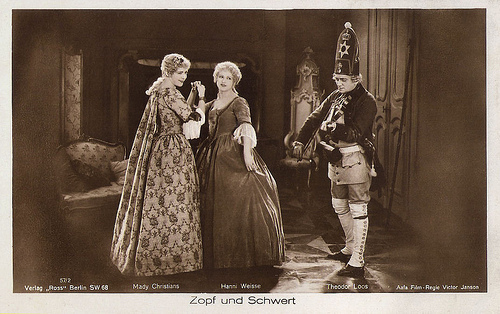
German postcard by Ross Verlag, no. 57/2. Photo: Aafa Film. Mady Christians and Wilhelm Dieterle in Zopf und Schwert - Die tolle Prinzessin (Victor Janson, 1926).
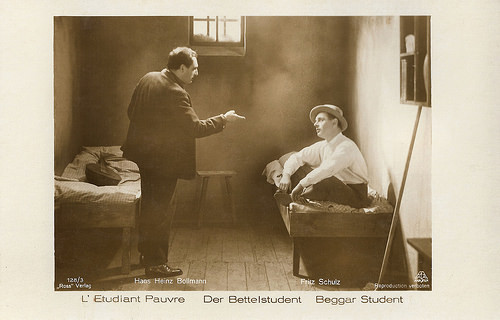
German postcard by Ross Verlag, no. 128/3. Photo: Aafa Film. Publicity still for Der Bettelstudent/The Beggar Student (Victor Janson, 1931) with Hans Heinz Bollmann and Fritz Schulz .
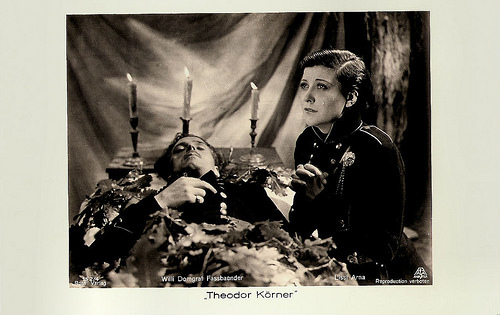
German postcard by Ross Verlag, no. 152/4, 1932. Photo: Aafa Film. Publicity still for Theodor Körner (Carl Boese, 1932) with Lissi Arna and Willi Domgraf-Fassbaender .
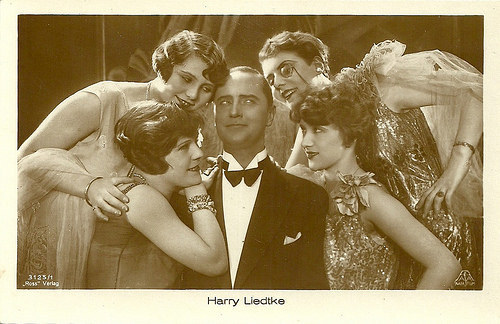
Harry Liedtke . German postcard by Ross Verlag, no. 3125/1. Photo: Aafa Film.
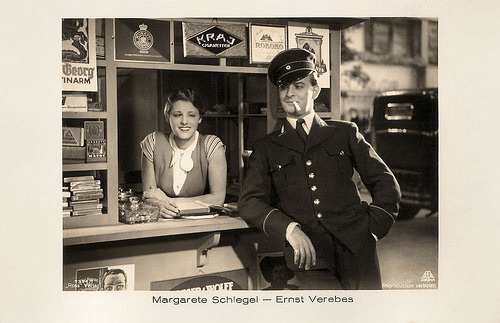
German postcard by Ross Verlag, no. 7394/1, 1932-1933. Photo: Aafa Film. Publicity still for Das blaue vom Himmel/The Blue from the Sky (Victor Janson, 1932) with Margarete Schlegel and Ernst Verebes .
Sources: Wikipedia (English and German) and IMDb.

German postcard by Ross Verlag, no. 57/3. Photo: Aafa Film. Mady Christians and Wilhelm (William) Dieterle in Zopf und Schwert - Die tolle Prinzessin (Victor Janson, 1926).

German postcard by Ross Verlag, no. 91/4. Photo: Aafa Film. Publicity still for Der Bettelstudent/The Beggar Student (Jacob Fleck, Luise Fleck, 1927) with Maria Paudler and Ernst Verebes .

Harry Liedtke . German postcard by Ross Verlag, no. 3957/2, 1928-1929. Photo: Aafa Film.

German postcard by Ross Verlag, no. 5384/1, 1930-1931. Photo: Aafa Film. Publicity still for Leutnant warst Du einst bei deinen Husaren/Lieutenant were you once with your Hussar (Manfred Noa, 1930) with Mady Christians .

German postcard by Ross Verlag, no. 5679/1, 1930-1931. Photo: Aafa-Film. Publicity still for Stürme über dem Mont Blanc/Storm Over Mont Blanc (Arnold Fanck, 1930) with Leni Riefenstahl and Sepp Rist .
Italian Strongman
The predecessor of Aafa was the Radio Film AG company founded on 2 June 1920. Already on 10 July 1920, the first stock exchange listing took place, and during the year 1921 there was a strong expansion.
The Radio Film AG first took over the companies of Gustav Althoff in Berlin, Hamburg, Dortmund, Cologne, Frankfurt a. M., Munich, Wroclaw and Gdansk. Later, the Ambos Film Export Dworsky & Levy KG led by film director and producer Rudolf Dworsky and producer and merchant Gabriel Levy and the company Ambos Film GmbH were added.
As a result of these acquisitions, Radio-Film AG was renamed just one year after its founding and went public again on March 20, 1921 under the new name Aafa stood for Althoff-Ambos-Film AG. According to a stock market listing, the stock was listed on the open market in Hanover. Rudolf Walther-Fein mostly directed and produced the films, Rudolf Dworsky was responsible for the artistic direction and Gabriel Levy was the studio head.
One of the first films produced by Aafa-Film was Nur eine Nacht/Only One Night (Rudolf Walther-Fein, 1922) starring Bruno Eichgrün, Joseph Römer and Olga Engl. It was one of several German silent films featuring the detective Nick Carter.
The company produced a large number of films in the silent film era. Among them were productions with film stars like Maria Paudler , Harry Liedtke and Mady Christians .
Very popular were the films with the Italian strongman Luciano Albertini, like the silent adventure film Rinaldo Rinaldini (Max Obal, Rudolf Dworsky, 1927) in which Albertini co-starred with Olga Engl and Grit Haid . It is an Italian-set Swashbuckler, based on Christian August Vulpius's 1797 novel 'Rinaldo Rinaldini, the Robber Captain'.

Luciano Albertini. German postcard by Ross Verlag, no. 4624/1, 1929-1930. Photo: Aafa-Film.

Max Hansen . Austrian postcard by Iris Verlag, no. 718. Photo: Aafa / Sascha Film.

Livio Pavanelli . Austrian postcard by Iris Verlag, no. 5154. Photo: Aafa / Lux Film Verleih.

Elisabeth Pinajeff. Austrian postcard by Iris-Verlag, no. 5212. Photo: Aafa / Lux Film Verleih.

Hans Stüwe . Austrian postcard by Iris Verlag, no. 5781. Photo: Aafa / Lux Film Verleih.

Gustav Diessl . German postcard by Ross Verlag, no. 4485/2, 1929-1930. Photo: Hans Casparius, Berlin. Publicity still for Die weiße Hölle vom Piz Palü/The White Hell of Pitz Palu (Arnold Fanck, G.W. Pabst, 1929).
The first German full sound film
Aafa-Film made the first German full sound film - as opposed to part-sound films or silent films with sound added later - Dich hab’ ich geliebt/It's You I Have Loved (Rudolf Walther-Fein, 1929) with Mady Christians and Hans Stüwe . It was a box office hit and was also released in the US.
Aafa then made a multi-language version musical Leutnant, warst du einst bei den Husaren/Lieutenant, Were You Once a Hussar? (1930). Another popular film operetta was Der Bettelstudent/The Beggar Student (Victo also released in the US.
Aafa then made a multi-language version musical Leut r Janson, 1931) starring Hans-Heinz Bollmann, Jarmila Novotná and Fritz Schulz. The film was based on the 1882 operetta Der Bettelstudent. A British version of the film, The Beggar Student, was also released the same year.
During the late 1920s and early 1930s, Aafa produced a number of mountain films directed by Arnold Fanck. These were Die weiße Hölle vom Piz Palü/White Hell of Pitz Palu (Arnold Fanck, Georg Wilhelm Pabst, 1929) with Gustav Diessl and Leni Riefenstahl , Stürme über dem Mont Blanc/Storm over Mont Blanc (Arnold Fanck, 1930), with Sepp Rist and Leni Riefenstahl , and Der weiße Rausch – neue Wunder des Schneeschuhs/The White Ecstasy (Arnold Fanck, 1931), again with Leni Riefenstahl .
Rudolf Dworsky had died after a car accident in 1927 and the Jewish Gabriel Levy led the company until October 1934. His last German production was the Gerhart Hauptmann adaptation Hanneles Himmelfahrt (Thea von Harbou, 1934) with Inge Landgut as Hannele, and Rudolf Klein-Rogge as her stepfather.
Aafa also produced the classic Belgian film De Witte/The White (Jan Vanderheyden, 1934) about a smart but naughty farmhand's son (Jefke Bruyninckx) whose eternal mischief, pranks and disobedience drive his elders and classmates to despair.

Hanni Weisse . German postcard by Ross Verlag, no. 3271/2, 1928-1929. Photo: Aafa Film.

Gösta Ekman . German postcard. by Ross Verlag, no. 4034/2, 1929-1930. Photo: Aafa Film.

Vivian Gibson . German postcard by Ross Verlag, no. 4625/1, 1929-1930. Photo: Aafa Film.

Sepp Rist . German postcard by Ross Verlag, no. 5680/1, 1930-1931. Photo: Aafa-Film. Publicity still for Stürme über dem Mont Blanc/Storm Over Mont Blanc (Arnold Fanck, 1930).

Rolf von Goth. German postcard by Ross Verlag, no. 6634/1, 1931-1932. Photo: Aafa-Film / Lindner.

Marta Eggerth . German postcard by Ross Verlag, no. 7096/2, 1932-1933. Photo: Atelier Kiesel, Berlin / Aafa Film.
Aryanisation measures
Then the National Socialists forcibly disbanded Aafa. There was a forced bankruptcy and Aafa was no longer listed in the manual of German stock companies. The Nazi Party confiscated businesses from Jewish ownership in the course of their Aryanisation measures. This was also part of a wider move which led to production being concentrated in the hands of four major studios: Bavaria, Tobis, Terra and UFA.
Gabriel Levy left Germany in 1935 and settled in the Netherlands. In 1935, he produced the Dutch comedy De kribbebijter/The Cross-Patch (Hermann Kosterlitz a.k.a. Henry Koster, Ernst Winar, 1935) with Cor Ruys.
At the beginning of 1937, he committed the also exiled producer Hermann Millakowsky as Rental Manager of Milo-Films. In 1938, a tax record was issued to Levy and his wife in Berlin for payment of 'Reichsfluchtsteuer' (Reich Flight Tax) in the amount of 44,000 RM.
The 'Reichsfluchtsteuer' was a capital control law implemented by the Weimar Government in order to stem capital flight from the Republic. The tax was used by the Nazis as a 'partial expropriation' of the assets of Jewish refugees who were persecuted and driven to flee their homeland.)
In June 1939, Levy was expatriated from Germany. He was no longer able to continue working as a producer the Netherlands and did not make another film until after the war. Then he produced the comedy Een Koninkrijk voor een huis/A Kingdom for a House (Jaap Speyer, 1948) with Heintje Davids and Johan Kaart . It would be his final film. Gabriel Levy died in Amsterdam in 1965.

German postcard by Ross Verlag, no. 57/2. Photo: Aafa Film. Mady Christians and Wilhelm Dieterle in Zopf und Schwert - Die tolle Prinzessin (Victor Janson, 1926).

German postcard by Ross Verlag, no. 128/3. Photo: Aafa Film. Publicity still for Der Bettelstudent/The Beggar Student (Victor Janson, 1931) with Hans Heinz Bollmann and Fritz Schulz .

German postcard by Ross Verlag, no. 152/4, 1932. Photo: Aafa Film. Publicity still for Theodor Körner (Carl Boese, 1932) with Lissi Arna and Willi Domgraf-Fassbaender .

Harry Liedtke . German postcard by Ross Verlag, no. 3125/1. Photo: Aafa Film.

German postcard by Ross Verlag, no. 7394/1, 1932-1933. Photo: Aafa Film. Publicity still for Das blaue vom Himmel/The Blue from the Sky (Victor Janson, 1932) with Margarete Schlegel and Ernst Verebes .
Sources: Wikipedia (English and German) and IMDb.
Published on April 05, 2019 22:00
April 4, 2019
Linda Darnell
American film actress Linda Darnell (1923-1965) progressed from modelling as a child to acting in theatre and film as an adolescent. The ravishing beauty appeared in supporting roles in big-budget films for 20th Century Fox throughout the 1940s, and rose to fame with co-starring roles opposite Tyrone Power in adventure films. She established a main character career after her role in Forever Amber (1947), and won critical acclaim for her work in Unfaithfully Yours (1948) and A Letter to Three Wives (1949).
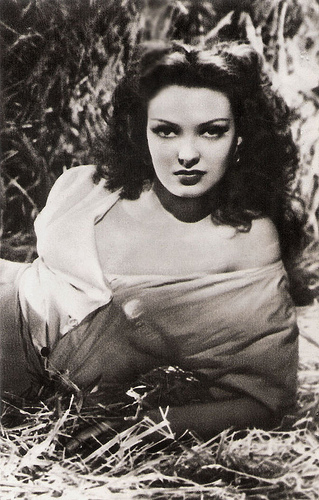
Spanish postcard by Falgra, Barcelona, no. 1136. Photo: United Artists. Publicity still for Summer Storm (Douglas Sirk, 1944).
The most physically perfect girl in Hollywood
Monetta Eloyse Darnell was born in Dallas, Texas, in 1923, as one of four children to postal clerk Calvin Roy Darnell and the former Pearl Brown. She was the younger sister of Undeen and the older sister of Monte Maloya and Calvin Roy, Jr. Her parents were not happily married, and she grew up as a shy and reserved girl in a house of domestic turmoil.
Starting at an early age, her mother Pearl had big plans for Darnell in the entertainment industry. She believed that Linda was her only child with potential as an actress and ignored the rearing of her other children. Darnell was a model by the age of 11 and was acting on the stage by the age of 13. She initially started modelling to earn money for the household, and performed mostly in beauty contests.
Darnell was a student at Sunset High School, when in November 1937, a talent scout for 20th Century Fox arrived in Dallas, looking for new faces. Encouraged by her mother, Darnell met him, and after a few months, he invited her for a screen test in Hollywood. In California, Darnell was initially rejected by film studios and was sent home because she was declared "too young". Darnell was featured in a ‘Gateway to Hollywood’ talent-search and landed a contract at RKO Pictures. There was no certainty, though, and she soon returned to Dallas.
When 20th Century Fox offered her a part, Darnell wanted to accept, but RKO was unwilling to release her. Nevertheless, by age 15, she was signed to a contract at 20th Century Fox and moved to a small apartment in Hollywood all alone in 1939. Her first film was Hotel for Women (Gregory Ratoff, 1939), which had newspapers immediately hailing her as the newest star of Hollywood. Loretta Young was originally assigned to play the role, but demanded a salary which the studio would not give her. Darryl F. Zanuck instead cast Darnell, advertise her beauty and suggested a Latin quality.
Although only 15 at the time, Darnell posed as a 17-year-old and was listed as 19 years old by the studio. Her true age came out later in 1939, and she became one of the few actresses under the age of 16 to serve as leading ladies in films. Linda Darnell was assigned to the female lead opposite Tyrone Power in the light romantic comedy Day-Time Wife (Gregory Ratoff, 1939). Although the film received only slightly favourable reviews, Darnell's performance was received positively for her breath-taking looks and splendid acting.
Life magazine stated that Darnell was "the most physically perfect girl in Hollywood". Following the film's release, she was cast in the drama comedy Star Dust (Walter Lang, 1940) with John Payne. The film was hailed as one of the "most original entertainment idea in years" and boosted Darnell's popularity, being nicknamed 'Hollywood's loveliest and most exciting star'.
After appearing in several small films, Darnell was cast in her first big-budget film opposite Tyrone Power in Brigham Young (Henry Hathaway, 1940), regarded as the most expensive film 20th Century Fox had yet produced. Darnell and Power were cast together for the second time due to the box office success of Day-Time Wife, and they became a highly publicised onscreen couple, which prompted Darryl F. Zanuck to add 18 more romantic scenes to Brigham Young.
Darnell began working on the big-budget adventure The Mark of Zorro (Rouben Mamoulian, 1940), in which she again co-starred as Power's sweetheart. Critics raved over the film. The Mark of Zorro was a box office sensation and did much to enhance Darnell's star status. Afterwards, she was paired with Henry Fonda for the first time in the western Chad Hanna (Henry King, 1940), her first Technicolor film.
The film received only little attention, unlike Darnell's next film Blood and Sand (Rouben Mamoulian, 1941), in which she was reteamed with Power. It was the first film for which she was widely critically acclaimed. Thereafter the studio was unable to find her suitable roles. Darnell was disappointed and felt rejected. Months passed by without any work, and in August 1941, she was cast in a supporting role in the musical Rise and Shine (Allan Dwan, 1941). The film was a setback in her career, and she was rejected for a later role because she refused to respond to Darryl F. Zanuck's advances. Instead, she contributed to the war effort, working for the Red Cross, selling war bonds, and she was a regular at the Hollywood Canteen.
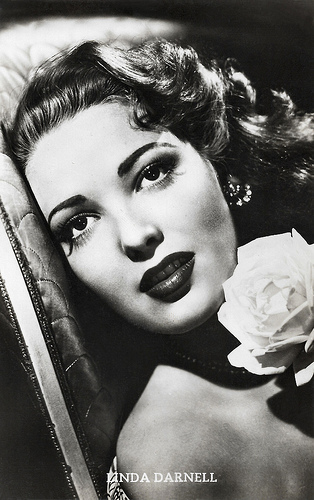
Belgian postcard, no. 750. Photo: 20th Century-Fox.
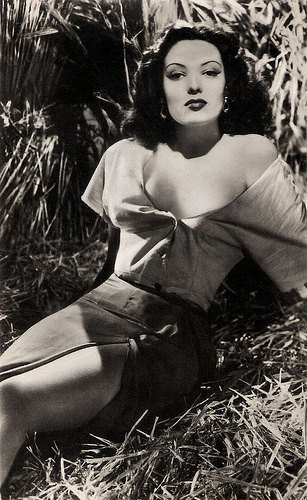
Spanish postcard. Photo: United Artists. Publicity still for Summer Storm (Douglas Sirk, 1944).
A new screen image as a pin-up girl
Linda Darnell and Twentieth Century-Fox weren't on the best of terms, and as a punishment, she was loaned out to Columbia for a supporting role in a B-film called City Without Men (Sidney Salkow, 1942). In 1943, she was put on suspension. Darnell had married, which caused the fury of Zanuck. Darnell was reduced to second leads and was overlooked for big-budget productions.
Matters changed in 1944 when Look Magazine named her one of the four most beautiful women in Hollywood, along with Hedy Lamarr , Ingrid Bergman , and Gene Tierney . The studio allowed her to be loaned out for the lead in Summer Storm (Douglas Sirk, 1944), opposite George Sanders. She played a type of role she had never before: a seductive peasant girl who takes three men to their ruin before she herself is murdered. The film provided her a new screen image as a pin-up girl.
Shortly after, Darnell was again loaned out to portray a showgirl in The Great John L. (Frank Tuttle, 1945), the first film to feature her bare legs. Darnell complained that the studio lacked recognition of her, which prodded Zanuck to cast her in the Film Noir Hangover Square (John Brahm, 1945), playing a role she personally had chosen. The film became a great success, and she was added to the cast of another Film Noir, Fallen Angel (Otto Preminger, 1945), which also included Dana Andrews and Alice Faye.
Despite suffering from the "terrifying" Preminger, Darnell was praised by reviewers so widely that there was even talk of an Oscar nomination. In 1946, Darnell filmed two pictures simultaneously, the expensively budgeted Anna and the King of Siam (John Cromwell, 1946) with Irene Dunne, and Centennial Summer (Otto Preminger, 1946) with the legendary Lillian Gish .
Then she went on location in Monument Valley for the classic Western My Darling Clementine (John Ford, 1946) with Henry Fonda end Victor Mature . It was another hit and garnered Linda some of the best reviews of her career.
In 1946, Linda Darnell won the starring role in the highly anticipated romantic drama Forever Amber (Otto Preminger, 1947), based on a bestselling historical novel that was denounced as being immoral at that time. Although she had to work with Preminger, she was delighted to play the title role. However, Forever Amber did not live up to its hype, and although it became a success at the box office, most reviewers agreed that the film was a disappointment.
The following year, Darnell portrayed Daphne de Carter in the comedy Unfaithfully Yours (Preston Sturges, 1948), also starring Rex Harrison , and was then one of the three wives in the comedy/drama A Letter to Three Wives (Joseph L. Mankiewicz, 1949). Darnell's hard-edged performance in the latter won her unanimous acclaim and the best reviews of her career.
Darnell became one of the most-demanded actresses in Hollywood, and she now had the freedom to select her own roles. She was cast opposite Richard Widmark and Veronica Lake in Slattery's Hurricane (Andre DeToth, 1949), which she perceived as a step down from the level she had reached with A Letter to Three Wives, though it did well at the box office.
She then co-starred opposite Richard Widmark and Sidney Poitier in the groundbreaking No Way Out (Joseph L. Mankiewicz, 1950). But her later films were rarely noteworthy, and her appearances were increasingly sporadic. Further hampering Darnell's career was the actress's alcoholism and weight gain. Her next films included the Western, Two Flags West (Robert Wise, 1950), The 13th Letter (Otto Preminger, 1951) and The Guy Who Came Back (Joseph M. Newman, 1951).
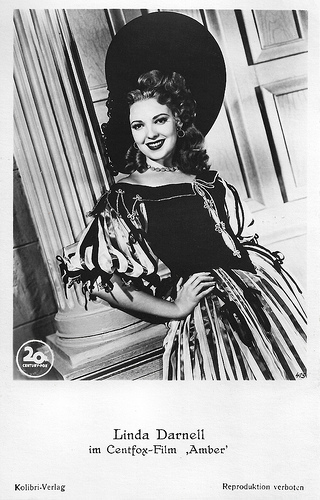
German postcard by Kolibri-Verlag. Photo: 20th Century-Fox. Publicity still for Forever Amber (Otto Preminger, 1947).
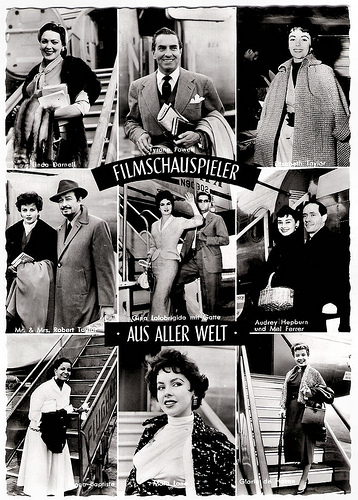
German postcard by Kunst und Film Verlag H. Lukow, Hannover, no. L2/1042. Caption: Filmschauspieler aus aller Welt (Film actors from around the world).
From top left to down right: Linda Darnell, Tyrone Power, Elizabeth Taylor , Robert Taylor and his wife Ursula Thiess , Gina Lollobrigida and her husband Milko Skofic, Audrey Hepburn and Mel Ferrer, Mona Baptiste, Mara Lane and Gloria de Haven.
Alcohol addiction and weight problems
In 1951, Linda Darnell signed a new contract with 20th Century Fox that allowed her to become a freelance actress. Her first film outside 20th Century Fox was for Universal Pictures, The Lady Pays Off (Douglas Sirk, 1951). She was responsible for putting the film behind schedule, because on the fifth day of shooting, she learned that Ivan Kahn, the man responsible for her breakthrough, had died.
Darnell then headed the cast of the British romantic war film Saturday Island (Stuart Heisler, 1952), which co-starred Tab Hunter and was filmed on location in Jamaica. There, Darnell fell ill and had to be quarantined for several weeks. Because her contract required her to make one film a year for the studio, she reported to the lot of 20th Century Fox for the Film Noir Night Without Sleep (Roy Ward Baker, 1952) with Gary Merrill and Hildegard Knef . It was the only time that she had to live up to this part of her contract, since she was released from it in September 1952.
The competition of television forced studios all over Hollywood to drop actors. This news initially excited Darnell, because it permitted her to focus on her film career in Europe, but the ease and protection enjoyed under contract was gone. Before travelling to Italy for a two-picture deal with Giuseppe Amato, Darnell was rushed into the production of Blackbeard the Pirate (Raoul Walsh, 1952). In Italy she made Donne proibite/Angels of Darkness (Giuseppe Amato, 1954) with Valentina Cortese and Giulietta Masina . The second collaboration, the French-Italian comedy Gli ultimi cinque minuti/The Last Five Minutes (Giuseppe Amato, 1955) with Vittorio De Sica and Peppino De Filippo proved disastrous, and was never released in the United States.
Back in Hollywood, she accepted an offer from Howard Hughes to star in RKO's 3-D film Second Chance (Rudolph Maté, 1953) with Robert Mitchum , filmed in Mexico. Because of her then-husband, Philip Liebmann, Darnell put her career on a hiatus. In 1955, she returned to 20th Century Fox, by which time the studio had entered the television field. She guest-starred in series like Cimarron City and Wagon Train, and also returned to the stage.
Linda Darnell’s last work as an actress was in a stage production in Atlanta in early 1965. At the time of her death a few months later, she was preparing to perform in another play. She died in 1965, from burns she received in a house fire in Glenview, a suburb of Chicago. The house of her former secretary and agent caught on fire in the early morning and Darnell died that afternoon in Cook County Hospital.
Linda Darnell was only 41. She had been married three times. In 1943, at age 19, she eloped with 42-year-old cameraman Peverell Marley in Las Vegas. Marley was a heavy drinker and introduced Darnell to alcohol, which eventually led to an addiction and weight problems. In 1946, during production of Centennial Summer, she fell in love with womanising millionaire Howard Hughes. She separated from Marley but when Hughes announced that he had no desire to marry her, Darnell returned to her husband. Because Darnell and Marley were unable to have children, they adopted a daughter, Charlotte Mildred 'Lola' Marley (1948), the actress's only child.
In mid-1948, she became romantically involved with director Joseph L. Mankiewicz, and filed for divorce. Mankiewicz, however, did not want to leave his wife for Darnell, and though the affair continued for six years, she again returned to her husband. In 1949, Darnell went into psychotherapy for hostile emotions that she had been building since childhood. Darnell and Marley finally divorced in 1951.
In 1954, she married brewery heir Philip Liebmann but the marriage ended in 1955 on grounds of incompatibility. From 1957 to 1963, Linda Darnell was married to pilot Merle Roy Robertson. Darnell's final screen appearance was opposite Rory Calhoun in the low-budget Western Black Spurs (R.G. Springsteen, 1965).
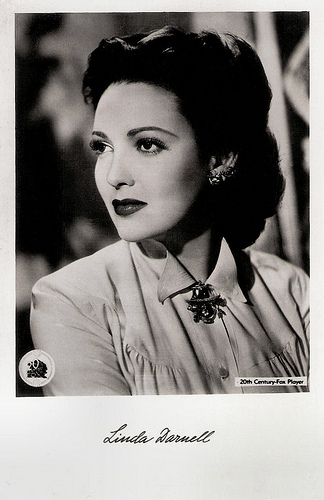
Vintage postcard. Photo: 20th Century-Fox.
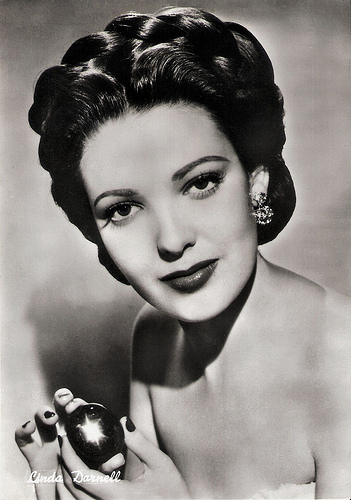
Italian postcard by Bromofoto, Milano, no. 216.
Sources: (IMDb), Wikipedia and .

Spanish postcard by Falgra, Barcelona, no. 1136. Photo: United Artists. Publicity still for Summer Storm (Douglas Sirk, 1944).
The most physically perfect girl in Hollywood
Monetta Eloyse Darnell was born in Dallas, Texas, in 1923, as one of four children to postal clerk Calvin Roy Darnell and the former Pearl Brown. She was the younger sister of Undeen and the older sister of Monte Maloya and Calvin Roy, Jr. Her parents were not happily married, and she grew up as a shy and reserved girl in a house of domestic turmoil.
Starting at an early age, her mother Pearl had big plans for Darnell in the entertainment industry. She believed that Linda was her only child with potential as an actress and ignored the rearing of her other children. Darnell was a model by the age of 11 and was acting on the stage by the age of 13. She initially started modelling to earn money for the household, and performed mostly in beauty contests.
Darnell was a student at Sunset High School, when in November 1937, a talent scout for 20th Century Fox arrived in Dallas, looking for new faces. Encouraged by her mother, Darnell met him, and after a few months, he invited her for a screen test in Hollywood. In California, Darnell was initially rejected by film studios and was sent home because she was declared "too young". Darnell was featured in a ‘Gateway to Hollywood’ talent-search and landed a contract at RKO Pictures. There was no certainty, though, and she soon returned to Dallas.
When 20th Century Fox offered her a part, Darnell wanted to accept, but RKO was unwilling to release her. Nevertheless, by age 15, she was signed to a contract at 20th Century Fox and moved to a small apartment in Hollywood all alone in 1939. Her first film was Hotel for Women (Gregory Ratoff, 1939), which had newspapers immediately hailing her as the newest star of Hollywood. Loretta Young was originally assigned to play the role, but demanded a salary which the studio would not give her. Darryl F. Zanuck instead cast Darnell, advertise her beauty and suggested a Latin quality.
Although only 15 at the time, Darnell posed as a 17-year-old and was listed as 19 years old by the studio. Her true age came out later in 1939, and she became one of the few actresses under the age of 16 to serve as leading ladies in films. Linda Darnell was assigned to the female lead opposite Tyrone Power in the light romantic comedy Day-Time Wife (Gregory Ratoff, 1939). Although the film received only slightly favourable reviews, Darnell's performance was received positively for her breath-taking looks and splendid acting.
Life magazine stated that Darnell was "the most physically perfect girl in Hollywood". Following the film's release, she was cast in the drama comedy Star Dust (Walter Lang, 1940) with John Payne. The film was hailed as one of the "most original entertainment idea in years" and boosted Darnell's popularity, being nicknamed 'Hollywood's loveliest and most exciting star'.
After appearing in several small films, Darnell was cast in her first big-budget film opposite Tyrone Power in Brigham Young (Henry Hathaway, 1940), regarded as the most expensive film 20th Century Fox had yet produced. Darnell and Power were cast together for the second time due to the box office success of Day-Time Wife, and they became a highly publicised onscreen couple, which prompted Darryl F. Zanuck to add 18 more romantic scenes to Brigham Young.
Darnell began working on the big-budget adventure The Mark of Zorro (Rouben Mamoulian, 1940), in which she again co-starred as Power's sweetheart. Critics raved over the film. The Mark of Zorro was a box office sensation and did much to enhance Darnell's star status. Afterwards, she was paired with Henry Fonda for the first time in the western Chad Hanna (Henry King, 1940), her first Technicolor film.
The film received only little attention, unlike Darnell's next film Blood and Sand (Rouben Mamoulian, 1941), in which she was reteamed with Power. It was the first film for which she was widely critically acclaimed. Thereafter the studio was unable to find her suitable roles. Darnell was disappointed and felt rejected. Months passed by without any work, and in August 1941, she was cast in a supporting role in the musical Rise and Shine (Allan Dwan, 1941). The film was a setback in her career, and she was rejected for a later role because she refused to respond to Darryl F. Zanuck's advances. Instead, she contributed to the war effort, working for the Red Cross, selling war bonds, and she was a regular at the Hollywood Canteen.

Belgian postcard, no. 750. Photo: 20th Century-Fox.

Spanish postcard. Photo: United Artists. Publicity still for Summer Storm (Douglas Sirk, 1944).
A new screen image as a pin-up girl
Linda Darnell and Twentieth Century-Fox weren't on the best of terms, and as a punishment, she was loaned out to Columbia for a supporting role in a B-film called City Without Men (Sidney Salkow, 1942). In 1943, she was put on suspension. Darnell had married, which caused the fury of Zanuck. Darnell was reduced to second leads and was overlooked for big-budget productions.
Matters changed in 1944 when Look Magazine named her one of the four most beautiful women in Hollywood, along with Hedy Lamarr , Ingrid Bergman , and Gene Tierney . The studio allowed her to be loaned out for the lead in Summer Storm (Douglas Sirk, 1944), opposite George Sanders. She played a type of role she had never before: a seductive peasant girl who takes three men to their ruin before she herself is murdered. The film provided her a new screen image as a pin-up girl.
Shortly after, Darnell was again loaned out to portray a showgirl in The Great John L. (Frank Tuttle, 1945), the first film to feature her bare legs. Darnell complained that the studio lacked recognition of her, which prodded Zanuck to cast her in the Film Noir Hangover Square (John Brahm, 1945), playing a role she personally had chosen. The film became a great success, and she was added to the cast of another Film Noir, Fallen Angel (Otto Preminger, 1945), which also included Dana Andrews and Alice Faye.
Despite suffering from the "terrifying" Preminger, Darnell was praised by reviewers so widely that there was even talk of an Oscar nomination. In 1946, Darnell filmed two pictures simultaneously, the expensively budgeted Anna and the King of Siam (John Cromwell, 1946) with Irene Dunne, and Centennial Summer (Otto Preminger, 1946) with the legendary Lillian Gish .
Then she went on location in Monument Valley for the classic Western My Darling Clementine (John Ford, 1946) with Henry Fonda end Victor Mature . It was another hit and garnered Linda some of the best reviews of her career.
In 1946, Linda Darnell won the starring role in the highly anticipated romantic drama Forever Amber (Otto Preminger, 1947), based on a bestselling historical novel that was denounced as being immoral at that time. Although she had to work with Preminger, she was delighted to play the title role. However, Forever Amber did not live up to its hype, and although it became a success at the box office, most reviewers agreed that the film was a disappointment.
The following year, Darnell portrayed Daphne de Carter in the comedy Unfaithfully Yours (Preston Sturges, 1948), also starring Rex Harrison , and was then one of the three wives in the comedy/drama A Letter to Three Wives (Joseph L. Mankiewicz, 1949). Darnell's hard-edged performance in the latter won her unanimous acclaim and the best reviews of her career.
Darnell became one of the most-demanded actresses in Hollywood, and she now had the freedom to select her own roles. She was cast opposite Richard Widmark and Veronica Lake in Slattery's Hurricane (Andre DeToth, 1949), which she perceived as a step down from the level she had reached with A Letter to Three Wives, though it did well at the box office.
She then co-starred opposite Richard Widmark and Sidney Poitier in the groundbreaking No Way Out (Joseph L. Mankiewicz, 1950). But her later films were rarely noteworthy, and her appearances were increasingly sporadic. Further hampering Darnell's career was the actress's alcoholism and weight gain. Her next films included the Western, Two Flags West (Robert Wise, 1950), The 13th Letter (Otto Preminger, 1951) and The Guy Who Came Back (Joseph M. Newman, 1951).

German postcard by Kolibri-Verlag. Photo: 20th Century-Fox. Publicity still for Forever Amber (Otto Preminger, 1947).

German postcard by Kunst und Film Verlag H. Lukow, Hannover, no. L2/1042. Caption: Filmschauspieler aus aller Welt (Film actors from around the world).
From top left to down right: Linda Darnell, Tyrone Power, Elizabeth Taylor , Robert Taylor and his wife Ursula Thiess , Gina Lollobrigida and her husband Milko Skofic, Audrey Hepburn and Mel Ferrer, Mona Baptiste, Mara Lane and Gloria de Haven.
Alcohol addiction and weight problems
In 1951, Linda Darnell signed a new contract with 20th Century Fox that allowed her to become a freelance actress. Her first film outside 20th Century Fox was for Universal Pictures, The Lady Pays Off (Douglas Sirk, 1951). She was responsible for putting the film behind schedule, because on the fifth day of shooting, she learned that Ivan Kahn, the man responsible for her breakthrough, had died.
Darnell then headed the cast of the British romantic war film Saturday Island (Stuart Heisler, 1952), which co-starred Tab Hunter and was filmed on location in Jamaica. There, Darnell fell ill and had to be quarantined for several weeks. Because her contract required her to make one film a year for the studio, she reported to the lot of 20th Century Fox for the Film Noir Night Without Sleep (Roy Ward Baker, 1952) with Gary Merrill and Hildegard Knef . It was the only time that she had to live up to this part of her contract, since she was released from it in September 1952.
The competition of television forced studios all over Hollywood to drop actors. This news initially excited Darnell, because it permitted her to focus on her film career in Europe, but the ease and protection enjoyed under contract was gone. Before travelling to Italy for a two-picture deal with Giuseppe Amato, Darnell was rushed into the production of Blackbeard the Pirate (Raoul Walsh, 1952). In Italy she made Donne proibite/Angels of Darkness (Giuseppe Amato, 1954) with Valentina Cortese and Giulietta Masina . The second collaboration, the French-Italian comedy Gli ultimi cinque minuti/The Last Five Minutes (Giuseppe Amato, 1955) with Vittorio De Sica and Peppino De Filippo proved disastrous, and was never released in the United States.
Back in Hollywood, she accepted an offer from Howard Hughes to star in RKO's 3-D film Second Chance (Rudolph Maté, 1953) with Robert Mitchum , filmed in Mexico. Because of her then-husband, Philip Liebmann, Darnell put her career on a hiatus. In 1955, she returned to 20th Century Fox, by which time the studio had entered the television field. She guest-starred in series like Cimarron City and Wagon Train, and also returned to the stage.
Linda Darnell’s last work as an actress was in a stage production in Atlanta in early 1965. At the time of her death a few months later, she was preparing to perform in another play. She died in 1965, from burns she received in a house fire in Glenview, a suburb of Chicago. The house of her former secretary and agent caught on fire in the early morning and Darnell died that afternoon in Cook County Hospital.
Linda Darnell was only 41. She had been married three times. In 1943, at age 19, she eloped with 42-year-old cameraman Peverell Marley in Las Vegas. Marley was a heavy drinker and introduced Darnell to alcohol, which eventually led to an addiction and weight problems. In 1946, during production of Centennial Summer, she fell in love with womanising millionaire Howard Hughes. She separated from Marley but when Hughes announced that he had no desire to marry her, Darnell returned to her husband. Because Darnell and Marley were unable to have children, they adopted a daughter, Charlotte Mildred 'Lola' Marley (1948), the actress's only child.
In mid-1948, she became romantically involved with director Joseph L. Mankiewicz, and filed for divorce. Mankiewicz, however, did not want to leave his wife for Darnell, and though the affair continued for six years, she again returned to her husband. In 1949, Darnell went into psychotherapy for hostile emotions that she had been building since childhood. Darnell and Marley finally divorced in 1951.
In 1954, she married brewery heir Philip Liebmann but the marriage ended in 1955 on grounds of incompatibility. From 1957 to 1963, Linda Darnell was married to pilot Merle Roy Robertson. Darnell's final screen appearance was opposite Rory Calhoun in the low-budget Western Black Spurs (R.G. Springsteen, 1965).

Vintage postcard. Photo: 20th Century-Fox.

Italian postcard by Bromofoto, Milano, no. 216.
Sources: (IMDb), Wikipedia and .
Published on April 04, 2019 22:00
April 3, 2019
The Kid (1921)
The Kid (1921) is one of the greatest films of the silent era. The comedy-drama was written, produced and directed by Charlie Chaplin. He also stars in it with Jackie Coogan as his adopted son and sidekick. Chaplin's first full-length film as a director was a huge success, and was the second-highest-grossing film in 1921.
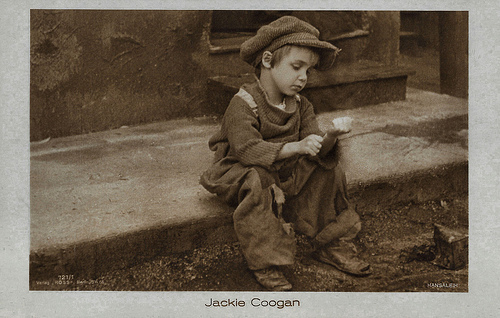
German postcard by Ross Verlag, no. 721/1. Photo: Hansaleih. Publicity still for The Kid (Charles Chaplin, 1921) with Jackie Coogan.
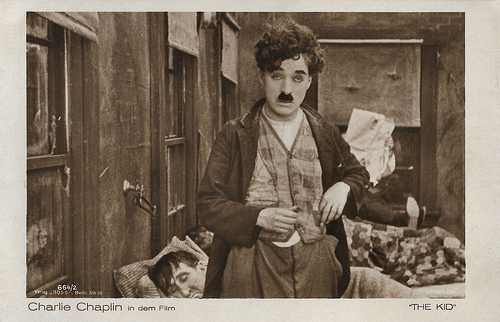
German postcard by Ross Verlag, no. 664/2. Photo: Hansaleih. Publicity still for The Kid (Charles Chaplin, 1921) with Charlie Chaplin .
Abandonned in the back seat of an expensive automobile
The Kid (Charles Chaplin, 1921) starts off with inter-titles, "A picture with a smile - and perhaps a tear," followed by "The woman whose sin was motherhood". An unknown woman (Edna Purviance) leaves a charity hospital carrying her newborn son. An artist (Carl Miller), the apparent father, is shown with the woman's photograph. When it falls into the fireplace, he first picks it up, then throws it back in to burn up.
The woman decides to abandon her child in the back seat of an expensive automobile with a handwritten note imploring the finder to care for and love the baby. However, the car is stolen. When the two thieves discover the child, they dump him in a garbage can on the street.
The Tramp ( Charlie Chaplin ) notices the baby wrapped in a blanket. First, Charlie tries to pass it off to someone else, but after stumbling upon a note which reads, "Please love and care for this orphan child", he decides to raise the child himself. He names the boy John. Elsewhere, the woman has an apparent change of heart and returns for the baby, but is heartbroken and faints upon learning of the baby having been taken away.
Five years pass, and the child (Jackie Coogan) becomes the Tramp's partner in minor crime, throwing stones to break windows that the Tramp, working as a glazier, can then repair. Meanwhile, the woman becomes a wealthy opera star. She spends her spare time with charitable work handing out gifts to the children of poor districts to fill the void left by her missing child. By chance, the paths of the kid and his mother meet on numerous occasions, unaware of each other's identities.
When the boy becomes seriously ill, a middle-aged country doctor comes to see him. He discovers that the Tramp is not the boy's father. The Tramp shows him the note left by the mother, but the doctor merely takes it and notifies the authorities of the County Orphan Asylum to take the child away.
Two men come to take the boy to the orphanage, but after a fight and a chase, the Tramp steals the boy back just before he arrives at the Orphan Asylum. When the woman comes back to see how the boy is doing, the doctor tells her what has happened, then shows her the note, which she recognises.
Now fugitives, the Tramp and the boy spend the night in a flophouse, but the manager (Henry Bergman), having read of the $1,000 reward offered for the child, takes him to the police station to be united with his ecstatic mother. When the Tramp wakes up, he searches frantically for the missing boy, then returns to doze beside the now-locked doorway to their humble home.
In his sleep, he enters 'Dreamland', with angels in residence and devilish interlopers. He is awakened by a kind policeman (Tom Wilson), who places the Tramp in a car and rides with him to a mansion. When the door opens, the woman and John emerge, reuniting the elated adoptive father and son. The policeman, who is happy for the family, shakes the Tramp's hand and leaves, before the woman welcomes the Tramp into her home.
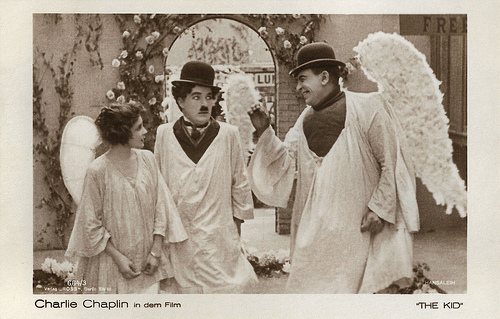
German postcard by Ross Verlag, no. 664/3. Photo: Hansaleih. Publicity still for The Kid (Charles Chaplin, 1921) with Charlie Chaplin , Lita Grey and Charles Reisner.
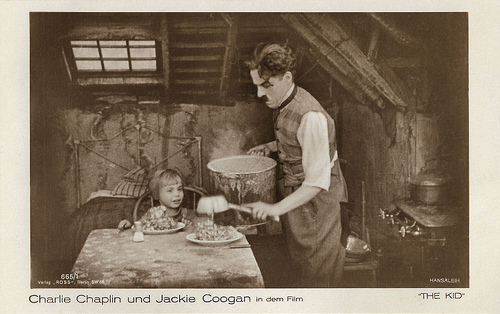
German postcard by Ross Verlag, no. 665/1. Photo: Hansaleih. Publicity still for The Kid (Charles Chaplin, 1921) with Charlie Chaplin and Jackie Coogan.
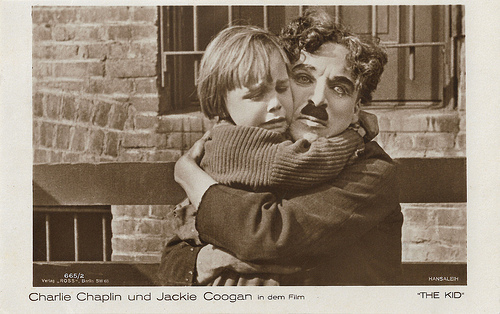
German postcard by Ross Verlag, no. 665/2. Photo: Hansaleih. Publicity still for The Kid (Charles Chaplin, 1921) with Charlie Chaplin and Jackie Coogan.
The first major child star of the cinema
The Kid (Charles Chaplin, 1921) is notable for combining comedy and drama. As the opening title says: "A picture with a smile—and perhaps, a tear". The most famous and enduring sequence in the film is the Tramp's desperate rooftop pursuit of the agents from the orphanage who had taken the child, and their emotional reunion.
The film made Jackie Coogan, then a vaudeville performer, into the first major child star of the cinema. Many of the Chaplin biographers have attributed the relationship portrayed in the film to have resulted from the death of Chaplin's firstborn infant son just ten days before the production began.
J. Spurlin at IMDb : "Jackie Coogan (about five in this film), with his charming manners, his talents as a mimic and his adeptness at physical comedy, is one of the all-time great child actors. Want more evidence of Chaplin's genius? Coogan doesn't steal the film from him. This is true even though Chaplin, as producer, star and director, makes every evident attempt to spotlight the boy's talents. Coogan is even better here than he is in his own vehicles, like My Boy and Oliver Twist."
The portrayal of poverty and the cruelty of welfare workers are also directly reminiscent of Chaplin's own childhood in London. Several of the street scenes were filmed on Los Angeles's famed Olvera Street, almost 10 years before it was converted into a Mexican-themed tourist attraction.
Another IMDb reviewer, Lugonian, notes: "Chaplin, who constructs his gags to perfection, has one difficult scene that comes off naturally, this being where Charlie cuts out diapers from a sheet for the infant as he's lying beside him in a miniature hammock crying out for his milk. The baby immediately stops after Charlie directs the nipple attached to a coffee pot (a substitute for a baby bottle) back into his mouth. Another classic moment, on a serious nature, is when Charlie is being held back by authorities, being forced to watch his crying 'son' taken away from him. Charlie breaks away and goes after the truck as he's being chased by a policeman from the slanted roof-tops. The close-up where father and son tearful reunite is as touching as anything ever captured on film."
After production was completed in 1920, the film was caught up in the divorce actions of Chaplin's first wife Mildred Harris, who sought to attach Chaplin's assets. Chaplin and his associates smuggled the raw negative to Salt Lake City, reportedly packed in coffee cans, and edited the film in a room at the Hotel Utah. Before releasing the film Charlie Chaplin negotiated for and received an enhanced financial deal for the film with his distributor, First National Corporation, based on the success of the final film. Twelve-year-old Lita Grey, who portrays an angel in the film, would become Chaplin's second wife from 1924 to 1927.
In 1971, Charles Chaplin edited and reissued the film and he composed a new musical score.
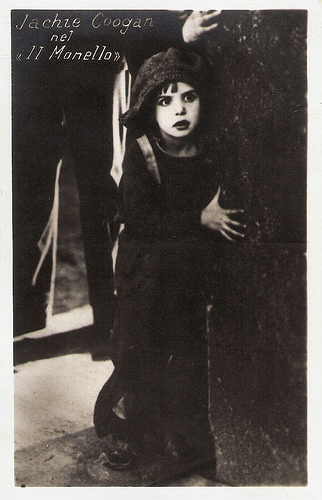
Italian postcard. Photo: publicity still for The Kid (Charles Chaplin, 1921) with Jackie Coogan.
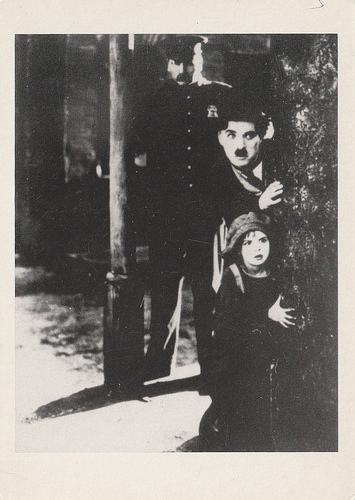
Postcard by Palm Pictures, no. C 23. Photo: publicity still for The Kid (Charles Chaplin, 1921) with Charlie Chaplin and Jackie Coogan. Collection: Daniël van der Aa. Tom Wilson is probably the cop in the background.
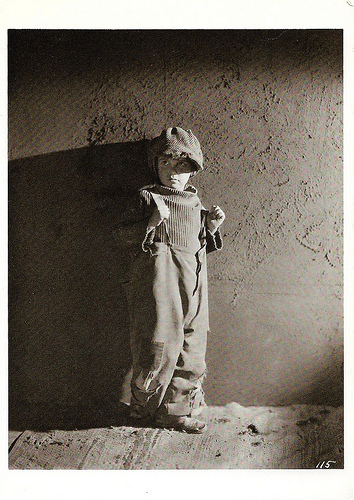
Jackie Coogan. Modern American postcard by Fotofolio. Photo: James Abbe, 1921.
Sources: J. Spurlin (IMDb), Lugonian (IMDb), Wikipedia and IMDb.

German postcard by Ross Verlag, no. 721/1. Photo: Hansaleih. Publicity still for The Kid (Charles Chaplin, 1921) with Jackie Coogan.

German postcard by Ross Verlag, no. 664/2. Photo: Hansaleih. Publicity still for The Kid (Charles Chaplin, 1921) with Charlie Chaplin .
Abandonned in the back seat of an expensive automobile
The Kid (Charles Chaplin, 1921) starts off with inter-titles, "A picture with a smile - and perhaps a tear," followed by "The woman whose sin was motherhood". An unknown woman (Edna Purviance) leaves a charity hospital carrying her newborn son. An artist (Carl Miller), the apparent father, is shown with the woman's photograph. When it falls into the fireplace, he first picks it up, then throws it back in to burn up.
The woman decides to abandon her child in the back seat of an expensive automobile with a handwritten note imploring the finder to care for and love the baby. However, the car is stolen. When the two thieves discover the child, they dump him in a garbage can on the street.
The Tramp ( Charlie Chaplin ) notices the baby wrapped in a blanket. First, Charlie tries to pass it off to someone else, but after stumbling upon a note which reads, "Please love and care for this orphan child", he decides to raise the child himself. He names the boy John. Elsewhere, the woman has an apparent change of heart and returns for the baby, but is heartbroken and faints upon learning of the baby having been taken away.
Five years pass, and the child (Jackie Coogan) becomes the Tramp's partner in minor crime, throwing stones to break windows that the Tramp, working as a glazier, can then repair. Meanwhile, the woman becomes a wealthy opera star. She spends her spare time with charitable work handing out gifts to the children of poor districts to fill the void left by her missing child. By chance, the paths of the kid and his mother meet on numerous occasions, unaware of each other's identities.
When the boy becomes seriously ill, a middle-aged country doctor comes to see him. He discovers that the Tramp is not the boy's father. The Tramp shows him the note left by the mother, but the doctor merely takes it and notifies the authorities of the County Orphan Asylum to take the child away.
Two men come to take the boy to the orphanage, but after a fight and a chase, the Tramp steals the boy back just before he arrives at the Orphan Asylum. When the woman comes back to see how the boy is doing, the doctor tells her what has happened, then shows her the note, which she recognises.
Now fugitives, the Tramp and the boy spend the night in a flophouse, but the manager (Henry Bergman), having read of the $1,000 reward offered for the child, takes him to the police station to be united with his ecstatic mother. When the Tramp wakes up, he searches frantically for the missing boy, then returns to doze beside the now-locked doorway to their humble home.
In his sleep, he enters 'Dreamland', with angels in residence and devilish interlopers. He is awakened by a kind policeman (Tom Wilson), who places the Tramp in a car and rides with him to a mansion. When the door opens, the woman and John emerge, reuniting the elated adoptive father and son. The policeman, who is happy for the family, shakes the Tramp's hand and leaves, before the woman welcomes the Tramp into her home.

German postcard by Ross Verlag, no. 664/3. Photo: Hansaleih. Publicity still for The Kid (Charles Chaplin, 1921) with Charlie Chaplin , Lita Grey and Charles Reisner.

German postcard by Ross Verlag, no. 665/1. Photo: Hansaleih. Publicity still for The Kid (Charles Chaplin, 1921) with Charlie Chaplin and Jackie Coogan.

German postcard by Ross Verlag, no. 665/2. Photo: Hansaleih. Publicity still for The Kid (Charles Chaplin, 1921) with Charlie Chaplin and Jackie Coogan.
The first major child star of the cinema
The Kid (Charles Chaplin, 1921) is notable for combining comedy and drama. As the opening title says: "A picture with a smile—and perhaps, a tear". The most famous and enduring sequence in the film is the Tramp's desperate rooftop pursuit of the agents from the orphanage who had taken the child, and their emotional reunion.
The film made Jackie Coogan, then a vaudeville performer, into the first major child star of the cinema. Many of the Chaplin biographers have attributed the relationship portrayed in the film to have resulted from the death of Chaplin's firstborn infant son just ten days before the production began.
J. Spurlin at IMDb : "Jackie Coogan (about five in this film), with his charming manners, his talents as a mimic and his adeptness at physical comedy, is one of the all-time great child actors. Want more evidence of Chaplin's genius? Coogan doesn't steal the film from him. This is true even though Chaplin, as producer, star and director, makes every evident attempt to spotlight the boy's talents. Coogan is even better here than he is in his own vehicles, like My Boy and Oliver Twist."
The portrayal of poverty and the cruelty of welfare workers are also directly reminiscent of Chaplin's own childhood in London. Several of the street scenes were filmed on Los Angeles's famed Olvera Street, almost 10 years before it was converted into a Mexican-themed tourist attraction.
Another IMDb reviewer, Lugonian, notes: "Chaplin, who constructs his gags to perfection, has one difficult scene that comes off naturally, this being where Charlie cuts out diapers from a sheet for the infant as he's lying beside him in a miniature hammock crying out for his milk. The baby immediately stops after Charlie directs the nipple attached to a coffee pot (a substitute for a baby bottle) back into his mouth. Another classic moment, on a serious nature, is when Charlie is being held back by authorities, being forced to watch his crying 'son' taken away from him. Charlie breaks away and goes after the truck as he's being chased by a policeman from the slanted roof-tops. The close-up where father and son tearful reunite is as touching as anything ever captured on film."
After production was completed in 1920, the film was caught up in the divorce actions of Chaplin's first wife Mildred Harris, who sought to attach Chaplin's assets. Chaplin and his associates smuggled the raw negative to Salt Lake City, reportedly packed in coffee cans, and edited the film in a room at the Hotel Utah. Before releasing the film Charlie Chaplin negotiated for and received an enhanced financial deal for the film with his distributor, First National Corporation, based on the success of the final film. Twelve-year-old Lita Grey, who portrays an angel in the film, would become Chaplin's second wife from 1924 to 1927.
In 1971, Charles Chaplin edited and reissued the film and he composed a new musical score.

Italian postcard. Photo: publicity still for The Kid (Charles Chaplin, 1921) with Jackie Coogan.

Postcard by Palm Pictures, no. C 23. Photo: publicity still for The Kid (Charles Chaplin, 1921) with Charlie Chaplin and Jackie Coogan. Collection: Daniël van der Aa. Tom Wilson is probably the cop in the background.

Jackie Coogan. Modern American postcard by Fotofolio. Photo: James Abbe, 1921.
Sources: J. Spurlin (IMDb), Lugonian (IMDb), Wikipedia and IMDb.
Published on April 03, 2019 22:00
April 2, 2019
Zopf und Schwert (1926)
The 'Prussian films' on Frederick the Great were a huge success in Weimar. The Aafa Film company decided to produce also a film set at the court of 18th century Prussia: Zopf und Schwert/Braid and Sword (Victor Janson, 1926). It starred Mady Christians as Princess Wilhelmine - Frederick's sister, William Dieterle as her lover, the Prince of Bayreuth, Hanni Weisse as the Princess's lady-in-waiting Von Sonnsfeld, and Albert Steinrück as King Frederick Willliam I of Prussia.
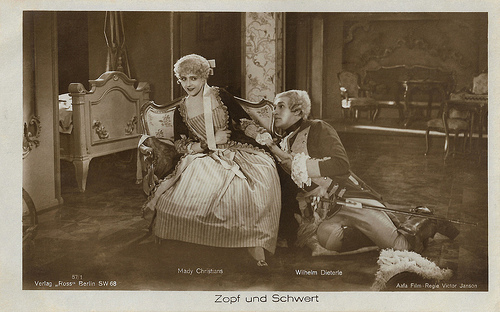
German postcard by Ross Verlag, no. 57/1. Photo: Aafa Film. Mady Christians and Wilhelm (William) Dieterle in Zopf und Schwert - Die tolle Prinzessin (Victor Janson, 1926).

German postcard by Ross Verlag, no. 57/2. Photo: Aafa Film. Mady Christians, Hanni Weisse and Theodor Loos in Zopf und Schwert - Die tolle Prinzessin (Victor Janson, 1926).
A Princess locked up in her rooms and threatened to death
Zopf und Schwert is a romantic comedy, based on the stage play (1843) by Karl Gutzkow. The exact plot of the (lost) film is unknown but the stage play creates a fictitious love story between Prince Frederick of Brandenburg-Bayreuth (1711-1763) and Princess Wilhelmine (1709–1758), daughter of King Frederick Wilhelm I of Prussia and sister of the future Frederick the Great.
The story takes place after 1730, when, historically, the stern, army loving King had punished his son with exile to Küstrin (now the Polish Kostrzyn nad Odrą) after the latter had tried to flee to France, fed up with his father's brutal behaviour. Frederick's aid Katte was decapitated before his eyes. Wilhelmine, considered part of the Crown Prince's 'desertion', was locked up in her rooms. Both brother and sister had been threatened with death.
While the Queen wanted to marry Wilhelmine with a British royal, her father wanted an alliance with Habsburg, but nothing came of it. In 1731 Wilhelmine married Frederick of Brandenburg-Bayreuth, future Margrave, who initially was betrothed to Wilhelmine's younger sister, but their father at the last moment shifted daughters, even without asking the groom.
Wilhelmine was forced into the marriage by her father and thus hoped to relieve the conflict between the King and the Crown Prince. When the Margrave got into his inheritance, the couple turned Bayreuth in a little Versailles. Their building activities, rebuilding the residence and the opera house, and building a new opera, a theatre, a palace and an university, almost bankrupted the principality. The couple had only one daughter, who died young.

German postcard by Ross Verlag, no. 57/3, Photo: Aafa Film. Mady Christians and Wilhelm Dieterle in Zopf und Schwert - Die tolle Prinzessin (Victor Janson, 1926).
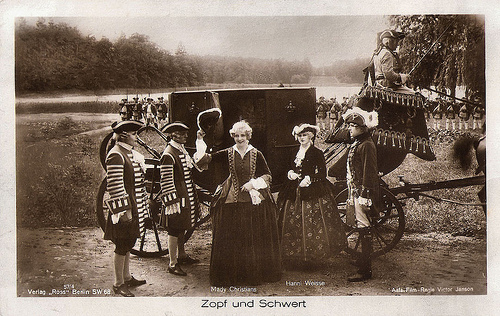
German postcard by Ross Verlag, no. 57/4. Photo: Aafa Film. Publicity still of Mady Christians and Hanni Weisse in Zopf und Schwert - Die tolle Prinzessin/Braid and sword (Victor Janson, 1926).
A less calculating and horrifying situation
In Karl Gutzkow's stage play, the situation is presented as less calculating and horrifying. The Prince of Bayreuth ( Wilhelm Dieterle ), who is a close friend of and go-between for the exiled Crown Prince Frederick (Walter Janssen), visits the Prussian court and falls in love with Wilhelmine ( Mady Christians ).
The Queen (Julia Serda), related to the British King, orders him to mediate with her husband (Albert Steinrück) in marrying off her daughter with the Prince of Wales. The King, who officially wants to marry her to Habsburg, confesses Bayreuth he agrees with the British marriage and orders him to throw a huge party.
Moreover, Bayreuth happens to know the British envoy Hotham (Robert Scholtz) from his time in England, and hears from him a Prussian-British trade contract is behind all this. Bayreuth betrays all this to Wilhelmine and declares her his own love.
With help of her lady-in-waiting Sonnsfeld ( Hanni Weisse ), Wilhelmine masks as an unknown white lady and tries to escape her rooms. Sonnsfeld seduces the guard Eckhoff ( Theodor Loos ), who happens to be an amateur violin player, to play for them so they can dance, despite the King's disgust of music and dance.
The King surprises them, degrades the officer to stage player (which he doesn't mind), orders Sonnsfeld to move to another court (which she doesn't mind), and announces his daughter her future marriage.
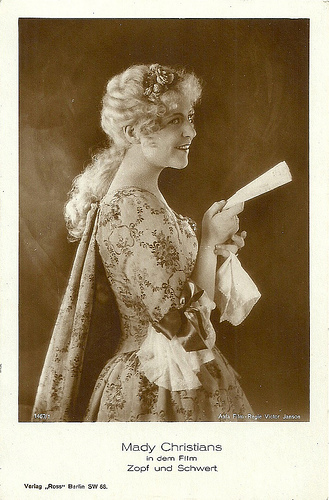
German postcard by Ross Verlag, no. 1467/1. Photo: Aafa Film. Mady Christians in Zopf und Schwert - Die tolle Prinzessin (Victor Janson, 1926).
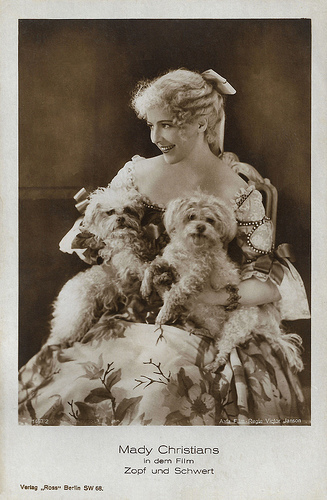
German postcard by Ross Verlag, no. 1467/2. Photo: Aafa Film. Mady Christians in Zopf und Schwert - Die tolle Prinzessin (Victor Janson, 1926).
A secret rendez-vous
When the King hears the British want to restore the earlier free trade between the two nations, he explodes. He immediately orders Bayreuth to go to Vienna to arrange a marriage with Habsburg.
Hotham, in reality, is only helping Bayreuth by discrediting his own employer. Hotham and the King battle over the failed affair but peace is made over beer and tobacco, with Bayreuth present as well.
However, at the smoking table with all the King's men, and forced to talk, Bayreuth gently but critically creates the King's doubt whether he has thought of the hearts of his children in his deeds and arrangements.
When the King, masked in a white domino, surprises the Queen and her ladies-in-waiting in card plays with money and drinking forbidden teas and coffees, a mysterious lady in white appears, who happens to be Wilhelmine, helped to escape from her rooms by her mother. She confesses she has had a secret rendez-vous with the Prince of Wales.
Just when the King threatens to divorce because of this affront, Hotham appears telling that the Prince of Wales has fled after Bayreuth challenged him to a duel, because he loved the princess too (it is all a scam by Hotham, as the real Prince of Wales was never around, only his rumour). Finally, King and Queen agree with the marriage of their daughter to Bayreuth, even more so as their future son-in-law has announced he will join the Prussian army.
Zopf und Schwert (Victor Janson, 1926) was scripted by Jane Bess and Adolf Lantz, the cinematography was by Carl Drews, sets and costumes were designed by Ernst Stern. Rudolf Dworsky was the producer. The film premiered in Berlin on 26 August 1926. 'Zopf' in the title refers to the braid of a wig Prussian officers wore then, 'Schwert' clearly refers to their swords.
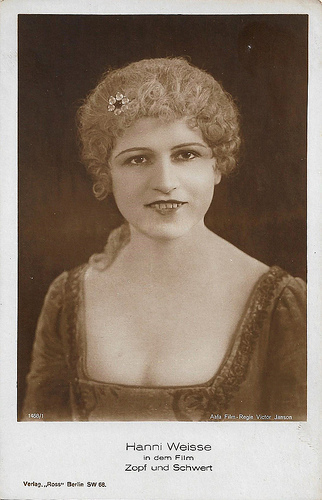
German postcard by Ross Verlag, no. 1468/1. Photo: Aafa Film. Hanni Weisse in Zopf und Schwert - Die tolle Prinzessin (Victor Janson, 1926).
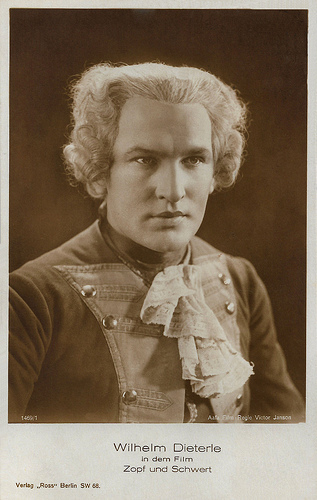
German postcard by Ross Verlag, no. 1469/1, 1927-1928. Photo: Aafa Film. Wilhelm Dieterle in Zopf und Schwert - Die tolle Prinzessin (Victor Janson, 1926).
Sources: Wikipedia and IMDb.

German postcard by Ross Verlag, no. 57/1. Photo: Aafa Film. Mady Christians and Wilhelm (William) Dieterle in Zopf und Schwert - Die tolle Prinzessin (Victor Janson, 1926).

German postcard by Ross Verlag, no. 57/2. Photo: Aafa Film. Mady Christians, Hanni Weisse and Theodor Loos in Zopf und Schwert - Die tolle Prinzessin (Victor Janson, 1926).
A Princess locked up in her rooms and threatened to death
Zopf und Schwert is a romantic comedy, based on the stage play (1843) by Karl Gutzkow. The exact plot of the (lost) film is unknown but the stage play creates a fictitious love story between Prince Frederick of Brandenburg-Bayreuth (1711-1763) and Princess Wilhelmine (1709–1758), daughter of King Frederick Wilhelm I of Prussia and sister of the future Frederick the Great.
The story takes place after 1730, when, historically, the stern, army loving King had punished his son with exile to Küstrin (now the Polish Kostrzyn nad Odrą) after the latter had tried to flee to France, fed up with his father's brutal behaviour. Frederick's aid Katte was decapitated before his eyes. Wilhelmine, considered part of the Crown Prince's 'desertion', was locked up in her rooms. Both brother and sister had been threatened with death.
While the Queen wanted to marry Wilhelmine with a British royal, her father wanted an alliance with Habsburg, but nothing came of it. In 1731 Wilhelmine married Frederick of Brandenburg-Bayreuth, future Margrave, who initially was betrothed to Wilhelmine's younger sister, but their father at the last moment shifted daughters, even without asking the groom.
Wilhelmine was forced into the marriage by her father and thus hoped to relieve the conflict between the King and the Crown Prince. When the Margrave got into his inheritance, the couple turned Bayreuth in a little Versailles. Their building activities, rebuilding the residence and the opera house, and building a new opera, a theatre, a palace and an university, almost bankrupted the principality. The couple had only one daughter, who died young.

German postcard by Ross Verlag, no. 57/3, Photo: Aafa Film. Mady Christians and Wilhelm Dieterle in Zopf und Schwert - Die tolle Prinzessin (Victor Janson, 1926).

German postcard by Ross Verlag, no. 57/4. Photo: Aafa Film. Publicity still of Mady Christians and Hanni Weisse in Zopf und Schwert - Die tolle Prinzessin/Braid and sword (Victor Janson, 1926).
A less calculating and horrifying situation
In Karl Gutzkow's stage play, the situation is presented as less calculating and horrifying. The Prince of Bayreuth ( Wilhelm Dieterle ), who is a close friend of and go-between for the exiled Crown Prince Frederick (Walter Janssen), visits the Prussian court and falls in love with Wilhelmine ( Mady Christians ).
The Queen (Julia Serda), related to the British King, orders him to mediate with her husband (Albert Steinrück) in marrying off her daughter with the Prince of Wales. The King, who officially wants to marry her to Habsburg, confesses Bayreuth he agrees with the British marriage and orders him to throw a huge party.
Moreover, Bayreuth happens to know the British envoy Hotham (Robert Scholtz) from his time in England, and hears from him a Prussian-British trade contract is behind all this. Bayreuth betrays all this to Wilhelmine and declares her his own love.
With help of her lady-in-waiting Sonnsfeld ( Hanni Weisse ), Wilhelmine masks as an unknown white lady and tries to escape her rooms. Sonnsfeld seduces the guard Eckhoff ( Theodor Loos ), who happens to be an amateur violin player, to play for them so they can dance, despite the King's disgust of music and dance.
The King surprises them, degrades the officer to stage player (which he doesn't mind), orders Sonnsfeld to move to another court (which she doesn't mind), and announces his daughter her future marriage.

German postcard by Ross Verlag, no. 1467/1. Photo: Aafa Film. Mady Christians in Zopf und Schwert - Die tolle Prinzessin (Victor Janson, 1926).

German postcard by Ross Verlag, no. 1467/2. Photo: Aafa Film. Mady Christians in Zopf und Schwert - Die tolle Prinzessin (Victor Janson, 1926).
A secret rendez-vous
When the King hears the British want to restore the earlier free trade between the two nations, he explodes. He immediately orders Bayreuth to go to Vienna to arrange a marriage with Habsburg.
Hotham, in reality, is only helping Bayreuth by discrediting his own employer. Hotham and the King battle over the failed affair but peace is made over beer and tobacco, with Bayreuth present as well.
However, at the smoking table with all the King's men, and forced to talk, Bayreuth gently but critically creates the King's doubt whether he has thought of the hearts of his children in his deeds and arrangements.
When the King, masked in a white domino, surprises the Queen and her ladies-in-waiting in card plays with money and drinking forbidden teas and coffees, a mysterious lady in white appears, who happens to be Wilhelmine, helped to escape from her rooms by her mother. She confesses she has had a secret rendez-vous with the Prince of Wales.
Just when the King threatens to divorce because of this affront, Hotham appears telling that the Prince of Wales has fled after Bayreuth challenged him to a duel, because he loved the princess too (it is all a scam by Hotham, as the real Prince of Wales was never around, only his rumour). Finally, King and Queen agree with the marriage of their daughter to Bayreuth, even more so as their future son-in-law has announced he will join the Prussian army.
Zopf und Schwert (Victor Janson, 1926) was scripted by Jane Bess and Adolf Lantz, the cinematography was by Carl Drews, sets and costumes were designed by Ernst Stern. Rudolf Dworsky was the producer. The film premiered in Berlin on 26 August 1926. 'Zopf' in the title refers to the braid of a wig Prussian officers wore then, 'Schwert' clearly refers to their swords.

German postcard by Ross Verlag, no. 1468/1. Photo: Aafa Film. Hanni Weisse in Zopf und Schwert - Die tolle Prinzessin (Victor Janson, 1926).

German postcard by Ross Verlag, no. 1469/1, 1927-1928. Photo: Aafa Film. Wilhelm Dieterle in Zopf und Schwert - Die tolle Prinzessin (Victor Janson, 1926).
Sources: Wikipedia and IMDb.
Published on April 02, 2019 22:00
Paul van Yperen's Blog
- Paul van Yperen's profile
- 13 followers
Paul van Yperen isn't a Goodreads Author
(yet),
but they
do have a blog,
so here are some recent posts imported from
their feed.



